Architect Cover Letter Example (W/ Full Guide for 2024)

You know how to design buildings that are both functional and stunning—your portfolio says it all.
But when it comes to drafting a cover letter, it's like hitting a creative wall. Suddenly, words fail you, and all you see is a blank screen staring back.
Don't worry, you're not alone.
Many skilled architects stumble when they have to put pen to paper—or fingers to keyboard—in a way that's not about blueprints and 3D models.
We've got you covered!
In this article, we're going to lay the foundation for an unbeatable architect cover letter.
Here’s what we’ll cover:
- What a Stunning Architect Cover Letter Looks Like
- 5 Steps to Writing a Job-Winning Architect Cover Letter
- 3 Essential Architect Cover Letter Tips
Ready to build a cover letter that's as impressive as your architectural designs?
Let's dive in!

Architect Cover Letter Example

5 Steps for the Perfect Architecture Cover Letter
You've just seen what a job-winning architect cover letter looks like, and now it's your turn to make one .
To get it right, follow these steps:
#1. Put Contact Information in the Header
Start your architecture cover letter with your contact details right at the top, in the header. It's the same layout you'd use on your resume , so it keeps things consistent.
Here's what to include:
- Full Name. Put your full name at the top of the page.
- Job Title. Make sure the job title on your cover letter matches the exact position you're applying for. Hiring managers tend to juggle applications for various roles at once, so be specific on your application.
- Email Address. Use an email that's easy to remember and professional. For example, swap out immature emails like "[email protected]" for something based on your full name, like “[email protected]” .
- Phone Number. Double-check your phone number, since a typo could mean a missed opportunity. If you're applying internationally, include the dialing code.
- Location. Your city and state or country are usually enough. If you're applying for a remote job or planning to move for this one, say so in your cover letter.
- Relevant Links (Optional). As an architect, we recommend you add links to your portfolio and LinkedIn profile so the hiring manager can quickly see your past work.
Once your own details are in place, add the hiring manager's contact information underneath.
Here’s what to include:
- Company Name. Write down the name of the firm you're applying to.
- Hiring Manager's Name. Do some digging to find out who will be reading your cover letter and address it to them. For example, look at the job ad, the company website, or their LinkedIn job post.
- Hiring Manager's Title. If you find out that the person doing the hiring is the lead architect, use their official title in your cover letter.
- Location. Include the city and state/country of the company. This is especially important for international companies. If the company has more than one office in the same city, you can also specify the street address.
- Date of Writing (Optional). Adding the date you wrote the cover letter gives it a professional touch.
#2. Address the Hiring Manager
Once you've got all your contact information sorted, it's time to address your cover letter to its intended reader — and skip the tired "To Whom It May Concern."
How you start your letter can set the tone and make a strong first impression.
First things first—do a little homework. Browse the job ad, the company's website, or LinkedIn to find out who’s the hiring manager for the architecture role you're eyeing. Their name should be listed on the ad.
Then go ahead and address them respectfully. Using "Ms." or "Mr." followed by their last name is a solid choice. If you're unsure about their gender or marital status, using their full name works fine too.
- Dear Mr. Johnson,
- Dear Emily Johnson,
If you come up empty searching for the hiring manager or department head, no worries. You can address your letter at the department or the company as a whole.
- Dear Architecture Department,
- Dear Hiring Team for Architecture,
- Dear Human Resources Team,
- Dear Head of Architecture,
#3. Write an Eye-Catching Opening Statement
Hiring managers often spend just a few seconds scanning each application. So, nailing the introduction in your architect cover letter is key.
Start your architecture cover letter by stating why you’re writing and why this specific role caught your eye. Expressing genuine interest in the field or the job itself can spark curiosity and make the hiring manager want to read on.
Doing a bit of research about the company can also set you apart from the crowd. The more you understand the company culture, the better you can explain why you’d be a great fit. It shows the hiring manager that you didn't just send out mass applications; you’re genuinely keen on this job.
If you have some experience under your belt, kick off your cover letter with a standout achievement or skill that matches the role perfectly. Keep it brief, though. The goal here is to intrigue the hiring manager just enough to get them to read the rest of your letter.
#4. Use the Cover Letter Body for the Details
The core section of your architecture cover letter should really dig into what makes you the right choice.
The trick here is not to just rehash your architect resume ; this is your chance to elaborate on your skills and show how you can contribute to your future employer.
Make sure to point out some of your most notable achievements related to the field. For example, maybe you played a key role in a sustainable housing project or helped design a community center that won awards. Use the job ad as your guide to tailor these to what the company is looking for.
For example, if the company specializes in green building design, emphasize your experience or skills in sustainability and eco-conscious construction. If they're all about cutting-edge, tech-savvy projects, highlight your familiarity with the latest design software.
It's always good to show that you know about the company. Are you drawn to their innovative approach to urban design, or do you deeply respect their commitment to local communities? Mention it in your cover letter. It shows you're not just tossing applications to the wind—you genuinely want this job at this firm.
If you have an employment gap on your resume , the body of your cover letter is the right place to explain it. Did you take some time off work to travel abroad? Tell the hiring manager how it benefited you and how you came back inspired to work as an architect.
And while you’re at it, let your enthusiasm shine through. Make it clear you're excited about the prospect of contributing to the company with your unique skills and perspective.
Also, make sure to avoid these common cover letter mistakes at all costs!
#5. Wrap It Up and Sign It
Your cover letter ending is like adding the final touch to your architectural blueprint.
It's vital to leave the hiring manager with a good impression and make them remember your enthusiasm and expertise long after they've put your cover letter down.
Your conclusion is your final opportunity to underline your distinct architectural prowess and re-emphasize why you're the ideal fit for the role. You want to make sure this final paragraph affirms everything your cover letter has built up so far.
Once you've reiterated your strong points and relevant skills, invite the hiring manager to further discuss your application. A direct, clear call to action can be what takes you to the next stage of the hiring process.
Finally, it’s time to close your cover letter on the right note. Here’s a neat way to structure it:
I'd appreciate the opportunity to discuss my portfolio and how I can contribute to your team. Please feel free to reach out to me at the provided email or phone number for further discussions.
Warm regards,
While "Warm regards," has a personal touch, you can also consider these other sign-off options:
- Best wishes,
- With appreciation,
- Looking forward to hearing from you,

3 Essential Architecture Cover Letter Tips
You know the basic steps to writing your architect cover letter, so now it’s time to take it to the next level.
Just use these architect cover letter tips to make your application shine:
#1. Match Your Resume
It goes without saying that your job application should reflect your attention to detail and aesthetic.
That means the design of your cover letter complements your resume. If they don't align, it can come off as messy, unprofessional, and unattentive.
Your details and contact information should sit neatly on the page, and you should use a uniform font and size throughout your cover letter and resume. Remember to set the right margins and line spacing—going over or under the recommended limits can make your cover letter look empty or stretched out.
It's like designing a space—everything needs its perfect spot!
Or Use A Cover Letter Template Instead
Feeling stuck? Here's a quick fix.
Why not use our free resume builder and cover letter templates ?
Both our resume and cover letter templates are crafted with insights from hiring managers worldwide to suit your every need. They save time, meet industry standards, and look fantastic.
Dive in and find a template that matches your resume perfectly!

#2. Mention Skills
Your architect cover letter is the place where you should highlight the most relevant skills that make you a great fit for the job.
Your skills can show the hiring manager what you bring to the table. But don't just throw in a random list of architectural skills and call it a day. Instead, weave your skills into your narrative as a candidate and show them how they make you just the person they’re looking for.
For example, if the ad mentions AutoCAD, highlight your familiarity with the software and how it’s contributed to where you are today. This way, you can paint a clearer picture of your abilities and how they align with the role you're pursuing.
#3. Add Any Relevant Links
Including relevant links in your cover letter is as crucial as having them on your resume. By giving the hiring manager a shortcut to your portfolio or LinkedIn profile , you’re getting them to see your past work as soon as possible.
Even if your resume already has links to your portfolio, personal website, or LinkedIn profile, there’s no reason your cover letter shouldn’t have them too. After all, you don’t want the hiring manager to go back and forth between your cover letter and resume in order to find your portfolio.
Embedding links makes evaluating your application seamless for the hiring manager, and they’re sure to appreciate it.
Key Takeaways
And that’s all there is to writing an architect cover letter!
Now that you’ve seen our architect cover letter example and have the full guide, we’re confident you’ll have a spotless application.
Before you go, let’s do a quick recap:
- Make sure your architect cover letter includes a link to your portfolio so the hiring manager can see your previous projects right after reading your cover letter.
- It’s preferable that your architect cover letter be addressed to the hiring manager. Just do a little bit of digging around the job ad to find out what their name is.
- The body of your cover letter should elaborate on all the architectural skills that make you right for the job. Focus on skills you already have that match the job description.
- Don’t forget to sign your cover letter after writing your conclusion. Just add a call to action and an appropriate closing line, followed by your full name at the bottom.

To provide a safer experience, the best content and great communication, we use cookies. Learn how we use them for non-authenticated users.
5 Professional Architect Cover Letter Examples for 2024
Your architect cover letter should immediately highlight your innovative design skills. Showcase projects that have won accolades or received significant recognition. In the second paragraph, focus on your proficiency with industry-standard software and collaboration tools. It's essential to demonstrate how you effectively communicate and realize visions within a team.
All cover letter examples in this guide
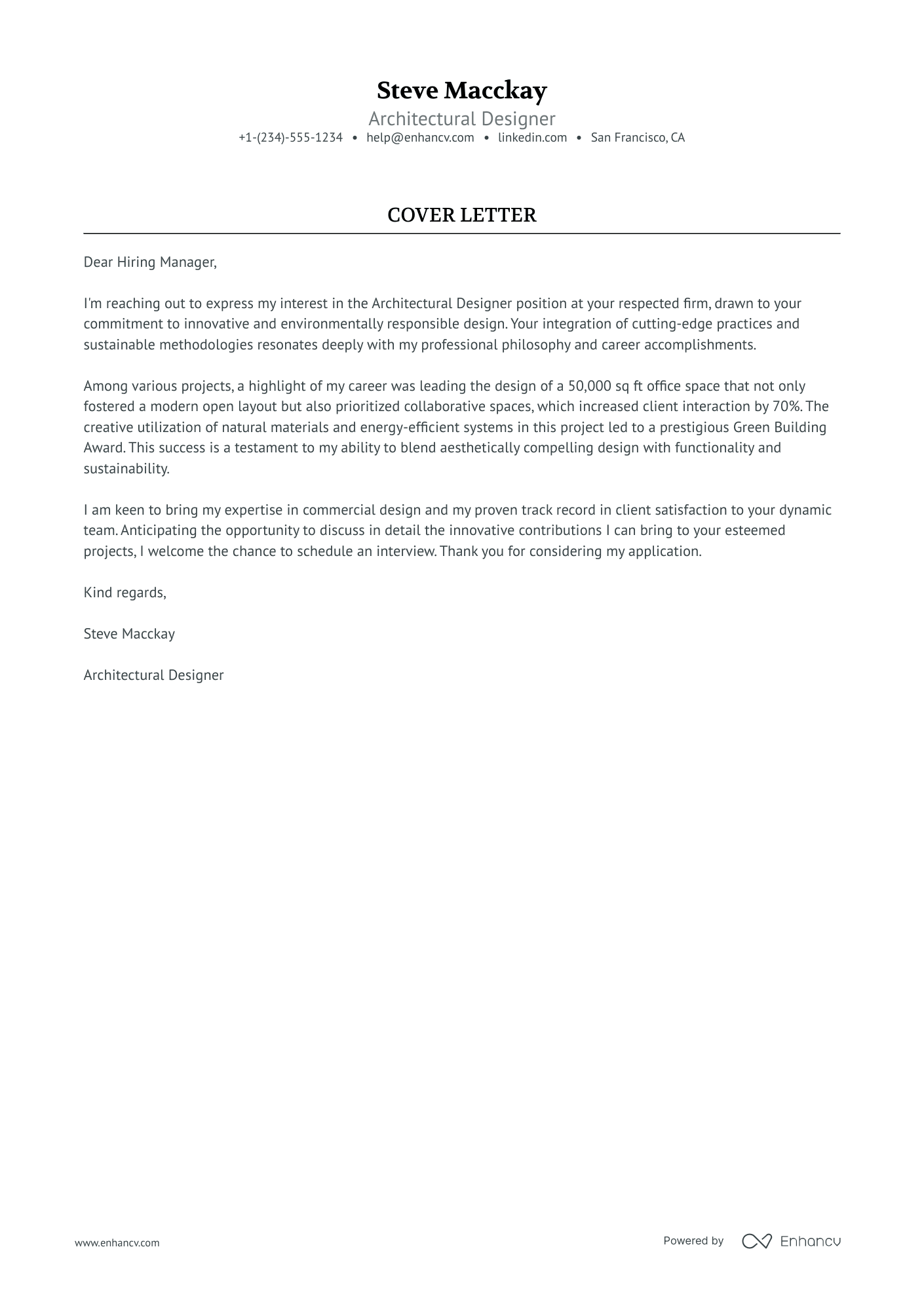
Architectural Designer
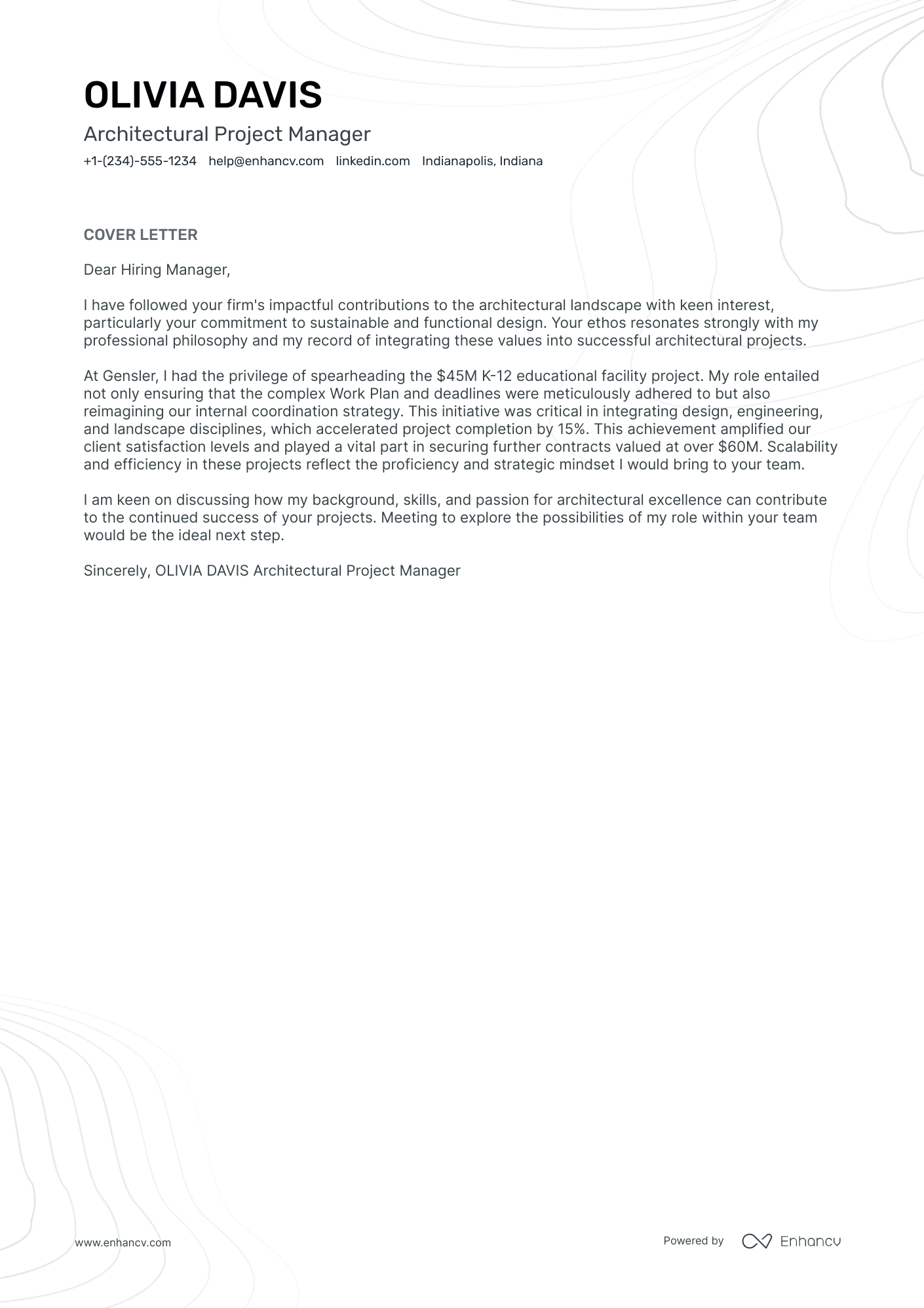
Architectural Project Manager
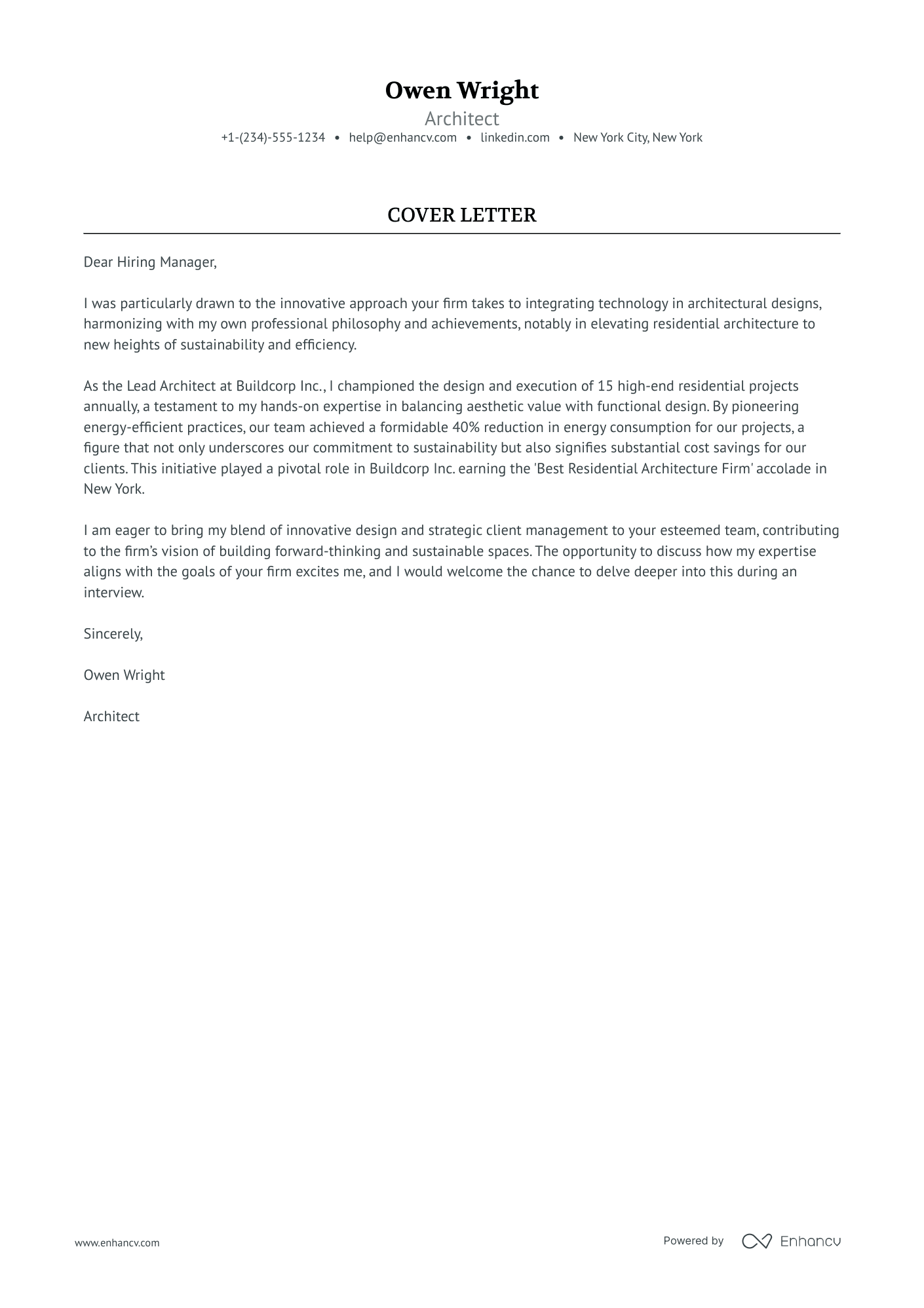
Freelance Architect
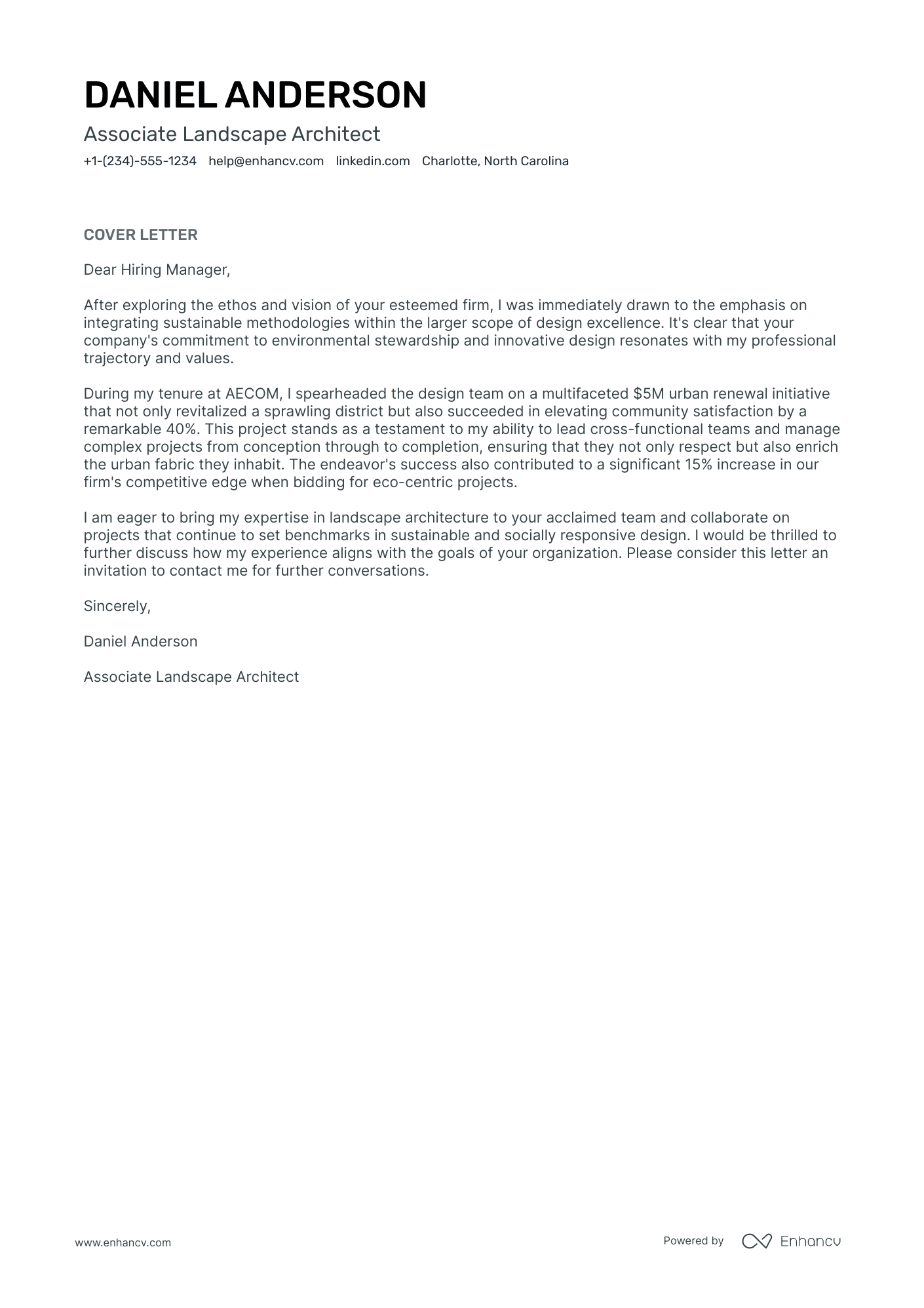
Landscape Architect
Cover letter guide.
Architect Cover Letter Sample
Cover Letter Format
Cover Letter Salutation
Cover Letter Introduction
Cover Letter Body
Cover Letter Closing
No Experience Architect Cover Letter
Key Takeaways

Starting your architect cover letter can feel like drafting a new blueprint: you know it's essential, but where to begin? If you're jumping into the job market, understand your cover letter is not a clone of your resume; it's your chance to narrate your proudest professional achievement. Aim for that sweet spot—formal yet fresh, steering clear of clichés, all while keeping it to one page. Let's lay the foundation for a cover letter that breaks ground and catches attention.
- Write a architect cover letter that helps you stand out (and get the job);
- Understand how to start and end your architect cover letter with the appropriate greeting;
- What to include in the body of your architect cover letter to put your best foot forward;
- Your most important achievements - how to present them as part of your architect cover letter.
And if you want to make your life even easier, simply drag and drop your architect resume into Enhancv's AI cover letter generator, and it will write your cover letter for you in just a few moments.
If the architect isn't exactly the one you're looking for we have a plethora of cover letter examples for jobs like this one:
- Architect resume guide and example
- Aerospace Engineering cover letter example
- Electrical Engineering cover letter example
- Entry Level Mechanical Engineer cover letter example
- Project Engineer cover letter example
- Design Engineer cover letter example
- Civil Engineer cover letter example
- Engineering Project Manager cover letter example
- Engineer In Training cover letter example
- Industrial Engineer cover letter example
- Entry level Civil Engineer cover letter example
Architect cover letter example
Payton Webster
Louisville, CO
+1-(234)-555-1234
- Relevant Experience: Highlighting significant professional achievements, such as leading a $45 million project, showcases the applicant's capacity to manage large-scale developments and conveys a proven track record in the commercial sector.
- Technical Proficiency: Mentioning proficiency in specific software like BIM and Revit aligns with the technological demands of modern architecture firms and signifies that the candidate can seamlessly integrate into the firm’s workflow.
- Leadership and Mentorship: Emphasizing the ability to lead and mentor over 150 professionals indicates strong leadership skills and the potential to contribute to the company's human resource development and team-building efforts.
- Interest in the Firm's Values: Reflecting on the firm's innovative approach and community engagement suggests that the candidate has done thorough research and is genuinely interested in the firm’s ethos, making the applicant a potentially good cultural fit.
Five tips on formatting your architect cover letter
Do you want to make a good impression on recruiters and, at the same time, follow the best industry advice on writing your architect cover letter?
Make sure to include the following:
- Header and Salutation;
- Introductory paragraph;
- Body paragraph;
- Closing paragraph;
- Signature (this one is up to you).
Remember to use the same modern, simple font for your architect cover letter as you did for your resume (e.g. Lato, Rubik, etc.)
Ensure your architect cover letter is single-spaced and is wrapped around a one-inch margin, like in our cover letter templates .
Once completed, use our cover letter builder to export your architect cover letter in the best format to keep your information intact - PDF.
At the end of the day, your architect cover letter won't be assessed by the Applicant Tracker System (ATS) software, but by the recruiters. Your information should thus be legible, organized, and follow a structured logic.
The top sections on a architect cover letter
- Header: Include your name, contact information, and date at the top of your cover letter to ensure the hiring manager knows who you are and how to reach you, which is a professional standard across industries.
- Greeting: Address the letter to a specific person if possible, demonstrating your attention to detail and genuine interest in working for the firm; architects should show that they value personalized and intentional design from the outset.
- Introduction: Briefly mention your architectural education, experience, and passion for the field, as it is crucial to make a strong, relevant first impression that showcases your suitability for the role.
- Professional Experience and Achievements: Detail your most significant professional achievements, projects, and skills related to architecture to provide the recruiter with a clear understanding of your technical expertise and design philosophy.
- Closing and Call to Action: Politely request an interview or further discussion, and express your enthusiasm for contributing to the company's architectural projects, signaling your proactive approach and eagerness to become a part of their team.
Key qualities recruiters search for in a candidate’s cover letter
- Strong design portfolio: Demonstrates innovative thinking and previous experience in creating functional and aesthetically pleasing architectural designs.
- Expertise in industry software: Proficiency in AutoCAD, Revit, SketchUp, and other relevant design and modeling software ensures efficiency and the ability to create detailed plans.
- Knowledge of building codes and regulations: Understanding of local and international building codes, zoning laws, and construction standards is crucial for developing compliant designs.
- Experience with sustainable design: Showcases commitment to environmental consciousness and the ability to incorporate green building practices into projects.
- Excellent project management skills: Ability to oversee a project from conception through to completion, managing timeframes, budgets, and coordinating with clients, engineers, and contractors.
- Strong communication and collaboration abilities: Essential for effectively communicating design ideas, working as part of a multidisciplinary team, and ensuring client needs and visions are met.
How to address hiring managers in your architect cover letter greeting
Goodbye, "Dear Sir/Madam" or "To whom it may concern!"
The salutation of your architect cover letter is how you kick off your professional communication with the hiring managers.
And you want it to start off a bit more personalized and tailored, to catch the recruiters' attention.
Take the time to find out who's recruiting for the role (via LinkedIn or the company page).
If you have previously chatted or emailed the hiring managers, address them on a first or last name basis.
The alternative is a "Dear HR team" or "Dear Hiring Manger", but remember that a "Dear Ms. Simmons" or "Dear Simon," could get you farther ahead than an impersonal greeting.
List of salutations you can use
- Dear Hiring Manager,
- Dear [Company Name] Team,
- Dear Mr./Mrs./Ms. [Last Name],
- Dear [First Name] [Last Name],
- Dear [Professional Title],
- Attention [Company or Department Name],
Introducing your profile to catch recruiters' attention in no more than two sentences
The introduction of your architect cover letter is a whole Catch 22 .
You have an allocated space of no more than just a paragraph (of up to two sentences). With your introduction, you have to stand out and show why you're the best candidate out there.
Set out on a journey with your architect cover letter by focusing on why you're passionate about the job. Match your personal skills and interests to the role.
Another option for your architect cover letter introduction is to show you're the ideal candidate. Write about how your achievements and skills are precisely what the company is looking for.
However you decide to start your architect cover letter, always remember to write about the value you'd bring about. Making it both tangible (with your metrics of success) and highly sought out.
Choosing your best achievement for the middle or body of your architect cover letter
Now that you have the recruiters' attention, it's time to write the chunkiest bit of your architect cover letter .
The body consists of three to six paragraphs that focus on one of your achievements.
Use your past success to tell a story of how you obtained your most job-crucial skills and know-how (make sure to back these up with tangible metrics).
Another excellent idea for your architect cover letter's middle paragraphs is to shine a light on your unique professional value.
Write consistently and make sure to present information that is relevant to the role.
Finishing off your architect cover letter with what matters most
So far, you've done a fantastic job in tailoring your architect cover letter for the role and recruiter.
Your final opportunity to make a good impression is your closing paragraph.
And, no, a "Sincerely yours" just won't do, as it sounds too vague and impersonal.
End your architect cover letter with the future in mind.
So, if you get this opportunity, what do you plan to achieve? Be as specific, as possible, of what value you'd bring to the organization.
You could also thank recruiters for their interest in your profile and prompt for follow-up actions (and organizing your first interview).
Which story should you tell in your architect cover letter when you have zero experience
Candidates, lacking professional experience in the field - this one is for you.
Your architect cover letter is an exercise of integrity, honesty, and, above all, spinning a positive narrative around your strengths.
And what better way to capture recruiters' attention than with your most job-relevant achievement (this could be from your internship or volunteering experience)?
Make sure to back up your success with transferrable skills that are relevant to the job (e.g. how your year, studying abroad, has taught you to be more motivated and handle multicultural environments).
Another safe card you can bet on is your career dream: in the body of your architect cover letter, go into the details of how your ambitions would help make the company you're applying for better.
Key takeaways
Turning your architect cover letter into a success is all about staying authentic to yourself and relevant to the job:
- Be creative with your architect cover letter introduction by stating something you enjoy about the company (that is genuine) or about your skill set (to get the recruiters' interested);
- Use single spacing and have a one-inch margin wrapping all around the content of your architect cover letter;
- Select just one past achievement from your career or life to tell a story of how you've obtained job-crucial skills and how they'd be beneficial to the role;
- The finishing paragraph of your architect cover letter doesn't necessarily have to be a signature but could be a promise of what you plan to achieve in the role;
- Instead of focusing on your lack of experience, spotlight your transferable skills, one relevant achievement, and career dreams.
Architect cover letter examples
Explore additional architect cover letter samples and guides and see what works for your level of experience or role.

Cover letter examples by industry

AI cover letter writer, powered by ChatGPT
Enhancv harnesses the capabilities of ChatGPT to provide a streamlined interface designed specifically focused on composing a compelling cover letter without the hassle of thinking about formatting and wording.
- Content tailored to the job posting you're applying for
- ChatGPT model specifically trained by Enhancv
- Lightning-fast responses

How to Answer "What Motivates You?" Interview Question (With Examples)
How to list a double major on your resume, star resume template, email to send resume: how to build yours [+ template], microsoft word resume templates, how to answer: “what’s the reason for leaving your job”.
- Create Resume
- Terms of Service
- Privacy Policy
- Cookie Preferences
- Resume Examples
- Resume Templates
- AI Resume Builder
- Resume Summary Generator
- Resume Formats
- Resume Checker
- Resume Skills
- How to Write a Resume
- Modern Resume Templates
- Simple Resume Templates
- Cover Letter Builder
- Cover Letter Examples
- Cover Letter Templates
- Cover Letter Formats
- How to Write a Cover Letter
- Resume Guides
- Cover Letter Guides
- Job Interview Guides
- Job Interview Questions
- Career Resources
- Meet our customers
- Career resources
- English (UK)
- French (FR)
- German (DE)
- Spanish (ES)
- Swedish (SE)
© 2024 . All rights reserved.
Made with love by people who care.
- Career Blog
Architecture Cover Letter: 5 Examples and Writing Tips

When it comes to landing a job in the architecture industry, a well-written cover letter can make all the difference. An architecture cover letter acts as a personalized introduction to your resume and serves as an opportunity to highlight your unique skills and experiences.
So, what exactly is an architecture cover letter? Simply put, it is a document that accompanies your resume and showcases your qualifications and passion for the position you are applying for. This type of cover letter goes beyond simply stating your experience; it should also delves into your design philosophy and approach to architecture.
The importance of a well-written architecture cover letter cannot be overstated. Along with providing a glimpse into your personality and work style, a strong cover letter can help set you apart from other candidates. In today’s job market, where competition is fierce, a standout cover letter can increase your chances of landing an interview.
In this article, we will provide five examples of effective architecture cover letters and offer tips on how to make yours stand out. Whether you are an experienced architect or just starting out in your career, these tips and examples will help you create a cover letter that impresses potential employers and showcases your unique skills and experiences.
Research and Preparation
Before crafting your architecture cover letter, it is crucial to take the time to gain a comprehensive understanding of the company and the position you are applying for. This section will discuss the necessary steps to prepare adequately for the application process.
Gathering information about the company and position
It is essential to conduct thorough research about the company you are applying to. This research will help you identify the company’s mission, values, key projects, and goals, which will enable you to tailor your cover letter to highlight your relevance and fit within the company’s objectives.

To gather this information, you can browse through the company website and social media handles, LinkedIn profile, and articles about the company. Additionally, try to identify any informational interviews you can conduct with current or past employees to gain further insight into the company’s culture and work environment.
Analyzing the job description
A job description serves as a blueprint to understand the expectations and requirements from the prospective employee. Therefore, analyzing the job description in detail is vital to craft an effective architecture cover letter.
When scrutinizing the job description, make a note of the educational requirements, necessary skills, personal qualities, and experience required for the role. This information will aid you in explaining how your qualifications, experience, and personality align with the company’s expectations, thereby increasing your chances of securing an interview.
Understanding the company culture and values
To truly stand out from the pool of applicants, you need to showcase your understanding of the company’s culture and values. This can be achieved by examining the language used on the company’s website and social media handles, identifying any employee testimonials or feedback, and researching the company’s mission statement.
A genuine understanding of the company culture and values will reflect your interest in the company and demonstrate your alignment with their objectives. This can help to build a rapport with the decision-makers, making you a more compelling candidate.
Dedicating time to research and preparation is critical when crafting an architecture cover letter. By gathering information about the company and position, analyzing the job description, and understanding the company culture and values, you can create a customized cover letter that stands out from the rest.
Components of a Successful Architecture Cover Letter
Your cover letter is your chance to make a lasting impression on potential employers. A well-crafted cover letter can make the difference between landing your dream job and being overlooked by hiring managers. Here are the three key components that will help you write a successful architecture cover letter:
Opening Statement: Grabbing the Reader’s Attention
Your opening statement should be attention-grabbing and captivating. This is your chance to make a strong first impression and stand out from other applicants. Start with a compelling opening line that showcases your passion for architecture and highlights what makes you different from other candidates.
Body: Showcasing Relevant Experiences and Achievements
In the body of your cover letter, you should showcase your relevant experiences and achievements in the field of architecture. Highlight your skills and expertise, and provide specific examples of projects you have worked on that demonstrate your abilities. This is your chance to show how your past experiences can contribute to the company’s success.
Closing Statement: Call to Action and Expression of Interest
The closing statement of your cover letter should include a call to action and express your interest in the position. Thank the employer for considering your application and offer to provide additional information if needed. Make it clear that you are excited about the opportunity to work for the company and that you look forward to hearing back from them soon.
A successful architecture cover letter includes an attention-grabbing opening statement, a body that showcases relevant experiences and achievements, and a closing statement that includes a call to action and expression of interest in the position. With these key components in mind, you can create a winning cover letter that will help you land your dream job in the field of architecture.
Example 1: Cover Letter for a Junior Architect
Below is an example of a well-written architecture cover letter for a Junior Architect position. This example will be used to provide a breakdown and analysis of each component of the letter.

Full Example
[Your Name] [Address] [City, State ZIP Code] [Email Address] [Today’s Date]
[Hiring Manager’s Name] [Company Name] [Address] [City, State ZIP Code]
Dear Hiring Manager,
I am writing to express my interest in the Junior Architect position at [Company Name]. As a recent graduate of [University Name] with a Bachelor’s degree in Architecture and a passion for design, I believe I am a valuable candidate for the role.
During my time at [University Name], I gained hands-on experience through numerous architecture design projects, both independently and as part of a team. I am proficient in AutoCAD, SketchUp, and Adobe Creative Suite, and have excellent technical drawing skills. Additionally, my excellent communication and collaboration abilities have allowed me to work effectively with team members and clients.
In my previous experience at [Previous Company], I gained valuable experience working on a variety of projects for clients, including commercial buildings and residential homes. This experience has allowed me to develop strong project management and coordination skills, as well as the ability to manage multiple projects simultaneously.
I am excited to join [Company Name] and contribute to the company’s mission of providing innovative architectural solutions. Thank you for considering my application. I look forward to discussing my qualifications further.
Sincerely, [Your Name]
Breakdown and Analysis
This example of a Junior Architect cover letter is well-written and follows a clear structure that is easy to understand. The letter includes the following components:
Header : The header section includes the applicant’s name, address, and contact information, as well as the current date.
Salutation : The salutation section includes the hiring manager’s name, company name, and address.
Introduction : The introduction section starts with a greeting and a statement of interest in the position. The applicant then introduces themselves and their qualifications, which includes their degree and design experience.
Skills and Experience : The skills and experience section elaborates on the applicant’s past education and work experience related to architecture. They mention their proficiency in software and technical drawing skills, as well as their communication and collaboration abilities.
Previous Experience : The previous experience section highlights the applicant’s most recent experience working in the industry. They also mention the importance of project management and coordination skills and their ability to multitask.
Closing : The closing section thanks the hiring manager for considering the applicant’s application and expresses excitement at the opportunity to contribute to the company’s mission.
Example 2: Cover Letter for an Intern Architect
In this section, we will be discussing a full example of a well-written architecture cover letter for an intern position. We will also be analyzing and breaking down each component of the cover letter.
Example Cover Letter:
I am writing to express my interest in the intern architect position advertised on your firm’s website. As a recent graduate of the Bachelor of Architecture program at the University of XYZ, I am eager to apply my skills and knowledge to support your team and contribute to your firm’s success.
During my studies, I gained experience in a variety of design software such as AutoCAD, SketchUp, and Adobe Creative Suite. I also participated in several studio projects which allowed me to develop my skills in conceptual design and presentation. In addition, I have completed internships with two architecture firms, where I had the opportunity to work on various projects and gain hands-on experience in the field.
I am excited to learn from and work alongside the experienced professionals at your firm to further develop my skills and gain valuable experience. I am also eager to contribute to your team and support your firm’s vision through my passion for design and commitment to excellence.
Thank you for considering my application. I would be honored to have the opportunity to discuss further how I can contribute to your firm’s success as an intern architect.
Breakdown and Analysis:
Introduction:.
The introduction of the cover letter is where the applicant expresses their interest in the position and introduces themselves to the hiring manager. In this example, the introduction is concise and to the point, with the applicant stating their interest in the intern architect position and their qualifications as a recent graduate of the Bachelor of Architecture program at the University of XYZ.
The body of the cover letter is where the applicant expands on their qualifications and experience. In this example, the applicant highlights their skills in design software and their experience in conceptual design and presentation. They also mention their internships with two architecture firms, which shows their hands-on experience in the field.
The applicant also expresses their excitement and eagerness to work alongside the professionals at the firm to further develop their skills and contribute to the firm’s success.
Conclusion:
The conclusion of the cover letter is where the applicant thanks the hiring manager for considering their application and expresses their openness to further discussions. In this example, the conclusion is concise and polite, with the applicant stating their willingness to discuss further how they can contribute to the firm’s success as an intern architect.
Overall Impressions:
This cover letter is well-written and highlights the applicant’s qualifications and enthusiasm for the position. The applicant’s experience and skills in design software, conceptual design, and presentation make them a strong candidate for the intern architect position. Additionally, their internships show their previous experience in the field, which will be valuable in contributing to the firm’s success.
Example 3: Cover Letter for an Experienced Architect
If you’re an experienced architect in the job hunt, you know how important it is to have a standout cover letter. A well-written cover letter is your chance to showcase your skills, experience, and passion for the field to potential employers. To help you craft a winning cover letter, we’ve put together an example and broken down each component.
Full example of a well-written Architecture Cover Letter for an experienced position
Dear [Hiring Manager],
As an experienced architect with [X years] in the industry, I was excited to see the job opening for [Job Title] at [Company Name]. The opportunity to join a team that values sustainability, creativity, and innovation is exactly what I’m looking for in my next career move.
My experience and skills make me a strong candidate for this position. In my current role at [Current Company], I’ve had the chance to work on a diverse range of projects, from large commercial buildings to residential homes. I’m adept at using AutoCAD, SketchUp, and Revit to create accurate and visually stunning designs. Additionally, I pride myself on my communication skills, which have allowed me to collaborate effectively with clients, contractors, and fellow team members.
One project that I am particularly proud of is [Project Name], which I led from conception to completion. The building was awarded a LEED Platinum certification thanks to its innovative use of sustainable materials and features. This experience has given me a deep understanding of the importance of sustainable design, and I’m excited to bring this knowledge to [Company Name].
I’m excited about the prospect of joining your team and contributing to your continued success. Thank you for considering my application.
Breakdown and analysis of each component
The cover letter begins with a personalized greeting. It’s important to address the hiring manager by name if possible, as this shows that you’ve done your research and are truly interested in the position.
Introductory paragraph
In the first paragraph, the candidate highlights their experience and expresses enthusiasm for the job opening. They also mention the company’s values, which suggests that they’ve done research on the company and are a good fit culturally.
Body paragraphs
The following paragraphs expand on the candidate’s skills and experience. They mention specific software skills and highlight the candidate’s communication skills, which are crucial in a collaborative industry like architecture.
The candidate also brings up a specific project they worked on, showcasing their ability to lead a project and their knowledge of sustainable design. This is a great way to demonstrate expertise and add credibility to their application.
Closing paragraph
In the final paragraph, the candidate reiterates their interest in the position and thanks the hiring manager for considering their application.
Writing Tips and Best Practices
Your cover letter should be a reflection of your professionalism and attention to detail. Here are some dos and don’ts to keep in mind when writing your architecture cover letter:
- Do tailor your cover letter to the specific job and company you are applying for. Research the company and highlight your relevant experience and skills that align with their values and mission.
- Do use language that is clear and concise. Avoid using jargon or overly technical terms that may confuse the reader.
- Do showcase your creativity and design skills in your writing style and formatting.
- Do include your contact information and availability for an interview.
- Do proofread your letter for grammar and spelling errors.
Don’ts
- Don’t use a generic cover letter that can be used for any job application.
- Don’t exaggerate your skills or experience. Be honest and true to your capabilities.
- Don’t forget to address the hiring manager by name if possible.
- Don’t include irrelevant personal information or hobbies.
Formatting and Structure Guidelines
When it comes to the formatting and structure of your architecture cover letter, keep in mind these guidelines:
- Use a professional font and formatting style that is easy to read.
- Address the hiring manager by name if possible.
- Start with a strong opening statement that captures their attention.
- In the body of the letter, highlight your relevant experience and skills that align with their job posting and company mission.
- Use bullet points to list key achievements or qualifications.
- End with a strong closing statement that expresses your enthusiasm for the position and company.
- Include your contact information, availability for an interview, and thank the hiring manager for their time.
Your architecture cover letter should showcase your unique skills and abilities as an architect while highlighting your professionalism and attention to detail. Keep these tips and guidelines in mind when crafting your next cover letter to give yourself the best chance at landing your dream architecture job.
Common Mistakes to Avoid
When writing an Architecture Cover Letter, there are several mistakes that should be avoided. Here are some of the common errors that applicants make when writing their cover letters:
- Lengthy and vague cover letter
- Omitting proper research about the company
- Grammatical and spelling errors in the content
- Failure to highlight relevant experience
- Addressing the wrong company or contact person
Examples of Poorly Written Cover Letters
A poorly written cover letter can be detrimental to an applicant’s chances of being hired. Here are five examples of poorly written architecture cover letters:
The cover letter is too generic and fails to highlight the applicant’s unique skills and experience.
The writer has not done any research on the company and has not tailored the letter to the specific job being applied for.
The cover letter is too long and convoluted, making it difficult for the hiring manager to read and understand.
The writer has made several grammatical and spelling errors, which reflect poorly on their attention to detail and communication skills.
The cover letter is addressed to the wrong company or to the wrong contact person, which shows a lack of effort and attention to detail.
Avoiding these common mistakes can help applicants to craft a strong and compelling architecture cover letter that sets them apart from the competition.
How to Customize Your Cover Letter
In today’s job market, competition is fierce, and a generic cover letter isn’t going to cut it. One of the most important things you can do to stand out from the crowd and make a good impression on potential employers is to customize your cover letter for each position and company you apply to.
Here are some tips on how to tailor your cover letter to specific positions and companies:
1. Research the Company
Before you start writing your cover letter, take some time to research the company you’re applying to. Look at their website, read their mission statement, and check out their social media accounts. This will give you a good sense of their values, priorities, and overall brand. Use this information to craft a cover letter that aligns with the company’s culture and goals.
2. Study the Job Description
Another crucial step in customizing your cover letter is to carefully read and study the job description. Look for keywords and phrases that match your skills and experience, and use them in your cover letter. This will help you demonstrate that you have the qualifications and knowledge the employer is looking for.
3. Highlight Relevant Experience
When customizing your cover letter, make sure to highlight your most relevant experience and skills. If the job posting emphasizes teamwork, for example, talk about your experience working collaboratively on past projects. If the company is looking for someone who is detail-oriented, highlight instances where your attention to detail led to successful outcomes.
4. Use Specific Examples
Rather than simply stating that you possess a certain skill or attribute, use specific examples to demonstrate it. For example, instead of saying “I’m a great communicator,” you could say “In my previous role, I led a team of five people and ensured that everyone was on the same page by holding weekly meetings and sending regular progress reports.” This approach will help make your cover letter more compelling and memorable.
5. Be Genuine
Finally, it’s important to be genuine and authentic in your cover letter. While it’s important to tailor your letter to the company and position, you should still sound like yourself. Avoid using overly formal or stiff language, and try to inject some personality into your writing. Your cover letter should be a reflection of who you are and what you can bring to the table.
Customizing your cover letter is an essential step in the job application process. Taking the time to research the company, study the job description, and highlight your relevant experience and skills will help you stand out from other candidates and increase your chances of landing an interview. Remember to be genuine and authentic in your writing, and use specific examples to demonstrate your qualifications. Good luck!
Applying Online: How to Optimize Your Architecture Cover Letter
When applying for a job online, your cover letter is your chance to make a great first impression. But with applicant tracking systems (ATS) becoming more prevalent, it’s important to optimize your cover letter to increase your chances of getting noticed by a human recruiter. Here are some tips on how to do just that:
1. Use keywords
Applicant tracking systems are programmed to scan for specific keywords that match the job posting. Make sure to read the job description and incorporate important keywords throughout your cover letter. This will increase the chances of your application getting through the initial screening process and landing in the hands of a recruiter.
2. Customize your letter
Avoid using generic cover letters and tailor your letter to the specific job you’re applying for. This shows that you’ve done your research on the company and understand what they’re looking for in a candidate.
3. Keep it concise
Recruiters may only spend a few seconds looking at each application, so it’s important to keep your cover letter concise and to the point. Stick to one page and use bullet points to highlight your qualifications and achievements.
4. Use a professional format
Make sure your cover letter is easy to read and follows a professional format. Use a standard font and size, and include your contact information and a professional greeting and closing.
5. Proofread and edit
Take the time to proofread and edit your cover letter before submitting it. Check for spelling and grammar errors, and ensure that your tone is professional and appropriate for the job you’re applying for.
By optimizing your cover letter for online submission, you’ll increase your chances of getting noticed by a recruiter and landing your dream job in architecture.
Related Articles
- Resume Writing: Common Mistakes to Avoid in 2023
- Mechanical Engineer Resume: Winning Examples for 2023
- Psychologist Job Description: Salary, Skills, and More
- Medical Biller Resume: Winning Examples for 2023
- Graphic Designer: Job Description, Salary, Skills, Career
Rate this article
0 / 5. Reviews: 0

More from ResumeHead

- Resume Templates Simple Professional Modern Creative View all
- Resume Examples Nurse Student Internship Teacher Accountant View all
- Resume Builder
- Cover Letter Templates Simple Professional Modern Creative View all
- Cover Letter Examples Nursing Administrative Assistant Internship Graduate Teacher View all
- Cover Letter Builder
Architect cover letter example

Cover letter header
Cover letter greeting, cover letter introduction, cover letter middle part (body) , how to close an architect cover letter (conclusion and sign-off).
Architects design the buildings in which we live, work, shop and play, and the need for their services is expected to grow substantially in the years ahead. So is the competition for architect jobs, making it imperative for professionals in this field to make an irresistible pitch to potential employers.
According to the U.S. Bureau of Labor Statistics , job growth of only 3% in the field of architecture is projected between 2020 and 2030, almost stagnant. And the BLS also notes: “With a high number of students graduating with degrees in architecture, strong competition for internships and jobs is expected.”
Enticing salaries are among the attractions of this field, with 2020 median pay of $82,320. Half of architects earned more than that and half earned less, with the top 10% earning more than $136,310.
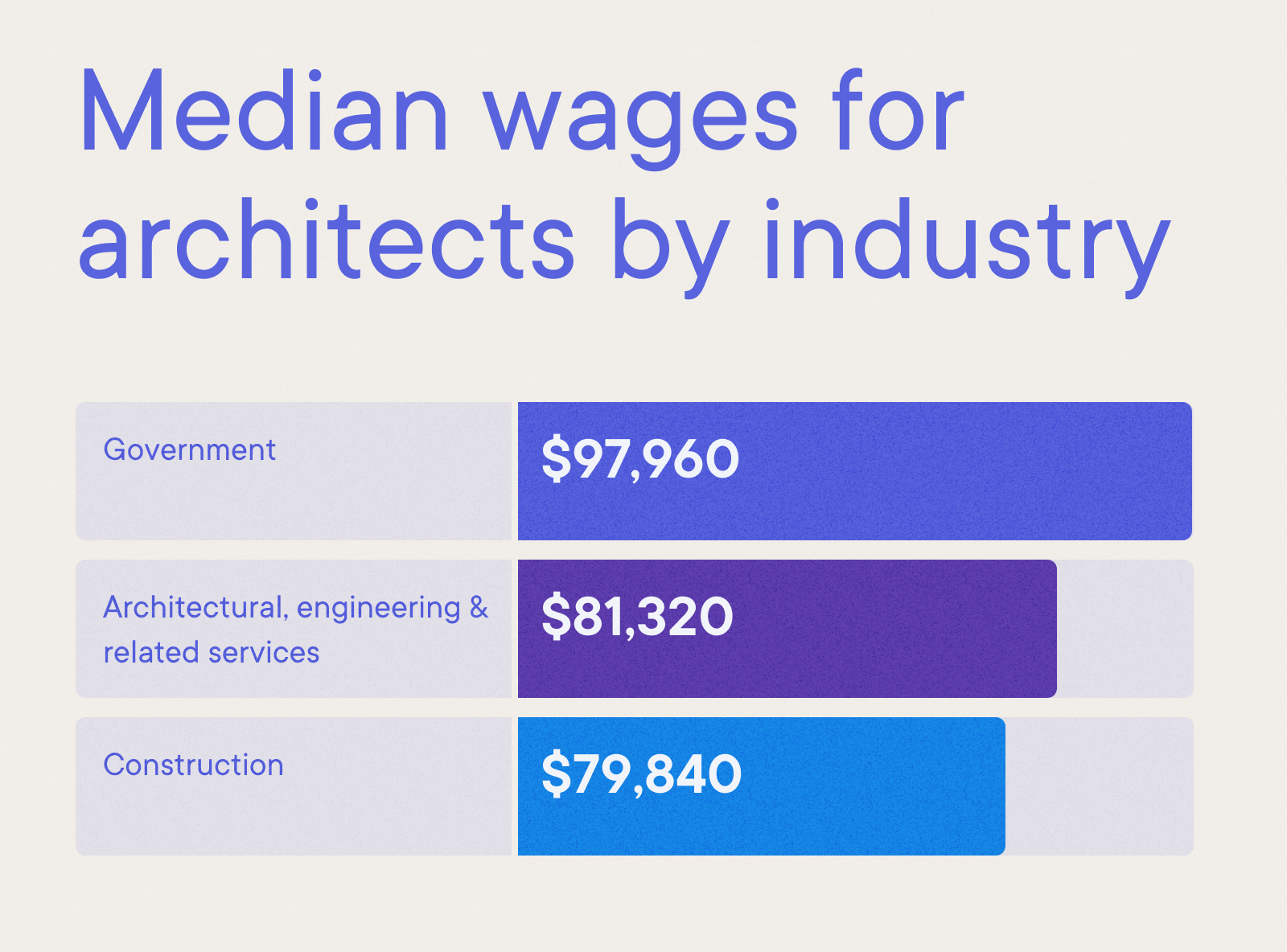
Median wages for architects in the top industries that employed them, 2020:
| Government | $97,960 |
| Architectural, engineering & related services | $81,320 |
| Construction | $79,840 |
Source: BLS Occupational Outlook Handbook
To compete for these jobs in today’s marketplace, architects need a professionally designed resume and a well-written, properly structured cover letter.
But for now, let’s talk about cover letters, a crucial but sometimes underestimated component of any job application. Here’s what we’ll discuss in this guide:
- Why a cover letter can be an essential companion to a resume
- How a cover letter is structured and how to write each portion of it
- Proper formatting: fonts, margins and file types
- Psychological tips to maximize the chances of a positive reply
- Common cover letter mistakes to avoid.
Why architects need a cover letter
While a resume can and should list the work history, education, certifications and skills that qualify you for a job as an architect, a cover letter accomplishes something a resume can’t. A cover letter is the opening salvo in a person-to-person conversation with someone who has the power to offer you a job. This personal appeal can make the difference between success and failure.
In addition to establishing this all-important personal connection, the cover letter reinforces the resume by outlining your employment history, job skills and other qualifications, albeit in a format that allows for more originality. Architecture is a profession that values creative individual vision, and your cover letter is one way of demonstrating that you have this very quality.
A cover letter should be one page only, between 200 and 400 words, and you need to make every word count. Its brevity actually makes it harder to write, not easier. We’ll look at some of the strategies for maximizing the value of a very limited space. A few employers prefer to receive only a resume, and at times their job application systems don’t allow you to upload a cover letter. If that’s the case, you’ll have to respect the employer’s wishes.
But unless you’re specifically asked not to, you should always include a cover letter with a job application. If well written and correctly formatted, a cover letter will almost always increase your chances of success.
A CareerBuilder survey conducted by Harris Poll asked 1,138 hiring managers about the biggest resume mistakes that were instant deal-breakers. Among the top seven errors, 10% cited the failure to include a cover letter.
If your talents extend to the inside of buildings, check out our other related cover letter samples. Or if you lean more toward the technical side, our engineering category of cover letter samples is a great place for further inspiration.
- Interior Designer cover letter sample
- Property Manager cover letter sample
- Real estate cover letter sample
Best format for an architect cover letter example
As an architect, you don’t need anyone to explain to you the importance of structure, though you may be unfamiliar with the basic components of a good cover letter. Here they are:
- The cover letter header
- The greeting / salutation
- The cover letter intro
- The middle paragraphs (body of the letter)
- The ending paragraph of your cover letter (conclusion and call-to-action)
The comprehensive cover letter guide offers more general advice about how to go about compiling cover letters, but below you will find specific advice on how to maximize the effectiveness of each specific letter paragraph and section.
The purpose of the header at the top of the page is to quickly and attractively present your name, address, phone number and email. Your name should generally be the largest element on the page, displaying your confidence and making it more likely that your correspondent will remember you.
A return mailing address, while historically considered essential, is sometimes omitted in the current digital age. But you should generally include it unless there’s a reason not to, or at least mention the city, state and perhaps country where you live. The header is also a singular opportunity for some creativity of design on a page that will otherwise consist of paragraphs of black text. You may want to include a photo and a light splash of color, though the header should never be garish or over-decorated.
You do want to use the header to factor in some white space, giving the eye a break and creating a visually pleasant balance to the page.
The aim of the cover letter header: Plainly state your vital contact details. Save the frills for the body of your letter.
Align document styles
You know all about the importance of coherent and visually consistent building design. The same applies to your resume and cover letter — you don’t want a clashing riot of fonts, font styles and colors.
This is why you should always use the same fonts, font sizes and formatting styles in your cover letter and resume. They should be a visual match, making it obvious that they came from the same person. This shows your attention to detail and your understanding of the principles of cohesive design — the very things that make you a good architect.
The time-honored format for a cover letter greeting is a simple “Dear Mr. (or Ms.) Xxxxxxx.” You can’t go wrong with this approach, so don’t overthink it. It is true that the era of email has loosened some of the rules of letter salutations, with more informal options like “Greetings” or “Hello” gaining popularity. Take some time to study the tone and style used by your prospective employer, and try to match its level of formality or familiarity. But when in doubt, lean toward the more conservative approach.
It’s almost always best to address a cover letter by name to the person in charge of hiring. If this information isn’t readily available, it’s often worth calling the company to inquire. A letter addressed to an individual is actually more likely to get a reply than a letter addressed to an entire firm. If you’re told that no name is necessary, you may be dealing with a hiring manager who for whatever reason prefers to remain anonymous. If that’s the case, don’t push it, and find a creative way to address your letter to the entire company or to the appropriate department within the company.
Dear Mr. Trask,
When you have a name – and when you don’t
Addressing the recipient by name is one of the best strategies for catching a hiring manager’s attention right from the start of your letter. Many job postings even list the name of the hiring manager or contact person giving you every reason to include it in your letter.
However, in some large companies or organizations hiring is done by a large team and it may be impossible to figure out who will be reading your letter. In this case you might have to opt for a general greeting like “Dear XYZ Company Hiring Manager.” “Team” can also be a great non-specific word to use when a name is not an option.
After a few minutes poking around the internet searching for the hiring manager’s name, you might be tempted to throw your hands up in the air and go with “ To Whom it May Concern:” However, this greeting is not just impersonal, it feels outdated and even cold. Using the company name, even in a general greeting, conveys that you are a human being speaking to other real people.
The aim of letter greeting/salutation: Your salutation sets the tone for the rest of your letter, so staying on the formal side is a good idea.
It’s time to start writing. The introduction is a single paragraph consisting of one or two provocative, attention-grabbing sentences that both state your job objective and provide a brief preview of your experience and qualifications for the job. It’s important to find the right tone — bold and confident, yet professional and appropriate.
The aim of the cover letter intro: Pique their attention early with your most important message to keep recruiters reading.
After four years working with one of the leaders in sustainable construction in the UAE, I want to work with one of the leaders back in America. Eco-structure has worked on some fantastic projects and I would like to bring my award-winning sustainability expertise to your commercial and residential teams.
In the central two or three paragraphs of your letter, you need to make your primary pitch. Here you might discuss your education and certifications, but you definitely need to highlight your relevant work experience. You should be as specific as possible, using facts and figures like the number of buildings you’ve designed and their dollar value to your firm. Also, use anecdotes about your past achievements — for example, unusual challenges you faced, how you resolved them and the positive results you achieved.
Toward the end of the body of your letter, you can segue to a broader discussion of your skills and passions, perhaps discussing new challenges you’d like to embrace in the future and how you’re prepared to do so.
The aim of the body of your cover letter: Describe your design process and how you work with clients to ensure a successful project, in terms of aesthetics, function and budget.
I am a LEED Accredited Professional and I have retained my architect’s license from the California Architect’s Board because I have kept some U.S. clients. My training in Dubai was first class and I am proficient in Rhino 3D, Autodesk Revit, ArchiCAD and SketchUp. After playing a leading role in winning a MENA Green Building Award for Multiplex Constructions, I have authored industry whitepapers on lifecycle assessments, energy modeling and carbon accounting. Thought leadership has never been more important and I was a regular speaker at MENA sustainability conferences. Helping design 35+ commercial and residential projects has honed my sense of what is possible. Looking at your project pipeline, the following further achievements may be useful:
- Created award-winning sustainability index for residential and mixed-use projects.
- Saved $27m in costs by employing mitigation techniques and negotiation skills.
- Created an organizational communication matrix to decrease planning time by 22%.
My portfolio drawings #6 and #12 are particularly relevant for Eco-structure’s sustainability agenda. My international project management skills would also be an asset to your company as I know that you have a diverse global team.
Your final paragraph should be both a summary of what you’ve already said and an enthusiastic call to action.
The aim of this part: Tell your future employer why you're the right person for the job and justify your request for an interview.
I would relish the chance to discuss my projects and hear about your future plans at an interview. Building upon my sustainable legacy with Eco-structure is an ideal career move. Sincerely, Andrew Fernhill
This kind of request for follow-up action demonstrates that you are serious about this job and that you’re prepared to take the next step. Your request should be confident but not pushy, and ideally it will prompt your correspondent to reply.
Formatting your cover letter
Remember that the visual design of your cover letter should match your resume, using the same fonts and styles. The best way to make sure of this is to use professionally designed templates like those we offer at resume.io.
Many companies today use electronic Applicant Tracking Systems (ATS) that search resumes for keywords and phrases that describe qualifications essential to the job. Formatting and file types are part of the strategy on passing the so-called “ATS test”. Fonts are another very important factor to consider. Once you’re past the ATS they directly impact human readability. There’s still a debate as to whether serif or sans serif fonts are better, with some academic studies saying that the difference is negligible and other research papers stating it is significant (in favor of sans serif readability).
Here are some safe fonts usually preferred by designers and HRs:
- Times New Roman (this one is debatable, as it’s often considered old-fashioned, but some more conservative companies/HRs may appreciate it).
Open Sans, Roboto, Verdana and PT Sans are good options as well.
Never underestimate the psychological effect of fonts on the reader. A clean, light font may be the difference between someone’s eyes getting “tired” on the 2nd or 15th line of text.
Align your paragraphs left, and leave a space between them. Margins should be one inch on top, bottom and both sides. If this doesn’t allow you to fit your content onto one page, you can consider shortening your top and bottom margins to ¾ inch.
The psychology of persuasive writing
A cover letter is written to persuade, and to be successful at that you want to get inside the hiring manager’s head. Here are some tips that can help:
- Learn everything you can about the firm you’re targeting. What is it known for, what does it do well, and what are its greatest needs? Make it clear in your letter that you’ve done your homework on this company, and that this isn’t the same generic cover letter you send to everyone else.
- Focus on the company’s needs, not your own. It’s important to remember that you’re not writing a cover letter to convince anyone that you deserve a job. You’re writing to convince employers that you can help solve their problems, not that they can help solve yours.
- Use emotional language to speak to the heart as well as the head. Although the word “passionate” may be a bit overused in cover letters, it’s effective because it conveys emotion and enthusiasm. Don’t be afraid to talk about things you “love” to do, the “satisfaction” you derive from a successful outcome, or how you would be “delighted” to meet for an interview. Strive to come across like a warm human being, not a cold potato.
- Remember that people love a good story. In every cover letter, try to find one anecdote from your work experience in which you faced and surmounted a special challenge.
- Put yourself in the shoes of the person you’re writing: Would s/he perceive your tone as appropriately enthusiastic or overconfident? If you were the hiring manager and you received this letter, would you want to meet the person who wrote it?
Architect cover letter mistakes to avoid
In crafting your cover letter, consider a few don’ts:
- Avoid any mistakes in English usage. Typos, misspelling and errors in grammar and punctuation are among the biggest deal-breakers in resume and cover letter writing.
- Avoid clichés, PR-speak and fluff. Write in lively, original language that your recipient hasn’t seen a thousand times before. Write like a real person, not a corporate robot, and avoid “fluffy,” bloated language that doesn’t say anything.
- Don’t send out the same copy-pasted, one-size-fits-all letter to everyone. Every cover letter should be uniquely targeted to an individual employer.
- Don’t mention irrelevant hobbies or skills that have nothing to do with your profession.
- Avoid errors in fonts, formatting and design such as those discussed above.
Key takeaways
- Both the pay and job outlook for architects is excellent, but increasing competition for architect jobs means you need an outstanding cover letter and resume to rise above the crowd.
- Cover letters need to adhere to industry standards of structure and design. Understand the components of a cover letter and follow the guidelines for writing each of them.
- Make sure your resume and cover letter have a matching visual style, using the same fonts, font sizes and formatting, but customize the content of each cover letter for every prospective employer.
- Avoid common mistakes — typos, clichés, formatting errors and irrelevant info.
Get off to a great start by using the field-tested templates and professional guidance at resume.io. You’ll be building on success!
Free professionally designed templates

for architecture by architects
How To Write The Perfect Architecture Cover Letter

It’s 2023, but your cover letter still works like a firm handshake. It creates a critical first impression, so the focus should be on keeping it sharp and concise.
Simple enough?
While you’re looking for new architectural opportunities, you’re also spending hours tweaking that resume. But, the game changer can be a well-drafted cover letter. You can say that most employers don’t read your cover letters. However, more than half of them do expect to receive one.
Your cover letter is like the spare tire; you don’t know when it comes of great use. Strange, right?
But, if you’re serious about landing a job, whether it’s an internship, full-time or part-time your resume is not enough. So, yes, you should write a cover letter to give more weight to your application. No worries, though.
We’ve got you covered in the following guide that answers all your questions. And, it’s going to help you to write that perfect architecture cover letter.
So, keep on reading!
Table of Contents
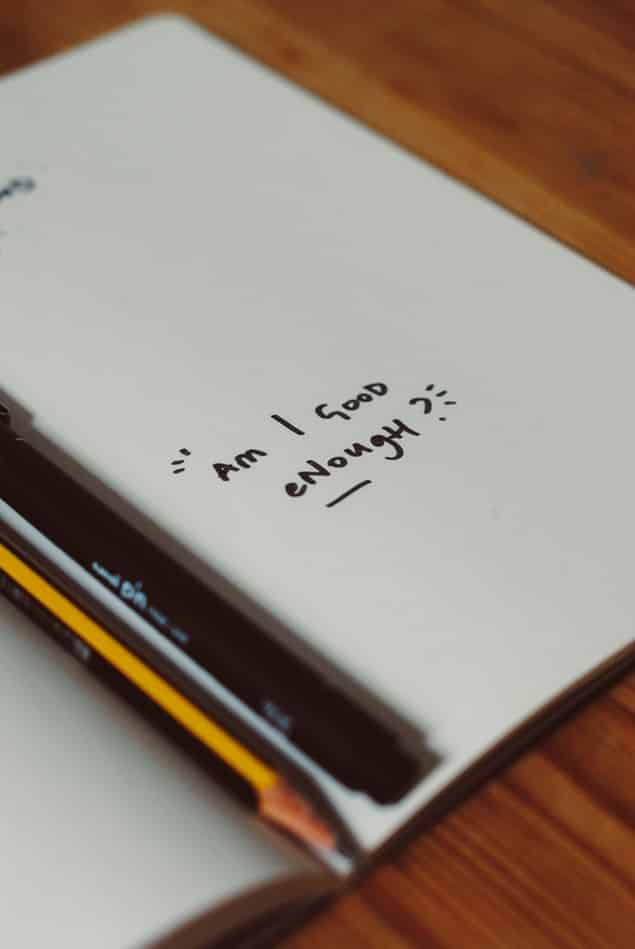
Purpose of a Cover Letter
- It conveys to the employer why they should hire you.
- It highlights your significant accomplishments and critical skills. You should elaborate on the roles that you have played in other firms. This helps to draw employers’ attention to your unique experiences.
- You should express your passion for architecture and the role that you’re applying for. This helps to show that you’re serious about getting the opportunity.
- It sets the ground for the follow-up process. If you mention the date and time when you’ll be calling them for the follow-up, then it safely eliminates the waiting game. You can throw the ball in their court, and at the same time look out for other job openings.
- The cover letter makes up for a poor-quality resume. If you don’t sound confident enough in the resume, then ensure to demonstrate your personality through a persuasive cover letter.
- It showcases your communication skills (writing ability), as the resume comes with a strict formula of short, choppy statements and bullet points. So, use the cover letter to put the right foot forward.
Common Mistakes While Writing a Cover Letter
- Don’t beat around the bush, instead be straightforward while describing your experiences.
- Avoid using emoticons, and words like “WOW,” “LOL,” and “OMG.” It’s a cover letter for a job and not a text message.
- Don’t focus too much on yourself and your achievements. The employer is looking for someone who can get the work done. So, focus on things that you believe they want to know about an employee applying for that particular role.
- You are overusing the word “I” at the beginning of every sentence. This makes the cover letter look more like an autobiography.
- Avoid sharing every tiny detail about your past projects and experiences. A brief explanation will get the work done!
- Avoid giving details that become a red flag. You shouldn’t focus on your weakness or your bad experience in the previous job. Let the cover letter speak about your present scenario rather than highlighting the past.
- Avoid using unnecessary words or confusing and complicated sentences. Keep it concise and straightforward for easy interpretation.
- Don’t stretch the cover letter too long. You can keep it either half-page or full-page long.
- Avoid writing the same information that has already been mentioned in your resume.
- Do not use a non-professional email address, for example, [email protected]
- Don’t forget to sign the cover letter. You should follow this business etiquette, as it shows your attention to detail.
- Avoid making the cover letter sound too generic. You should customize it to suit the organization that you’re applying to.
- Do not end the cover letter on a passive note. Instead of depending on them to call you back, you should give a follow-up. For instance; I will follow up by the 19th of June, to answer any further questions, and in the meantime, you can get me at (+033) 333-3333.
- Avoid making any spelling mistakes. Proofread your cover letter at least twice before you forward the piece.

Tips for Writing the Cover Lette r
1. keep it short.
Take just the right amount of space to specify the things that you can offer to the organization. Avoid going overboard with superfluous words and too much information. To demonstrate your ability to communicate effectively, you should focus on writing a compelling and concise cover letter. Don’t go beyond a page, and stick to a maximum of four to five paragraphs.
2. Start with a strong message
In the first few sentences, you should mention the position you’re applying for and why you’re a strong candidate for that role. Highlight your experience and quality, which makes you an ideal competitor for the position.
However, those of you without relevant prior work experience can focus on briefly describing your extracurricular activities and coursework. Overall, the employer should understand that you’ve got the right foundation to establish your career in their firm.
3. Why do you want a specific job?
Your cover letter should target the job at hand. Try to read through the job description carefully, and the skills required for that role. Focus on adding keywords that have been mentioned in the job description (e.g., degree required, years of experience, specific software skills, etc.).
To further personalize your cover letter, you can demonstrate your familiarity with the job role, specific industry, and employer. Remember, employers want people who appreciate their work. They hire people who have the potential to grow along with their business and can evolve to be a stronger personality in the firm.
4. You can personally address the hiring manager
Just like how we personalize the resume, the cover letter should also focus on addressing the hiring manager. If you don’t have any information about them, you can contact the company directly to find out.
This shows your effort in learning about the vision, mission, and critical leadership qualities of the organization. You can also mention the name of the person who has referred you to this job.
5. Sell Yourself
The cover letter is your marking document, try keeping it unique. Don’t simply rehash your resume, instead, you should be elaborating on the best parts of it. Try to draw the reader’s attention to your specific skills and experience. And, explain why the job is vital for your career goals. Also, justify the gaps in your resume, if any.

6. Use the correct format
In the design world, your formatting plays an essential role in making the cover letter look professional and smart. Ensure that the format of the cover letter matches your resume. Both of them should complement each other.
7. Focus on your soft skills
Tailor your cover letter in a way that it can’t be ignored. Focus on incorporating your soft skills, such as work ethic, ability to meet deadlines, working overtime (quite common in architecture), effective communication skills, quick learning , teamwork, etc.
8. Proofread thoroughly
Once you’re satisfied with your argument for the desired candidacy, it’s time to proofread your entire piece. You can’t impress a hiring manager when you have grammatical errors and typos in the cover letter.
After you’ve proofread your work a few times, get your friend to read it. You can also give your friend a copy of the job description, so they can ensure you’ve filled all the gaps.
How to structure the architecture cover letter?
A cover letter helps to introduce your resume to the prospective employer. It tells them everything they need to know about a potential candidate and the reason why they’re contacting the firm. Use this forum to explain your situation, but be honest with your descriptions.
Here are the three fundamental parts, which give the basic outline of your cover letter:
1. Introductory paragraph
You must focus on answering the unvoiced questions of the employer, which include- Who are you? Why are you contacting me? Which position are you applying for? Why should I hire you?
Give a slight hint of what you can offer to the firm by briefly mentioning your qualifications, skills, and experience. Your answers should be clear and crisp so that each sentence is simple to grasp.
Ensure that you provide a clear description as to why you’re an ideal candidate for the job role. You can also state how you got to know about the job vacancy. Use action-oriented, positive language, and be smart and confident with your writing style.
2. The body paragraph
State your reasons for wanting to work with this employer and your interest in your chosen career field. Give a summary of your skills and experience and how it applies to the job position.
You should focus on the job description to help you tailor the cover letter correctly. For instance, if the firm is looking for a Rhino 3D expert, you should highlight this skill in your cover letter. Similarly, ensure that you cover all the relevant skills mentioned in the job description.
Avoid repeating what you had initially written in the resume. Instead, try to present a consolidated account of why you’re suitable for the job. To get the attention of the reader, you can add a couple of examples to back up your statements.
Moreover, you can use the cover letter to include the skills and accomplishments that you haven’t mentioned in the resume. Also, you can explain the dodgy parts given in your resumes like the layoffs and gaps. But, add only those points that portray you in a positive light, concerning the job.
3. Closing paragraph
Mention about what you can contribute to the firm. And, don’t emphasize too much what you can get out of this opportunity. The employer wants to hear how you’re going to be beneficial to their business. But, you have to be smart to present your answer in a polished manner.
You can also ask them to go through your resume for additional details. Your last sentence should be quite firm, with a request for positive action. Sound confident and interested. You can request them for a follow-up call and a personal interview.

The different ways to submit a cover letter
You have three modes that you can choose from to submit your cover letter:
Mailed hard copy
Email applications, website submissions.
We generally don’t advise anyone to send their applications through the old mail system. However, if you opt to send a hard copy of your applications, then print the cover letter on quality white bond paper. And, don’t forget to sign it at the end.
Get a waterproof envelope to prevent any damage to your application.
If you’re sending an email cover letter, we advise you to follow the instructions given by the employer on how the resume and cover letter should be addressed. Most people, when applying by email, usually opt to include their cover letter directly in the body of the message.
When you type the cover letter in your mail, you don’t have the additional burden of attaching a separate file. You again have options for attaching your cover letter by email. We’ve compiled the three different methods along with their positive and negative aspects.
Let’s take a look at them!
Sending Cover Letter in the Body of Email, Portfolio , and Resume as Attachments
Some employers prefer to go through the cover letter first, before checking out the resume and your portfolio. You should ensure that you convey all the information correctly in your email concerning the job.
First impressions are important, especially when it comes to landing a job. So, draft your email correctly, and ensure to check it a few times before you tap on the ‘send’ button.
What are the benefits?
- It increases the possibility of the cover letter being read by your prospective employer. They can open the mail and find out about you without having to download the attachments separately.
- Gives the package a more exciting look, without having to search for the cover letter in the attachments.
- Your sample portfolio and resume are kept in different attachments, so you don’t need to worry about having the same format for both.
What is the negative aspect?
- When you attach your portfolio and resume as separate attachments, there is a possibility of it not being opened.
Combining Email Cover Letters, Resumes, and Portfolios as One Attachment
If you need to attach a cover letter, resume, and portfolio (as per employer instructions), use Adobe PDF and Microsoft Word files in your email message. Moreover, save the files correctly with your name, to avoid it from getting jumbled up with the documents of other applicants.
What is the positive aspect of it?
- With a single document, the employer can easily keep track of it. However, if you don’t include a convincing body cover, they might not even open the attachments.
What are the drawbacks?
- The formatting for all three documents should be the same.
- If you include your cover letter in the body of the email as well as an attachment, then the PDF is no longer useful.
- When you send the application all-in-one document, it gets easier for the hiring manager to forward or print the pages.
If your application can be sent in separate attachments then you don’t need to worry about having the same formatting for each one of them. For instance, you don’t have to change the format from landscape to portrait.
- It’s easier for the hiring manager to find the document that they are looking for, without having to skim through all of them.
- Allows you to use a different format for each document.
What is the drawback?
- The additional burden of having to open and close separate files.

Some of the big architect organizations generally have the submission of applications on their website. For submitting your cover letter in this situation, you’re given either of these two options:
- A text-only box
If it’s a plain text box, it won’t allow you to format your document. So, when you’re applying, you should get the cover letter formatted in both plain text and HTML. This helps to ensure that your document is easily readable.
- Attaching your cover letter in pdf file format
We advise you to go for this option if the website has it. However, if it offers a text box for the cover letter, you’ve to face issues with getting the right format.
Your cover letter is not a mere courtesy or formality- it’s an opportunity to create an impression. And, you can land your dream architecture job, by crafting an effective cover letter. Use these tips and tricks to get the best out of your writing. You should put in the required effort to reflect your capabilities uniquely. If you plan to get the shortcut and use a paper writing service, always make sure the tone is your own, that you personalize the draft, and infuse your own personality, by being yourself there’s no way you can go wrong. So, go ahead and grab every opportunity.
We wish you good luck!

Leave a Comment
Resume Worded | Career Strategy
14 architect / architecture cover letters.
Approved by real hiring managers, these Architect / Architecture cover letters have been proven to get people hired in 2024. A hiring manager explains why.

Table of contents
- Architect / Architecture
- Senior Architect / Architecture
- Urban Planner
- Senior Architect
- Architectural Designer
- Alternative introductions for your cover letter
- Architect / Architecture resume examples
Architect / Architecture Cover Letter Example
Why this cover letter works in 2024, architecture's power to inspire.
What I love about this cover letter is that we highlight the impact of SOM's iconic projects on the applicant's motivation. You should emphasize the unique aspects of the company that resonate with your own values and aspirations.
Demonstrating Sustainable Design Skills
This sentence showcases a specific accomplishment that aligns with the company's focus on sustainable design. Make sure to include relevant achievements that demonstrate your skills and how they align with the company's values.
Adaptability in Design Approach
By highlighting the applicant's experience in different project types, we show their versatility and ability to adapt to different design challenges. This is a valuable skill for an architect and can set you apart from other candidates.
Contributing to a Collaborative Culture
Emphasizing your alignment with the company's culture is crucial. In this sentence, we stress the applicant's belief in collaboration and innovation, which is a key part of SOM's work environment. Make sure to research the company's culture and express your excitement to be a part of it.
Draw connections between personal passions and job aspirations
Expressing a personal interest or fascination with the company’s work could make your application more memorable to a hiring manager. By talking about your genuine fascination with a project that the firm has completed, you show that you're not just passionate about architecture in general, but specifically about the kind of work they do.
Concrete examples of past achievements
Providing specific examples of past achievements, especially ones that align with the company's ethos, can give the hiring manager a clear idea of what you bring to the table. Illustrating your past success, like reducing construction costs with innovative techniques, shows that you're capable of delivering results and contributing positively to the firm's objectives.
Past Achievements Highlighted
The writer isn't just saying they have experience, they're showing it by detailing their past accomplishments. By mentioning that they have led projects resulting in significant energy reduction and increased market value, they demonstrate their potential to make a positive impact at Gensler. It's not just about telling your employer what you've done, but also about showing them how your past experiences make you a valuable addition to their team.
Speaks to Company's Mission
Expressing your excitement about a company's work not only shows you've done your homework, but also that you're already committed to their mission. Here, the applicant clearly shares Gensler's commitment to sustainability and community impact, showing a deep alignment with the company's ethos.
Specific Skill Set
Being concrete about the unique skill set you bring to the job, like proficiency in specific design software, sustainable design mindset, and team collaboration, can make you more attractive to employers. It shows that you know exactly what the position requires and you're ready to hit the ground running.
Expressing Genuine Interest
Your cover letter is your chance to show your genuine interest in the company, and this applicant nails it. They're not just looking for a job, they're looking to join a team that aligns with their aspirations. This shows employers that they're likely to be committed and enthusiastic if they're hired.
Polite and Eager Close
Ending the letter with a courteous note and an eagerness to discuss further illustrates your professionalism and interest. It leaves a positive impression and sets the tone for any potential interviews.
Connect your passion to your career path in architecture
Sharing a personal story, like your childhood fascination with building, helps me see your genuine interest in architecture. This makes your application more memorable.
Show your architect impact through specific projects
Talking about your experience with drafting, 3D modeling, and project management shows your hands-on skills. Mentioning a specific successful project adds credibility to your claim.
Highlight your commitment to sustainable architecture
Describing your efforts to achieve sustainability within budget constraints demonstrates your ability to merge innovation with practicality, a key skill for an architect.
Research the company's architectural values
Expressing admiration for the company's work and impact shows you have done your homework and share similar values. This aligns your application with their mission.
Express eagerness to contribute to innovative designs
Closing with gratitude and eagerness to discuss your contribution further shows politeness and enthusiasm for the role and the company's projects.
Does writing cover letters feel pointless? Use our AI
Dear Job Seeker, Writing a great cover letter is tough and time-consuming. But every employer asks for one. And if you don't submit one, you'll look like you didn't put enough effort into your application. But here's the good news: our new AI tool can generate a winning cover letter for you in seconds, tailored to each job you apply for. No more staring at a blank page, wondering what to write. Imagine being able to apply to dozens of jobs in the time it used to take you to write one cover letter. With our tool, that's a reality. And more applications mean more chances of landing your dream job. Write me a cover letter It's helped thousands of people speed up their job search. The best part? It's free to try - your first cover letter is on us. Sincerely, The Resume Worded Team
Want to see how the cover letter generator works? See this 30 second video.
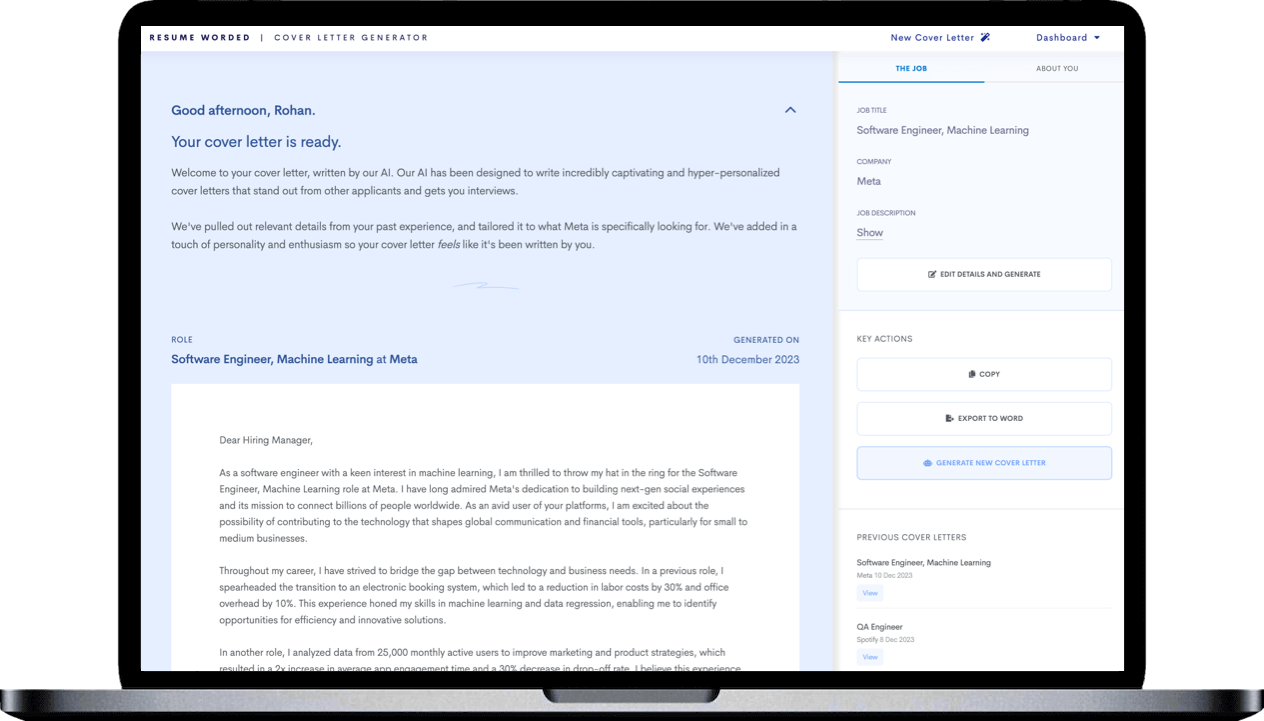
Show your passion for green architecture
Sharing the moment you fell in love with a company's work makes your application personal and memorable.
Connect your experience to the job
Mentioning specific projects you admire demonstrates both your knowledge of the field and your enthusiasm for the company's vision.
Highlight your achievements in sustainable design
Describing a major project where you made a significant environmental impact shows that you have experience in creating value through architecture.
Express eagerness to contribute
Showing your excitement about the opportunity to join a team and make a difference indicates that you will be an engaged and motivated employee.
Be grateful and open for discussion
A polite thank you and a statement expressing your willingness to further discuss your application demonstrate professionalism and openness.
Senior Architect / Architecture Cover Letter Example
Express deep interest in the company’s work.
Showing that you've taken the time to familiarize yourself with the company's work demonstrates that you're genuinely interested in what they do. Visiting one of their projects and being impressed by it can underline your passion for the industry and their approach to it.
Highlight leadership and problem-solving skills
Describing how you led a team to complete a project ahead of schedule and under budget not only highlights your leadership skills but also your ability to problem-solve and manage resources effectively. These are key skills that any firm would value, especially from a senior architect.
Aligning personal values with the company's principles
Expressing your excitement for the company's commitment to creating inspiring and sustainable spaces can strike a chord with the hiring manager. By showing that your professional ethos aligns with theirs, you demonstrate that you'd be a great cultural fit for the company.
Urban Planner Cover Letter Example
Substantive past projects.
Sharing the specifics of past projects, like leading a mixed-use development project that won an award, gives the hiring manager a sense of your capabilities. It also shows you're not afraid of big responsibilities and you know how to deliver results.
Alignment with Company's Vision
By expressing admiration for BIG's projects and how they align with your personal beliefs, you're highlighting your passion for the industry and showing them you're on board with their future-thinking initiatives. This can give them confidence that you'd be a good cultural fit.
Congruency with Company's Ethos
Sharing your appreciation for BIG's commitment to improving quality of life shows you're not just looking for any job, but a role that aligns with your values. This can make you stand out as a candidate who is likely to be invested in the company's mission.
Clear Career Objectives
Stating how the job aligns with your career goals and personal values gives the impression that you have thought carefully about this application. It shows you are likely to be motivated and committed should you get the job.
Gracious Ending
Thanking the hiring manager for their time and expressing a desire to discuss further not only shows your interest in the role, but also your respect and appreciation for the opportunity. This leaves a positive impression and sets a good tone for any follow-up conversations.
Senior Architect Cover Letter Example
Draw connections between early passions and your architecture career.
Starting with a reflection on how architecture affects people's lives from a young age showcases a deep-rooted passion for the field, making your application more compelling.
Demonstrate leadership in groundbreaking projects
Mentioning your role in an award-winning project underlines leadership skills and a strong vision for sustainable and impactful architecture, which is attractive to employers.
Showcase your ability to merge functionality with innovative design
Describing the challenge of integrating technical requirements with user-centric design illustrates your innovative approach to architecture, highlighting your problem-solving skills.
Align your values with those of the company
Showing appreciation for the company's legacy and expressing a desire to contribute to their mission suggests that your values and goals align, making you a potentially good fit for the team.
Convey enthusiasm for meaningful architecture
Ending your letter with a statement of eagerness to discuss how you can contribute to the company's mission encapsulates your application with a note of passion and readiness.
Show your architectural design impact
Talking about your past success in projects shows you can bring value to new teams. Your experience with award-winning designs proves you understand what makes a space special.
Highlight leadership in architecture projects
By mentioning your role in leading significant projects, you're showing your ability to handle big responsibilities. It’s good to share examples where you managed to meet important goals like staying under budget.
Share your passion for mentorship in architecture
Your commitment to guiding new architects shows you're not just about buildings, but also about building people. This makes you a valuable team member beyond your design skills.
Align personal values with the firm’s mission
When you speak about your shared values with the firm, it shows you’re not just looking for any job, but a place where you can truly belong and contribute to its vision.
Express enthusiasm to join the architectural team
Ending your letter with gratitude and excitement about the potential of joining the team leaves a positive last impression. It shows you’re eager and ready to contribute.
Align your values with the firm's mission
Expressing how your personal design philosophy matches the firm's goals builds a strong case for your fit within their culture.
Showcase leadership and innovation
Detailing your role in developing a sustainability framework that others adopted highlights your ability to lead and influence in the architecture industry.
Emphasize people-first design
Discussing your commitment to architecture that prioritizes human wellbeing illustrates the depth of your understanding of the impact of your work.
Demonstrate team leadership skills
Stating your experience with leading diverse teams and your passion for collaborative design shows you're prepared to contribute to a multidisciplinary team.
Express eagerness to join and enhance
Conveying your desire to support the firm's mission and bring your unique skills to the table shows genuine interest and ambition.

Architectural Designer Cover Letter Example
Show how personal passion fuels your architect career.
When you share what drove you to this field, it helps me understand your dedication. Your early interest in the emotional impact of buildings tells me you'll bring heart to your designs.
Collaboration in architecture is key
Stating your enjoyment in working with senior architects signals that you value teamwork and learning from others. This is vital in our industry where projects thrive on collective expertise.
Highlight your technical and design skills
Detailing your experience with 3D modeling and graphic presentation shows you possess essential skills for an architectural designer. It assures me you can handle the technical aspects of design projects.
By expressing your appreciation for our commitment to socially responsible designs, you make a strong case for your fit within our culture. This alignment is crucial for long-term success.
Your closing statement does well to convey your interest in advancing our mission. It's a good sign when a candidate is forward-looking and eager to make an impact.
Connect with the architectural firm’s philosophy
Showing that you’re drawn to the firm’s mission highlights your passion for meaningful design. It makes your application more personal and shows you’re a good fit.
Demonstrate innovative thinking in design projects
Sharing your experience with creative projects during your internship shows you can think outside the box. This is crucial in architecture, where innovation shapes the future of our spaces.
Highlight interest in healthcare architecture
Mentioning your specific interest in the firm’s healthcare projects shows you’ve done your homework. It sets you apart by showing your intent to contribute to areas you’re passionate about.
Showcase recognition in architectural design
Talking about the honors your work has received is a strong way to prove your skills. It tells the hiring manager that your designs are not just good, but award-worthy.
Express eagerness to contribute to the architectural team
Ending your letter on an enthusiastic note about joining the team shows you’re not just looking for any job. You want to make a difference in the spaces they create.
Connect with the firm’s values
When you mention a specific reason for your interest in the firm, like its ethos, it shows you've done your homework. This personal touch is more likely to catch a hiring manager's attention.
Highlight impactful design experience
Describing a project where you made a real difference in a community showcases your ability to apply architectural design in meaningful ways. It speaks volumes about your values and design approach.
Express enthusiasm for innovation
Showing that you value innovation and research aligns with firms looking to push the boundaries of architecture. It indicates you're not just looking for any job, but one where you can contribute to growth and exploration.
Show your holistic design perspective
Talking about your diverse skills and experiences in design, research, and community engagement presents you as a well-rounded candidate. This holistic approach is highly valued in the field of architectural design.
End with a positive outlook
Closing your cover letter on a hopeful note, looking forward to learning and growing with the firm, leaves a lasting positive impression. It shows you're not just interested in what you can bring to the table, but also what you can gain.
Architect Cover Letter Example
Connect with the company's global vision.
Your excitement about applying to a firm known for transforming skylines shows you aim high and value innovation. It hints at your ambition to be part of large, impactful projects.
Demonstrate your architectural achievements
Mentioning your role in designing a LEED Platinum certified project not only highlights your design skills but also your commitment to sustainability. These are achievements that set you apart.
Show leadership in technology adoption
Leading your firm's shift to BIM software demonstrates adaptability and leadership. These are desirable qualities in an architect, showing you're not just a creator but also an innovator.
Exhibit interest in cutting-edge technologies
Expressing curiosity about 3D printing and parametric design indicates you're forward-thinking. Firms look for architects who are not just skilled but are also exploring the future of design.
Invite discussion on skills and vision alignment
Your invitation to discuss your alignment with the firm's vision is a proactive approach. It suggests you're not just seeking a job but a place where your skills can contribute to shared goals.
Alternative Introductions
If you're struggling to start your cover letter, here are 6 different variations that have worked for others, along with why they worked. Use them as inspiration for your introductory paragraph.
Cover Letters For Jobs Similar To Architect / Architecture Roles
- Architectural Designer Cover Letter Guide
- Architectural Intern/ Entry Level Architect Cover Letter Guide
- Architectural Project Manager Cover Letter Guide
- Architect / Architecture Cover Letter Guide
- Architecture Intern Cover Letter Guide
- Civil Engineer Cover Letter Guide
- Civil Engineer Project Manager Cover Letter Guide
- Design Engineer Cover Letter Guide
- Entry Level Civil Engineer Cover Letter Guide
- Entry-Level Civil Engineer Cover Letter Guide
- Landscape Architect Cover Letter Guide
- Minimalist Architect Cover Letter Guide
- Senior Civil Engineer Cover Letter Guide
- Structural Engineer Cover Letter Guide
Other Design Cover Letters
- Art Director Cover Letter Guide
- Design Director Cover Letter Guide
- Game Design Cover Letter Guide
- Graphic Designer Cover Letter Guide
- Interior Designer Cover Letter Guide
- Production Assistant Cover Letter Guide
- UX Designer (User Experience Designer) Cover Letter Guide
- UX Researcher Cover Letter Guide

Thank you for the checklist! I realized I was making so many mistakes on my resume that I've now fixed. I'm much more confident in my resume now.

Architecture cover letter examples
Are you ready for your next architecture role but unsure how to construct an impressive application that will get you noticed?
Then you’ve come to the right place.
In this guide, we’ll teach you how to write a strong and creative cover letter. Simply check out our top tips and architecture cover letter examples below to inspire you.
CV templates
Architecture cover letter example 1
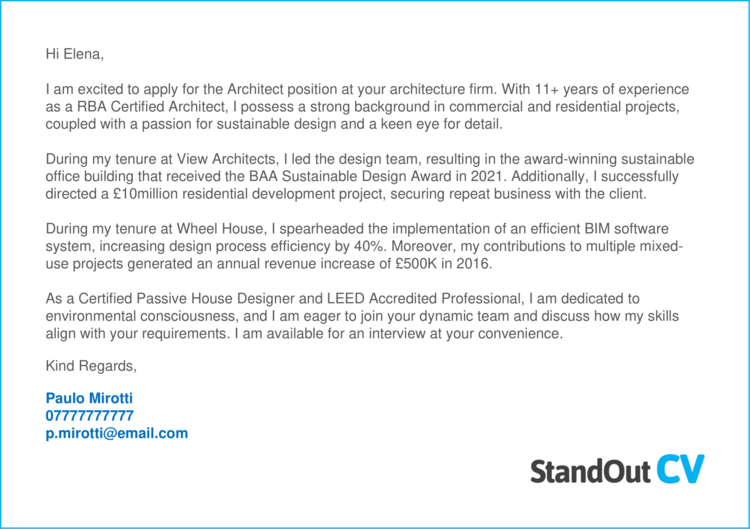
Build your CV now
Architecture cover letter example 2
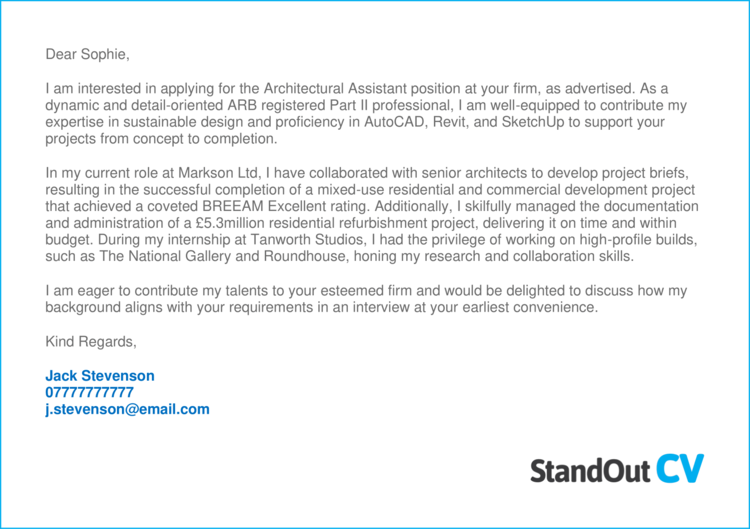
Architecture cover letter example 3
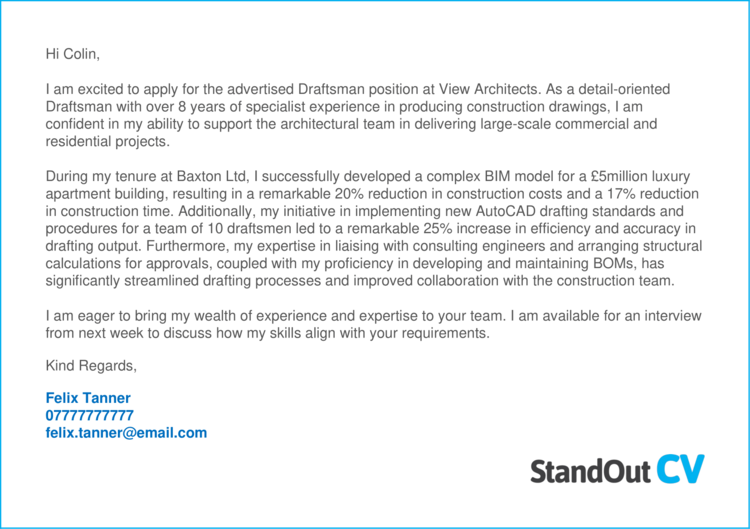
These 3 Architecture cover letter examples will provide you with some good ideas on how to format a cover letter, along with the type of message you should be trying to put across to recruiters .
To further understand exactly how you can write a cover letter that will get you noticed, check out our further guidance.
How to write an Architecture cover letter
Here’s a simple process to write your own interview-winning cover letter.

Write your cover letter in the body of an email/message
You should write your cover letter in the body of the email (or messaging system if sending via a job board) and never attach it as a document.
The reason for this?
You want your cover letter to start connecting with the recruiter from the moment they open your application.
If they have to open a document to read it, it will slow things down and they may not even bother to open it.

Start with a friendly greeting

To build an instant connection with the recruiter reading your cover letter, start with a warm greeting.
It should be friendly but not casual – keeping it professional at all times.
- Hi, hope you’re well
- Hi [insert recruiter name]
- Hi [insert department/team name]
Avoid overly formal greetings like “Dear sir/madam ” unless applying to very traditional companies.
How to find the contact’s name?
Addressing the recruitment contact by name is an excellent way to start building a strong relationship. If it is not listed in the job advert, try these methods to find it.
- Check out the company website and look at their About page. If you see a hiring manager, HR person or internal recruiter, use their name. You could also try to figure out who would be your manager in the role and use their name.
- Head to LinkedIn , search for the company and scan through the list of employees. Most professionals are on LinkedIn these days, so this is a good bet.
Identify the role you are applying for
Once you have opened the cover letter with a warm greeting, you need to explain which role you are interested in.
Sometimes a recruitment consultant could be managing over 10 vacancies, so it’s crucial to pinpoint exactly which one you are interested in.
Highlight the department/area if possible and look for any reference numbers you can quote.
These are some examples you can add..
- I am interested in applying for the role of *Architecture position* with your company.
- I would like to apply for the role of Sales assistant (Ref: 40f57393)
- I would like to express my interest in the customer service vacancy within your retail department
- I saw your advert for an IT project manager on Reed and would like to apply for the role.
See also: CV examples – how to write a CV – CV profiles
Highlight your suitability
The bulk of your cover letter should be focused around highlighting your suitability for the job you are applying to.
Doing this will show the recruiter that you are suitable candidate and encourage them to open your CV.
The best way to do this, is by studying the job advert you are applying to, and find out what the most important skills and knowledge are.
Once you know the most important requirements, you then need to highlight your matching skills to the recruiter. In a few sentences, tell them exactly why you are a good fit for the job and what you can offer the company.

Keep it short and sharp
A good cover letter is short and sharp, getting to the point quickly with just enough information to grab the attention of recruiters.
Ideally your cover letter should be around 4-8 sentences long – anything longer will risk losing the attention of time-strapped recruiters and hiring managers .
Essentially you need to include just enough information to persuade the reader to open up your CV, where the in-depth details will sit.
Sign off professionally
To finish off your cover note, add a professional signature to the bottom, stating your important contact details and information.
This not only provides recruiters with multiple means of contacting you, but it also adds a nice professional appearance to the cover letter, which shows that you know how to conduct yourself in the workplace.
Include the following points;
- A friendly sign off – e.g. “Warm regards”
- Your full name
- Phone number (one you can answer quickly)
- Email address
- Profession title
- Professional social network – e.g. LinkedIn
Here is an example signature;
Warm regards,
Aaron Smith Customer service professional 075557437373 [email protected] LinkedIn
Quick tip : To save yourself from having to write your signature every time you send a job application, you can save it within your email drafts, or on a separate document that you could copy in.

What to include in your Architecture cover letter
So, what type of information should you write about in your Architecture cover letter?
The specifics will obviously depend on your profession and the jobs you are applying to, but these are the key areas you should be covering.
- Your industry experience – Tell recruiters the types of companies you have been working for and the roles you have held in the past.
- Your qualifications – Highlight your most important relevant qualifications to show employers you are qualified to do the roles you are applying for.
- The impact you have made – Demonstrate the positive impact you have made for employers in previous jobs. Have you saved money? Improved processes? Made customers happy?
- Your reasons for moving – Employers will want to know why you are leaving your current/previous role, so provide them with a brief explanation here.
- Your availability – When will you be able to start a new job ? Check your current contract to find out your notice period if you are in a position already.
Architecture cover letter templates
Copy and paste these Architecture cover letter templates to get a head start on your own.
I am excited to apply for the Architect position at your architecture firm. With 11+ years of experience as a RBA Certified Architect, I possess a strong background in commercial and residential projects, coupled with a passion for sustainable design and a keen eye for detail.
During my tenure at View Architects, I led the design team, resulting in the award-winning sustainable office building that received the BAA Sustainable Design Award in 2021. Additionally, I successfully directed a £10million residential development project, securing repeat business with the client.
During my tenure at Wheel House, I spearheaded the implementation of an efficient BIM software system, increasing design process efficiency by 40%. Moreover, my contributions to multiple mixed-use projects generated an annual revenue increase of £500K in 2016.
As a Certified Passive House Designer and LEED Accredited Professional, I am dedicated to environmental consciousness, and I am eager to join your dynamic team and discuss how my skills align with your requirements. I am available for an interview at your convenience.
Kind Regards,
Paulo Mirotti ¦ 07777777777 ¦ [email protected]
Dear Sophie,
I am interested in applying for the Architectural Assistant position at your firm, as advertised. As a dynamic and detail-oriented ARB registered Part II professional, I am well-equipped to contribute my expertise in sustainable design and proficiency in AutoCAD, Revit, and SketchUp to support your projects from concept to completion.
In my current role at Markson Ltd, I have collaborated with senior architects to develop project briefs, resulting in the successful completion of a mixed-use residential and commercial development project that achieved a coveted BREEAM Excellent rating. Additionally, I skilfully managed the documentation and administration of a £5.3million residential refurbishment project, delivering it on time and within budget. During my internship at Tanworth Studios, I had the privilege of working on high-profile builds, such as The National Gallery and Roundhouse, honing my research and collaboration skills.
I am eager to contribute my talents to your esteemed firm and would be delighted to discuss how my background aligns with your requirements in an interview at your earliest convenience.
Jack Stevenson ¦ 07777777777 ¦ [email protected]
I am excited to apply for the advertised Draftsman position at View Architects. As a detail-oriented Draftsman with over 8 years of specialist experience in producing construction drawings, I am confident in my ability to support the architectural team in delivering large-scale commercial and residential projects.
During my tenure at Baxton Ltd, I successfully developed a complex BIM model for a £5million luxury apartment building, resulting in a remarkable 20% reduction in construction costs and a 17% reduction in construction time. Additionally, my initiative in implementing new AutoCAD drafting standards and procedures for a team of 10 draftsmen led to a remarkable 25% increase in efficiency and accuracy in drafting output. Furthermore, my expertise in liaising with consulting engineers and arranging structural calculations for approvals, coupled with my proficiency in developing and maintaining BOMs, has significantly streamlined drafting processes and improved collaboration with the construction team.
I am eager to bring my wealth of experience and expertise to your team. I am available for an interview from next week to discuss how my skills align with your requirements.
Felix Tanner ¦ 07777777777 ¦ [email protected]
Writing a strong attention-grabbing cover letter is a vital step in landing a good Architecture job.
Use the tips, strategies and examples above to get more responses from you job applications and start lining job interview up.
Good luck with your job search!
14 Tips on Architect Cover Letter (Write to Impress!)
Are you just wasting everybody’s time when all the potential employer is interested in is your resume and portfolio?
Despite the ease of digital communications, the architecture cover letter plays a crucial role in getting you that interview.
Why Have a Cover Letter?
A cover letter is necessary for all job applications from new graduate architect roles to architecture internship and senior positions except:
A tailored cover letter is a golden opportunity for you to boost your application. A cover letter lets you:
14 Top Tips for a Good Architecture Cover Letter
1. keep it relevant.
Tailor everything you put in the architecture cover letter to the job role.
2. Be Brief
They may be missing out on the best candidate (you), but you only get one page to sell yourself. George Bernard Shaw summed it up with his apology for writing a long letter when he didn’t have time to write a short one ( source ).
3. Shake Hands
When you walk into a meeting with a stranger, you take time to introduce yourself to the other person. You let them know who you are and what you are doing in the room.
4. Name Drop
5. polish your presentation, 6. formatting.
Format the cover letter so it:
7. Spelling and Grammar
There is no excuse for poor spelling and grammar when you have digital tools to catch most of your mistakes.
8. Active Voice
9. read aloud, 10. perfect pitch.
Take your best, most relevant skill and experience from your resume and pitch it in your cover letter with top billing.
11. Soft Sell
Your cover letter is an excellent vehicle to highlight some of those valuable soft skills with relevant examples.
12. Human Touch
13. flatter the firm, 14. make it personal, avoid these cover letter mistakes, one size does not fit all, boastful statements, unprofessional behavior, long and convoluted, blunt emails, failure to check, not following instructions, the perfect structure of a good cover letter, introductory paragraph, second paragraph: main pitch, final paragraph: persuader, methods of submission, online portals, post a hard copy.
Professional Architecture Cover Letter Example
Cover letter examples, cover letter guidelines, how to format an professional architecture cover letter, cover letter header, cover letter header examples for professional architecture, how to make your cover letter header stand out:, cover letter greeting, cover letter greeting examples for professional architecture, best cover letter greetings:, cover letter introduction, cover letter intro examples for professional architecture, how to make your cover letter intro stand out:, cover letter body, cover letter body examples for professional architecture, how to make your cover letter body stand out:, cover letter closing, cover letter closing paragraph examples for professional architecture, how to close your cover letter in a memorable way:, pair your cover letter with a foundational resume, key cover letter faqs for professional architecture.
Start your Professional Architecture cover letter by addressing the hiring manager directly, if possible. Then, introduce yourself and briefly mention your current role or professional status. Follow this with a concise statement about your interest in the position and the company. For example, "As a licensed architect with over 10 years of experience in commercial and residential projects, I was excited to see your job posting for a Senior Architect at XYZ Company." This approach not only shows your enthusiasm for the job but also highlights your relevant experience right at the beginning, which can grab the attention of the hiring manager.
The best way for Professional Architects to end a cover letter is by summarizing their interest in the role, reiterating their qualifications, and expressing enthusiasm for a potential interview. They should also include a professional closing salutation, such as "Sincerely" or "Best Regards," followed by their full name. It's important to maintain a tone of professionalism and confidence throughout the letter, especially in the closing. For example, "I am excited about the opportunity to bring my unique design perspective and proven project management skills to your firm. Thank you for considering my application. I look forward to the possibility of discussing my candidacy further." This approach leaves a positive, lasting impression, showing the employer that they are serious about the position.
Professional Architects should include the following elements in their cover letter: 1. Contact Information: This includes your name, address, phone number, and email address. You should also include the date and the employer's contact information. 2. Professional Greeting: Start with a formal greeting addressing the hiring manager by name if possible. If you don't know the name, use a general greeting such as "Dear Hiring Manager". 3. Introduction: This should be a brief paragraph where you introduce yourself and explain the purpose of the letter. Mention the position you're applying for and where you found the job listing. 4. Body of the Letter: This is where you highlight your skills, experiences, and achievements relevant to the job description. As an architect, you should focus on your design skills, technical abilities, knowledge of architectural software, and understanding of building codes and regulations. You should also mention any significant projects you've worked on and the impact they had. 5. Explanation of Interest: Explain why you're interested in the role and the company. Show that you've done your research and understand the company's values and projects. 6. Closing: In the closing paragraph, thank the employer for considering your application. Express your interest in discussing your qualifications further in an interview. 7. Professional Closing: End the letter with a professional closing such as "Sincerely" or "Best regards", followed by your full name. 8. Attachments: Mention any attachments, such as your resume or portfolio. Remember, a cover letter should be tailored for each job application. It should not only showcase your skills and experience, but also your passion for architecture and your understanding of the company you're applying to.
Related Cover Letters for Professional Architecture
Senior architect cover letter.

Junior Architect Cover Letter

Landscape Architect Cover Letter

Architectural Designer Cover Letter

SOA Architect Cover Letter

Architectural Intern Cover Letter

Architectural Drafter Cover Letter

Architectural Project Manager Cover Letter

Related Resumes for Professional Architecture
Senior architect resume example.

Junior Architect Resume Example
Landscape architect resume example, architectural designer resume example, soa architect resume example, architectural intern resume example, architectural drafter resume example, architectural project manager resume example, try our ai cover letter generator.


Architect Cover Letter
Cover letter maker.
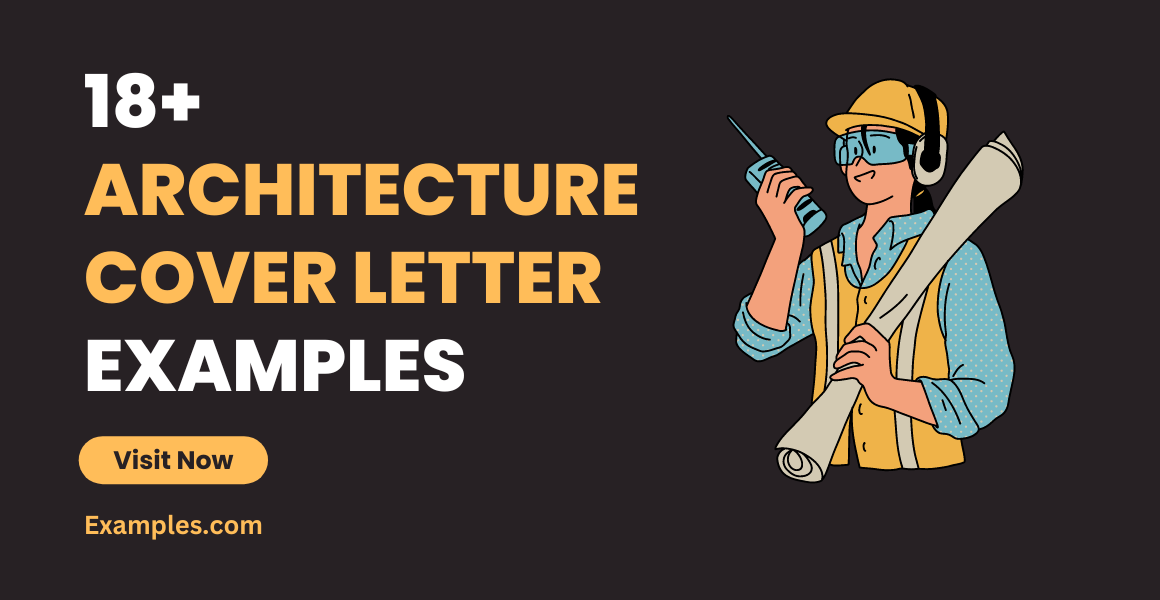
A cover letter serves as a personal introduction to your job application, showcasing not only your qualifications but also your personality. In the architecture field, it’s a critical document that presents your design philosophy, professional accomplishments, and enthusiasm for the role you’re seeking. This article will guide you through various architecture cover letter examples , along with tips to write them effectively.
What is an Architecture Cover Letter?
An architecture cover letter is a tailored letter accompanying your resume when applying for positions related to architecture, design, or construction. It details your relevant experience, skills, and aspirations, connecting them specifically to the role and company you’re targeting. A well-crafted great cover letter can set you apart from other applicants, offering a personalized glimpse into why you’re the perfect fit.
What is a good Example of an Architecture Cover Letter?
Dear [Recipient’s Name],
I am writing to apply for the Architect position at [Company Name]. With a Bachelor’s degree in Architecture and 6 years of experience at a leading design firm, I have honed my skills in sustainable design, project management, and collaboration.
My portfolio includes diverse residential and commercial projects, reflecting innovation and functionality. I admire [Company Name]’s commitment to cutting-edge design, and I believe my expertise aligns perfectly with your values.
Thank you for considering my application. I look forward to potentially contributing to [Company Name]’s esteemed legacy.
Sincerely, [Your Name]
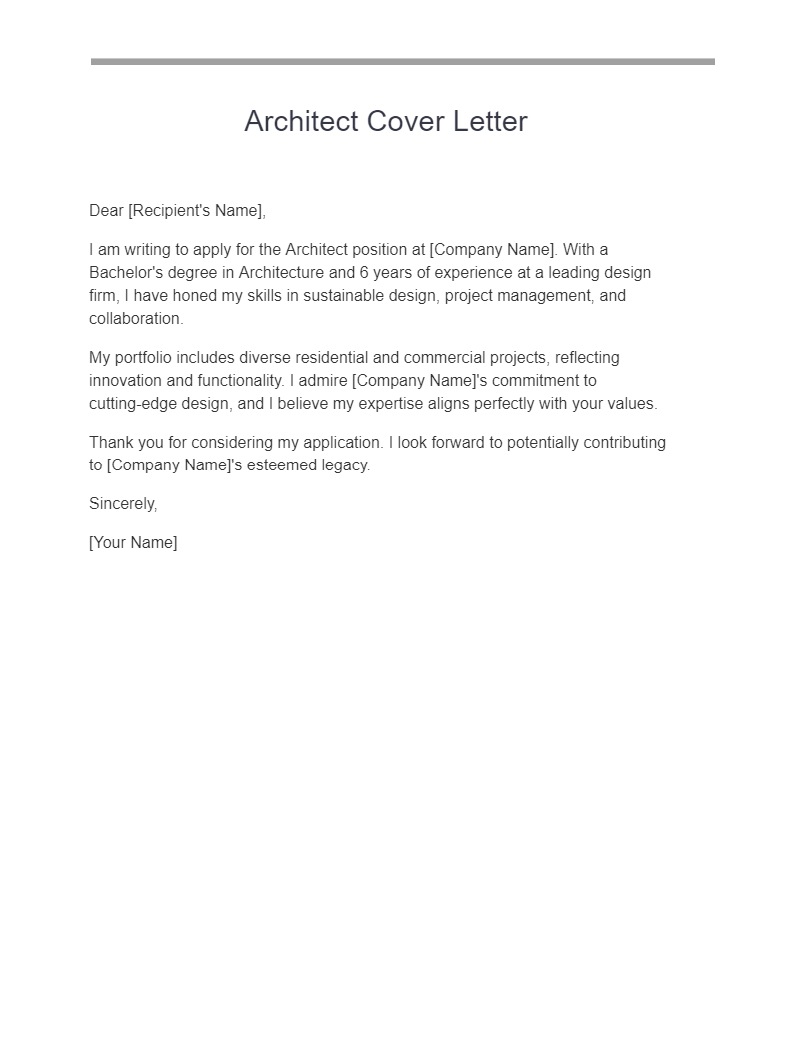
Size: 26 KB
Free Architecture Cover Letters – Copy & Paste
While the following professional cover letter examples can serve as a starting point, it’s essential to tailor each cover letter to the specific job and company you’re applying to.
Architecture Cover Letter Format
[Your Name] [Address] [City, State ZIP] [Phone Number] [Email Address]
[Recipient’s Name] [Title] [Company Name] [Address] [City, State ZIP]
[Opening paragraph: Briefly introduce yourself, the position you’re applying for, and how you heard about it.]
[Second paragraph: Discuss your qualifications, experience, and why you’re interested in the company.]
[Third paragraph: Explain how your skills align with the company’s mission and how you can contribute to their success.]
[Closing paragraph: Express your enthusiasm, propose next steps (e.g., an interview), and thank the recipient.]
Sincerely, [Signature if sending a hard copy]
[Your Name]
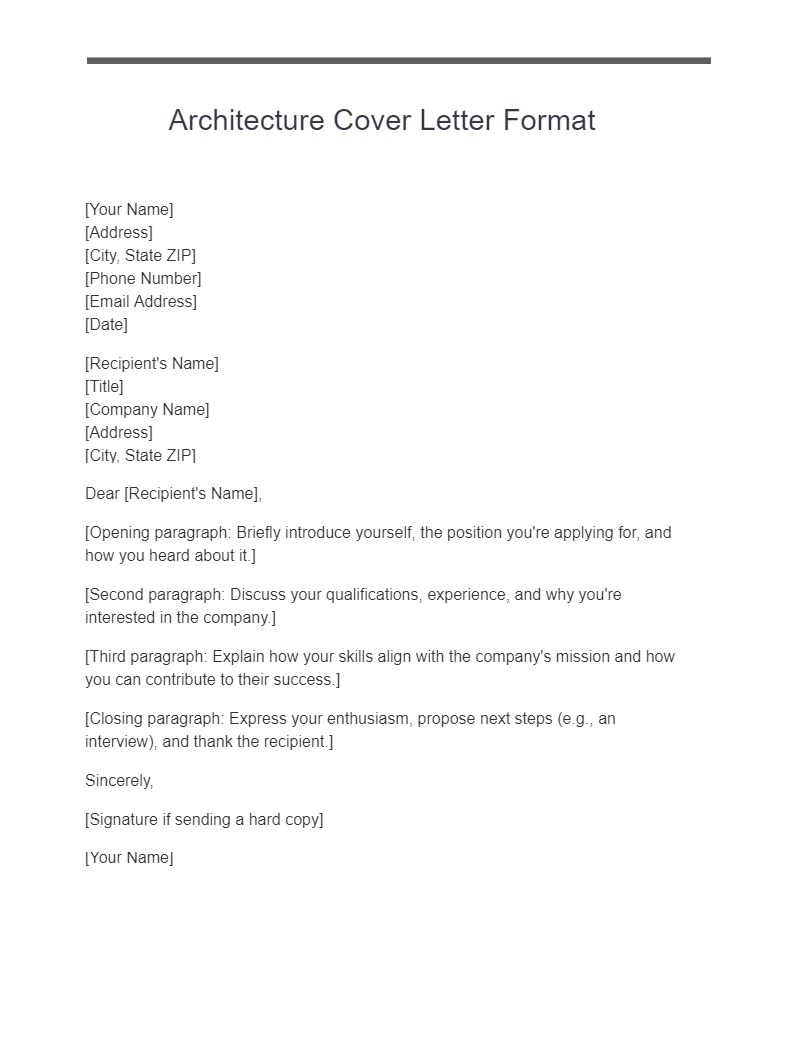
Entry Level Architecture Cover Letter Example
As a recent graduate from [University], with a degree in Architecture, I am eager to start my career at [Company Name]. I have gained hands-on experience through internships, honing skills in CAD design, site analysis, and team collaboration.
I believe my fresh perspective and dedication to learning can contribute to [Company Name]’s innovative projects. I look forward to the opportunity to prove myself as an asset to your talented team.
Focus on your educational background, relevant internships, and willingness to learn. Show enthusiasm for the opportunity to contribute and grow with the company. You may also see Fresher Cover Letter Examples .
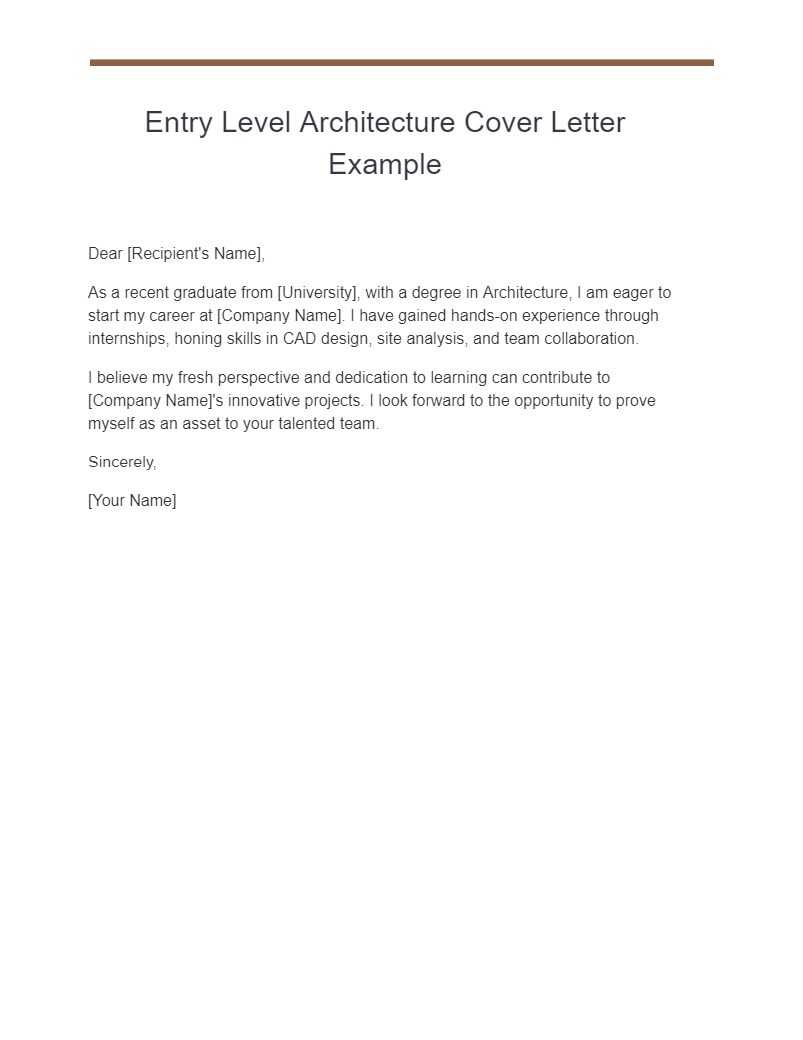
Size: 24 KB
Sample Architecture Cover Letter Example
I am excited to apply for the [Specific Position] at [Company Name]. With 8 years of experience in various architecture firms, I’ve developed a strong background in [mention key skills, e.g., urban planning, residential design].
Your company’s approach to [specific aspect, e.g., sustainability] resonates with my own values. My enclosed portfolio showcases projects aligning with your mission.
I am eager to discuss how my skills and vision can contribute to [Company Name]. Thank you for your consideration.
This sample can be adapted to various roles. Focus on aligning your key skills and values with the company’s mission and the specific position you’re seeking.
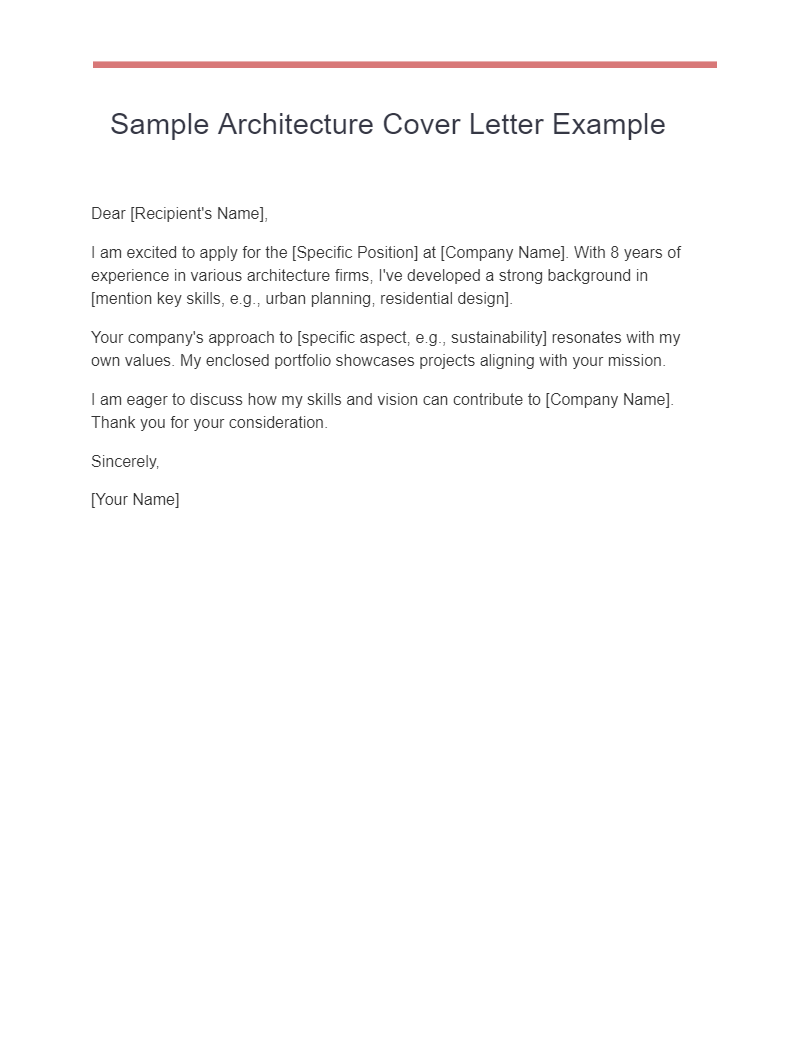
Architecture Cover Letter without Experience Example
Though I am new to the professional architecture field, my academic background and passion for design make me an excellent candidate for the [Position Name] at [Company Name]. My studies at [University Name] provided me with a strong understanding of architectural principles.
I am confident that my fresh perspective and drive to excel will allow me to contribute to your team and learn rapidly.
Thank you for considering my application. I look forward to the chance to prove my potential at [Company Name].
In No experience cover letter , emphasize your education, passion, and willingness to learn and contribute. Show eagerness to prove your potential.

Size: 27 KB Download
Architecture Cover Letter with Experience Example
With 10 years of architectural experience, I have led teams, overseen complex projects, and consistently met client expectations. I am now seeking new challenges as [Position Name] at [Company Name].
Your company’s reputation for excellence aligns with my career goals. My diverse portfolio, attached, showcases my adaptability and proficiency in various architectural domains.
I look forward to potentially bringing my leadership and creativity to [Company Name]. Thank you for considering my application.
With experience, highlight leadership skills, successful project management, and alignment with the company’s values.
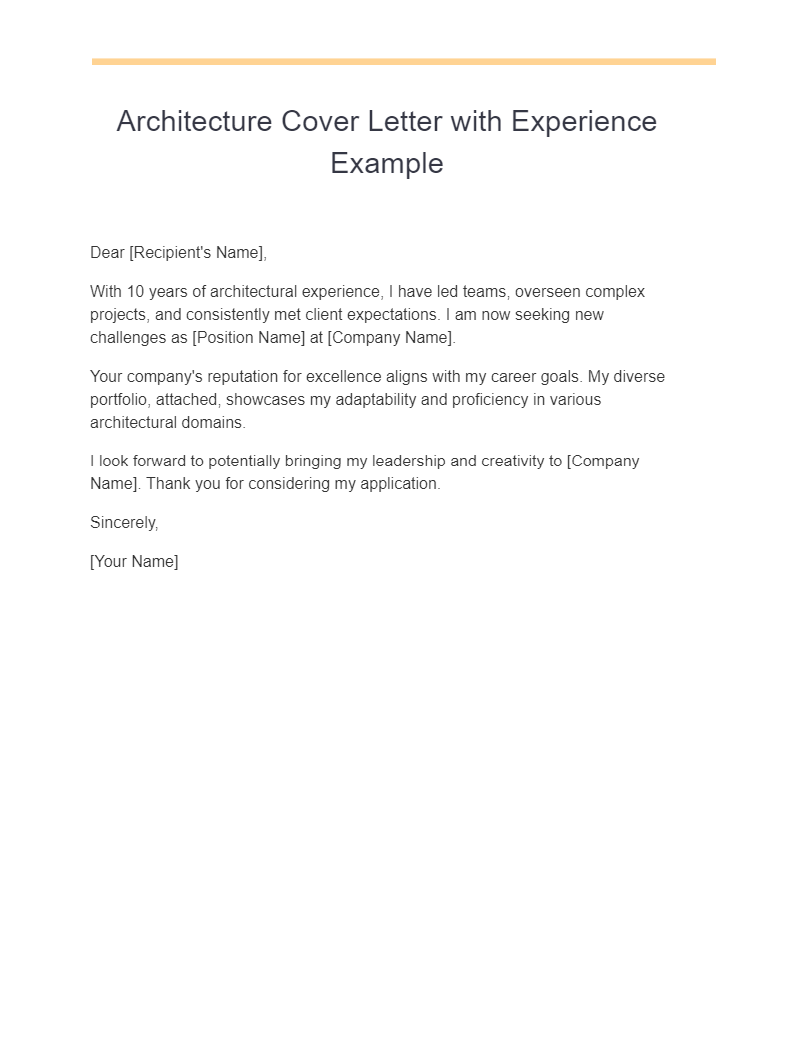
Architecture Cover Letter for Internship Example
I am writing to apply for the Architecture Intern position at [Company Name]. As a third-year student at [University Name], I have developed foundational skills in architectural design and theory.
My academic projects have cultivated creativity, problem-solving, and collaboration, skills I’m eager to apply at [Company Name]. I admire your firm’s innovative work and would be honored to learn from your talented team.
Thank you for considering my application.
When applying for an internship, in internship cover letter you can emphasize academic achievements, relevant coursework, and eagerness to learn from professionals in the field.
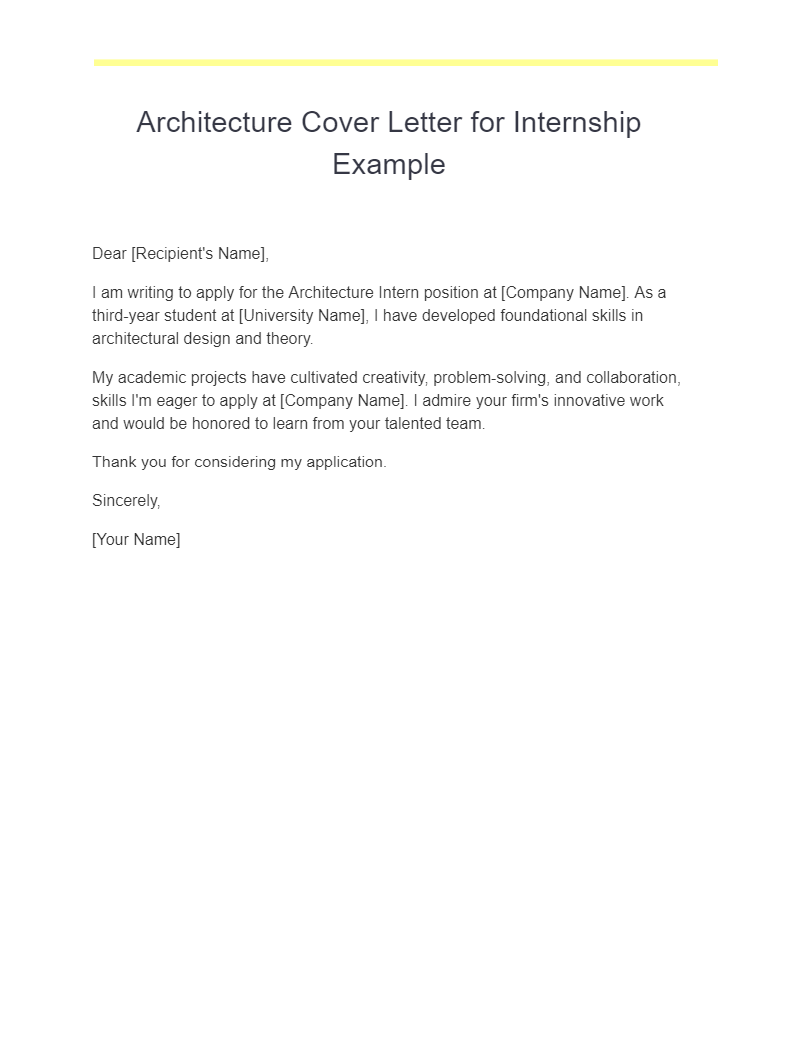
Size: 25 KB
Junior Architect Cover Letter Example
I am applying for the Junior Architect position at [Company Name]. With a Master’s degree in Architecture and two years of professional experience, I have a solid foundation in design principles and project management.
Working at [Previous Company], I contributed to several successful projects, showcasing my ability to adapt and innovate. I am confident that my skills and enthusiasm would make me an asset to [Company Name]’s team.
I look forward to the opportunity to contribute to your outstanding projects.
Focus on your education and early-career experiences, showcasing adaptability, innovation, and a willingness to contribute.
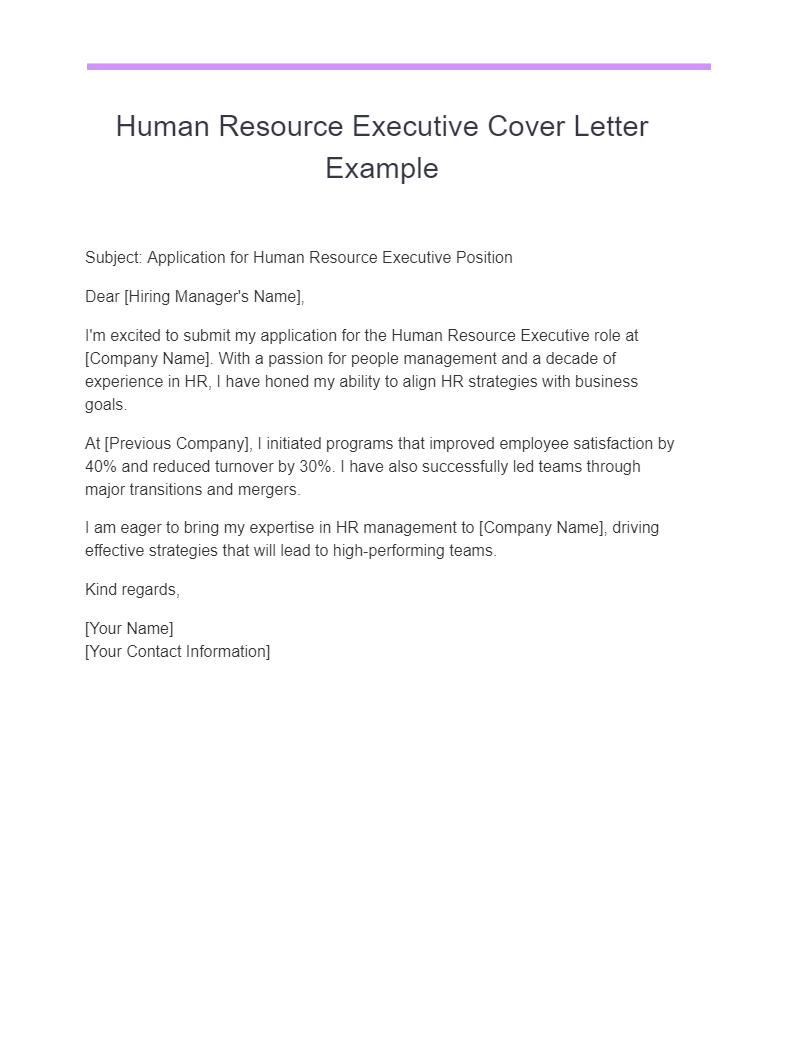
Size: 27 KB
Architecture Job Cover Letter Example
I am writing to express my interest in the [Specific Job Title] position at [Company Name]. With over 5 years of professional experience in architectural design, I have honed my skills in [mention specific areas, e.g., 3D modeling, construction documentation].
I have long admired [Company Name]’s commitment to creative excellence. I believe my unique skill set and passion align perfectly with your team, and I would be thrilled to contribute to your continued success.
Thank you for considering my application. I hope to have the opportunity to further discuss my qualifications with you.
This general architect cover letter example can be customized for different job titles. Emphasize specific skills, alignment with company values, and a desire to contribute.
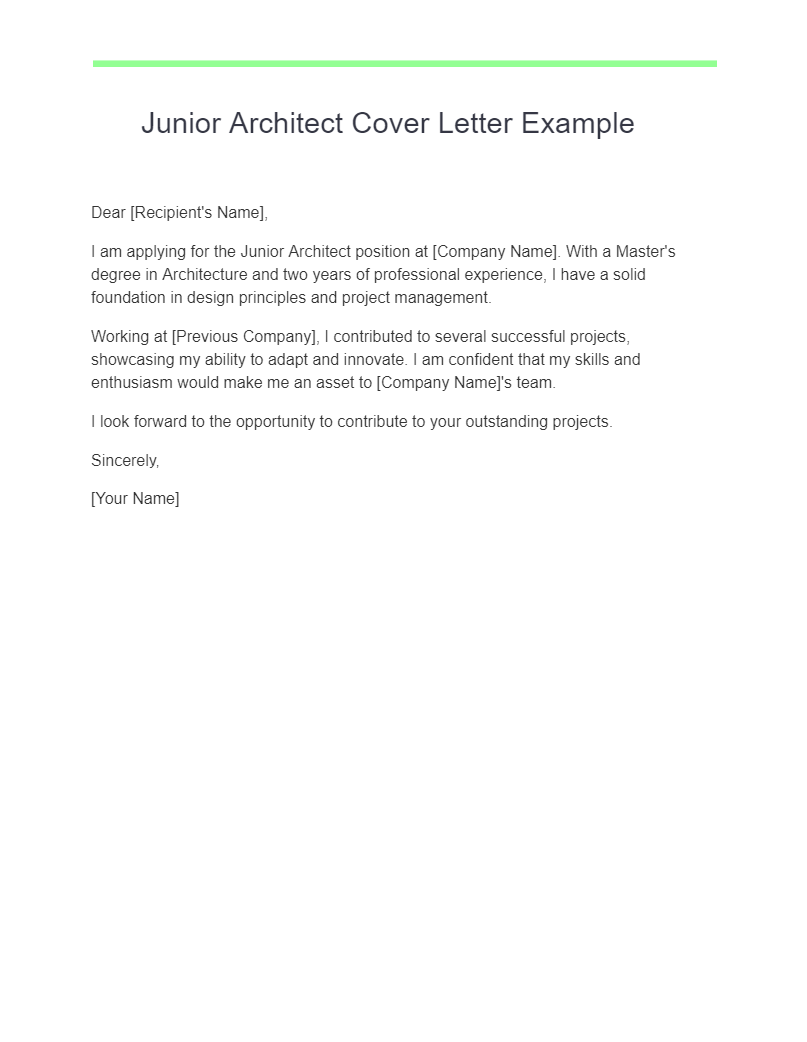
Architecture Cover Letter for Job Application Example
I am applying for the Architectural Designer role at [Company Name], a position advertised on your company’s careers page. My extensive experience in residential and commercial design, coupled with my passion for green architecture, aligns seamlessly with your organization’s mission.
At [Previous Company], I led a team that successfully completed numerous projects on time and within budget. My dedication to client satisfaction and collaboration across departments has garnered repeat business and accolades.
I would be honored to bring my skills and dedication to [Company Name]. I look forward to discussing my application further.
This cover letter for job application example emphasizes alignment with the company’s mission and showcases leadership skills. It’s suitable for experienced candidates applying for specific roles.

Architecture Cover Letter for Resume Example
Enclosed is my resume for the position of [Position Name] at [Company Name]. My background in architectural design, project management, and sustainable practices has prepared me for challenges and growth within your esteemed organization.
I’ve managed projects from conception to completion, working closely with clients and cross-functional teams. My hands-on approach and commitment to excellence have contributed to my career success.
I eagerly await the opportunity to further discuss how I can contribute to [Company Name]’s growth and success.
This cover letter accompanies a resume , highlighting experiences and skills relevant to the position. It demonstrates readiness to discuss contributions and fit.
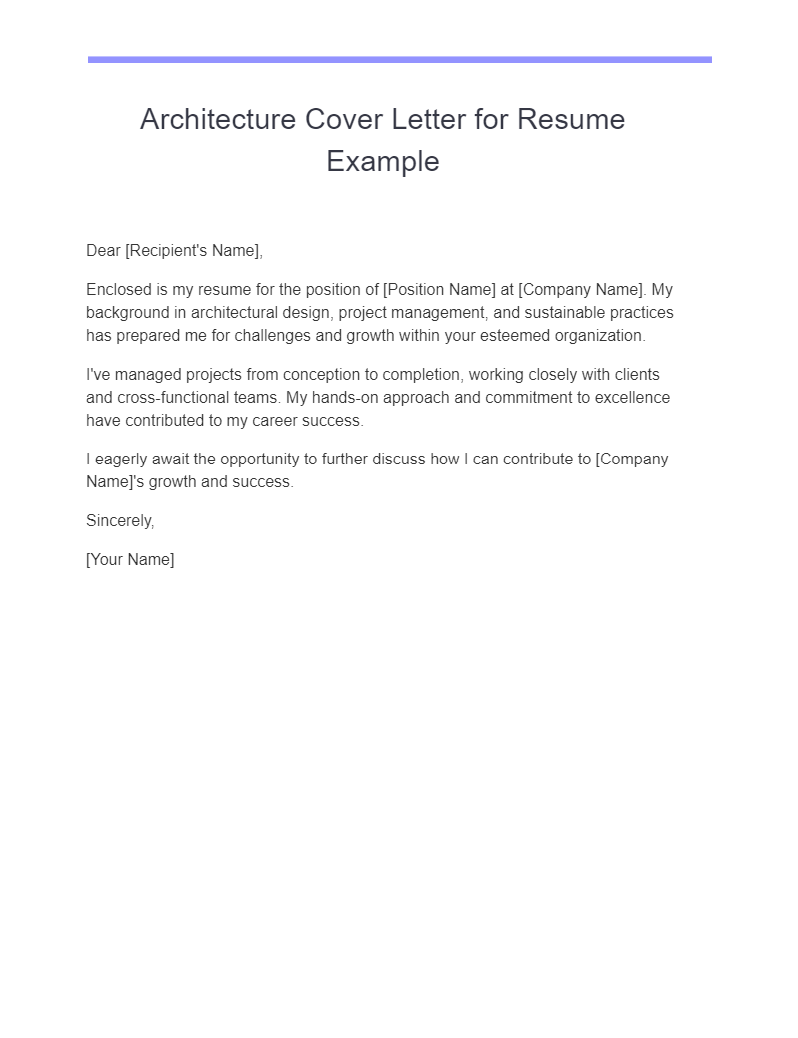
Professional Architecture Cover Letter Example
As a licensed Architect with over 15 years of professional experience, I am seeking new challenges as a Senior Architect at [Company Name]. My extensive portfolio, including commercial, residential, and public projects, demonstrates my versatility and commitment to architectural excellence.
Your company’s innovative design philosophy and commitment to sustainable practices resonate with my professional ethos. I am confident that my leadership, technical expertise, and passion for collaboration would make a significant contribution to your team.
I look forward to the opportunity to contribute to [Company Name]’s continued success.
Tailored for seasoned professionals, this example emphasizes experience, expertise, and alignment with the company’s values.

Undergraduate Architecture Cover Letter Example
As an undergraduate student majoring in Architecture at [University Name], I am eager to apply for the Intern Architect position at [Company Name]. My academic pursuits have cultivated a deep understanding of architectural concepts, 3D modeling, and design innovation.
Your firm’s commitment to mentoring young architects excites me, and I believe that working under your expert guidance would be an unparalleled learning experience.
Thank you for considering my application. I look forward to potentially growing and contributing at [Company Name].
Focus on academic experiences, interest in learning, and excitement about the firm’s commitment to nurturing young talent.
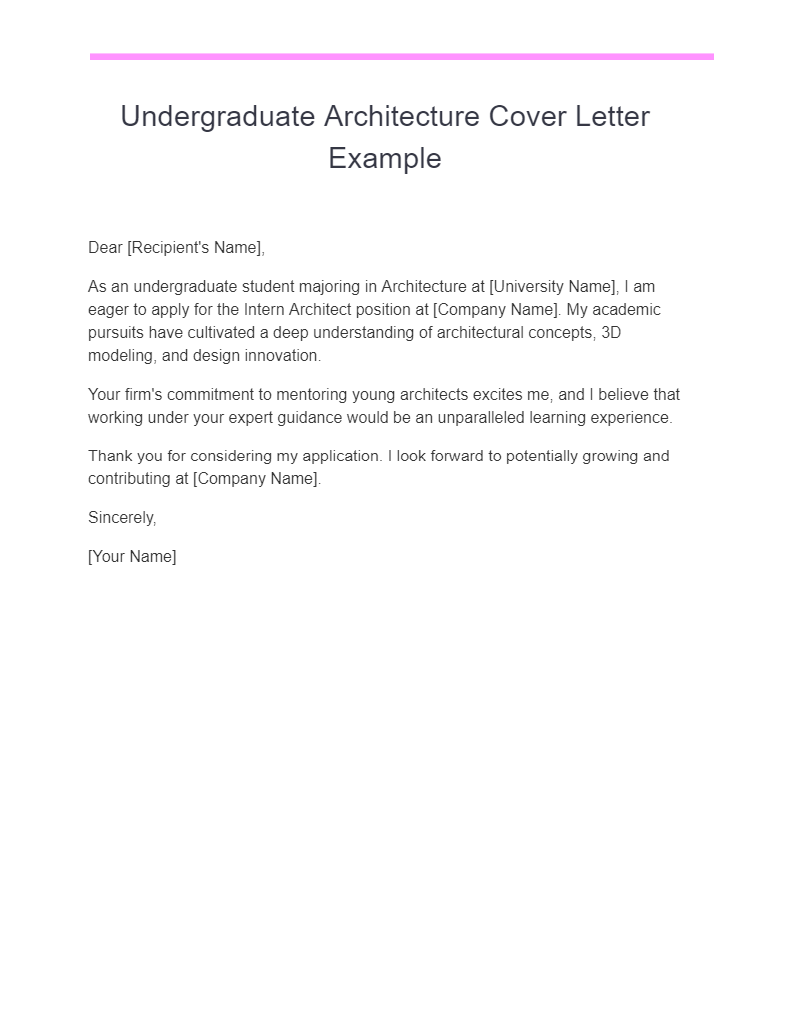
Interior Design Cover Letter Example
I am writing to apply for the Interior Designer position at [Company Name]. With a degree in Interior Design and 5 years of hands-on experience, I have a keen eye for aesthetics and functionality.
I’ve successfully transformed spaces in various sectors, including hospitality, residential, and commercial, always aligning with client needs and budget constraints. [Company Name]’s reputation for innovation inspires me, and I believe my creativity and expertise would fit perfectly within your team.
Suitable for interior designers, this example emphasizes creativity, client satisfaction, and alignment with the company’s innovative reputation.
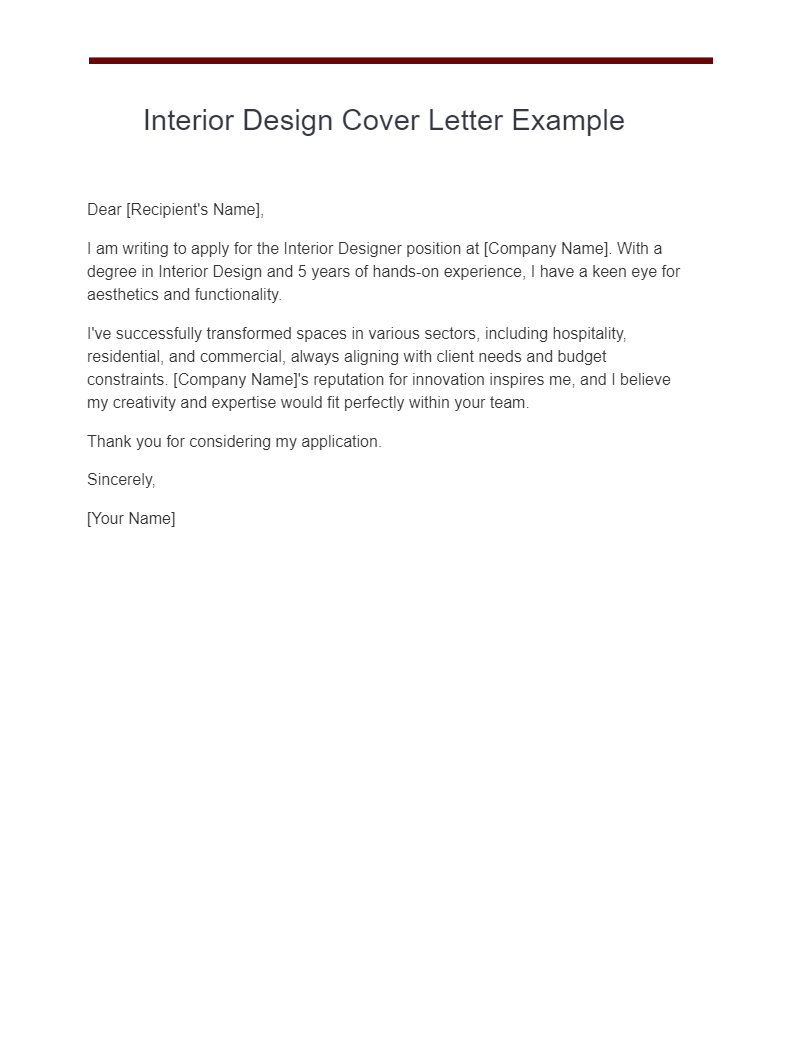
Creative Cover Letter for Architecture Job Example
As an Architect with a flair for creative design solutions, I am thrilled to apply for the [Position Name] at [Company Name]. My portfolio showcases unique and thoughtful designs that prioritize both aesthetics and functionality.
I admire [Company Name]’s adventurous approach to architecture and am confident that my creativity and ability to think outside the box would complement your team’s existing talents.
Let’s explore together how my innovative ideas can contribute to your cutting-edge projects.
Emphasizes creativity, unique designs, and alignment with a company known for innovative approaches.
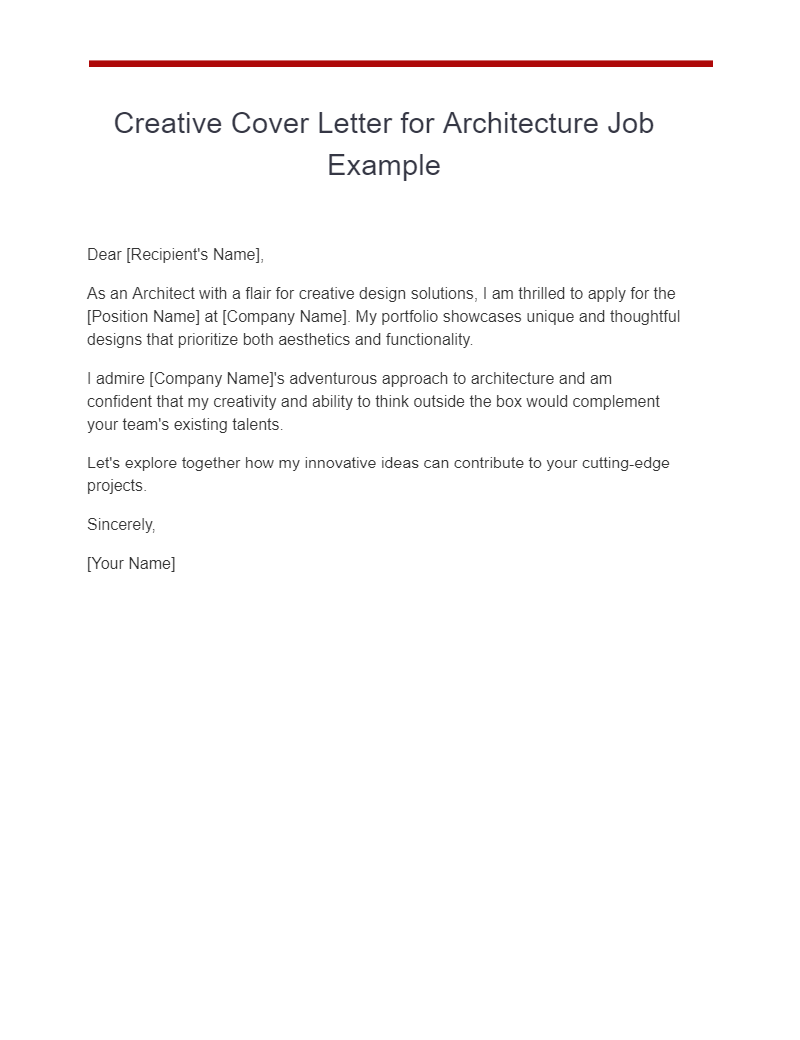
Intern Architect Cover Letter Example
I am applying for the Intern Architect position at [Company Name], an opportunity that excites me due to your firm’s excellence in architectural innovation. As a final-year student at [University Name], I have honed my skills in design, modeling, and project collaboration.
Your commitment to nurturing talent through real-world experience is exactly what I seek as I launch my career. I look forward to the possibility of contributing fresh ideas and learning from your industry-leading team.
Focuses on the excitement for learning, academic preparation, and alignment with the company’s commitment to innovation.
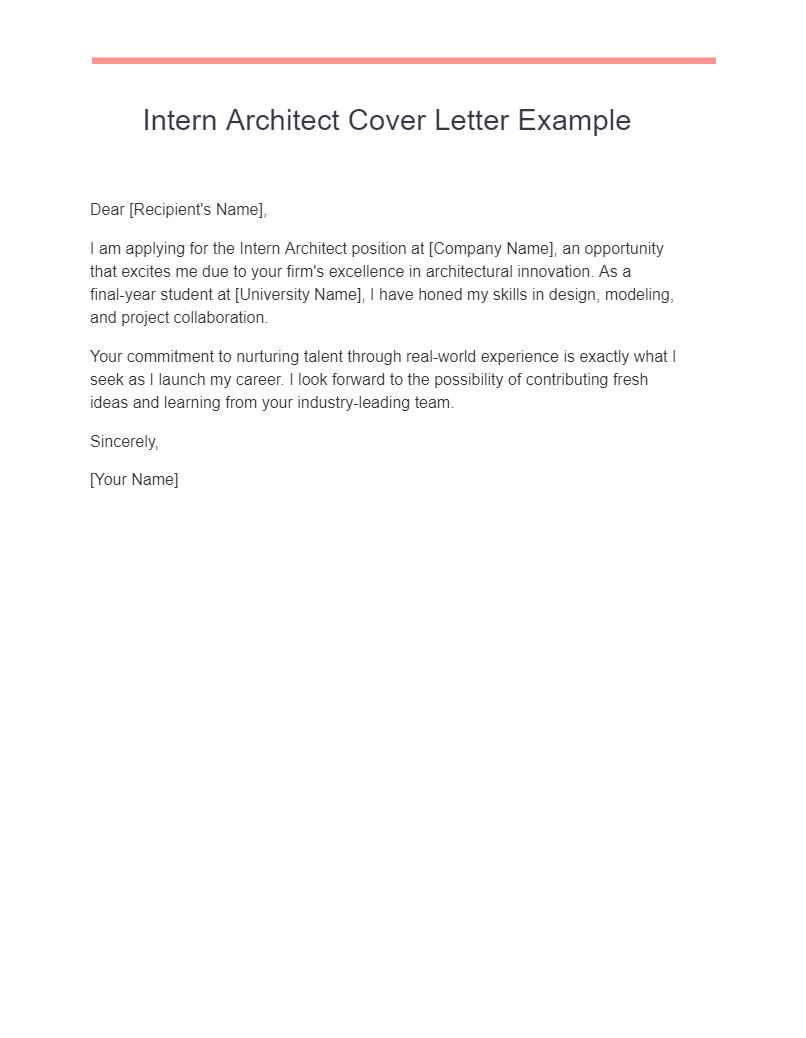
Project Manager Cover Letter Example
I am writing to apply for the Project Manager position at [Company Name]. My extensive experience in managing architectural projects from conception to completion positions me as an ideal candidate.
In my previous role, I successfully led teams, coordinated with clients, and ensured compliance with all regulations. My proven track record of delivering high-quality results on time and within budget reflects my dedication to excellence.
I am confident that my skills and experiences align with your company’s values, and I look forward to the opportunity to drive success at [Company Name].
Suitable for experienced project managers, this project manager cover letter emphasizes leadership, successful project completion, and alignment with company values.

Architecture Student Cover Letter Example
Dear [Hiring Manager’s Name],
I am writing to express my strong interest in the architecture internship opportunity at [Company Name], as advertised on [Source]. As a passionate and driven architecture student at [University Name], I am excited about the possibility of contributing my skills to your esteemed firm.
Throughout my academic journey, I have developed a keen eye for design and a solid foundation in architectural principles. My coursework and hands-on projects have equipped me with proficiency in software such as AutoCAD, SketchUp, and Adobe Creative Suite. I am particularly drawn to [Company Name] for its innovative approach to sustainable design, which aligns perfectly with my values.
During my recent involvement in a collaborative studio project, I had the opportunity to work closely with a diverse team to design a community center that integrated seamlessly with its surroundings. This experience honed my ability to communicate effectively, collaborate with peers, and manage deadlines – skills that I believe are essential for success in a professional setting.
I am confident that my academic background, coupled with my enthusiasm for design excellence, makes me a strong candidate for an internship at [Company Name]. I am excited to contribute fresh ideas, learn from experienced professionals, and grow as an architect.
Thank you for considering my application. I look forward to the opportunity to discuss how my skills and passion align with [Company Name]’s vision. Enclosed is my resume for your review. I can be reached at [Your Phone Number] or [Your Email Address].
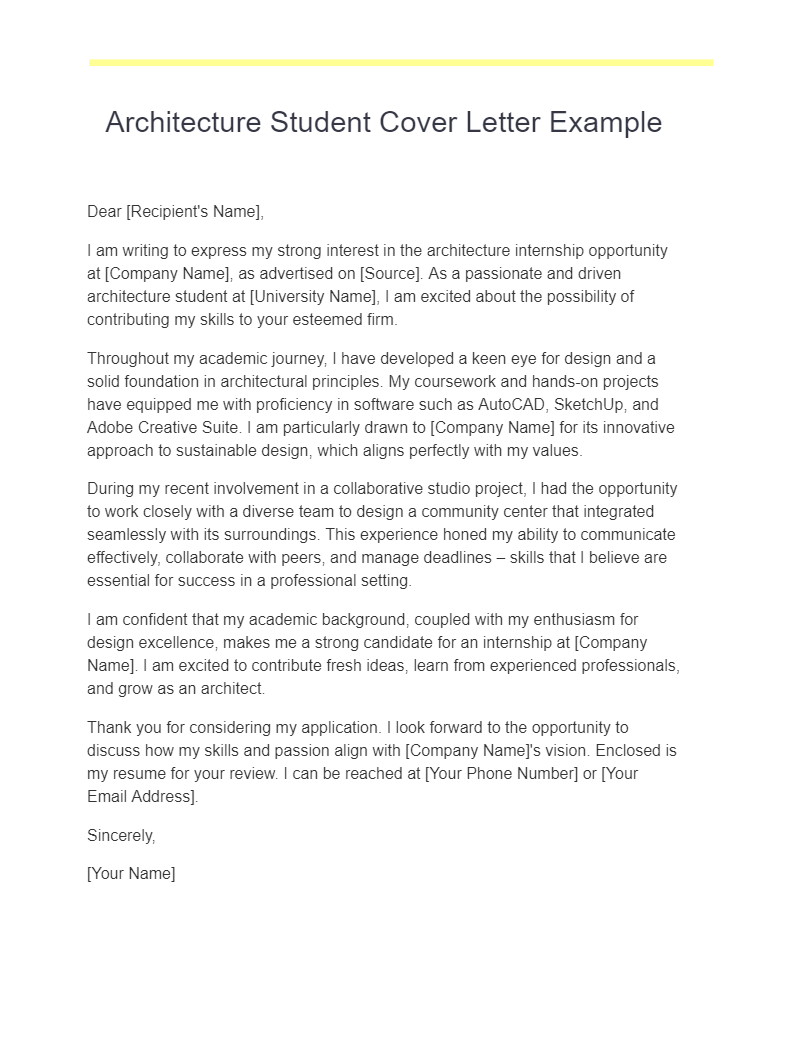
Architecture Student Cover Letter Internship Example
I am writing to express my strong interest in the architecture internship position at [Company Name], which I discovered through [Source]. As a dedicated architecture student with a passion for innovative design solutions, I am eager to contribute to your team and gain hands-on experience in the field.
Throughout my academic journey at [University Name], I have honed my skills in architectural drafting, 3D modeling, and conceptual design. My coursework has not only provided me with a solid foundation in architectural theory but has also ignited my curiosity to explore sustainable and user-centric design principles.
I am particularly drawn to [Company Name] for its reputation in pushing the boundaries of design excellence. Your recent project [Project Name], which seamlessly merges aesthetics with functionality, left a lasting impression on me. I am excited about the prospect of learning from your talented architects and contributing my own fresh perspective.
During my time as a member of [University Name]’s Architecture Club, I collaborated with peers on various design challenges, including reimagining public spaces and optimizing urban environments. This experience has honed my ability to work collaboratively, communicate ideas effectively, and manage project timelines.
I am excited about the opportunity to contribute my creativity and dedication to [Company Name] as an intern. Enclosed is my resume, which further outlines my academic achievements and relevant skills. I welcome the chance to discuss how I can contribute to your team’s success. Please feel free to contact me at [Your Phone Number] or [Your Email Address].
Thank you for considering my application. I look forward to the possibility of contributing to [Company Name]’s impressive portfolio and gaining invaluable industry insights.
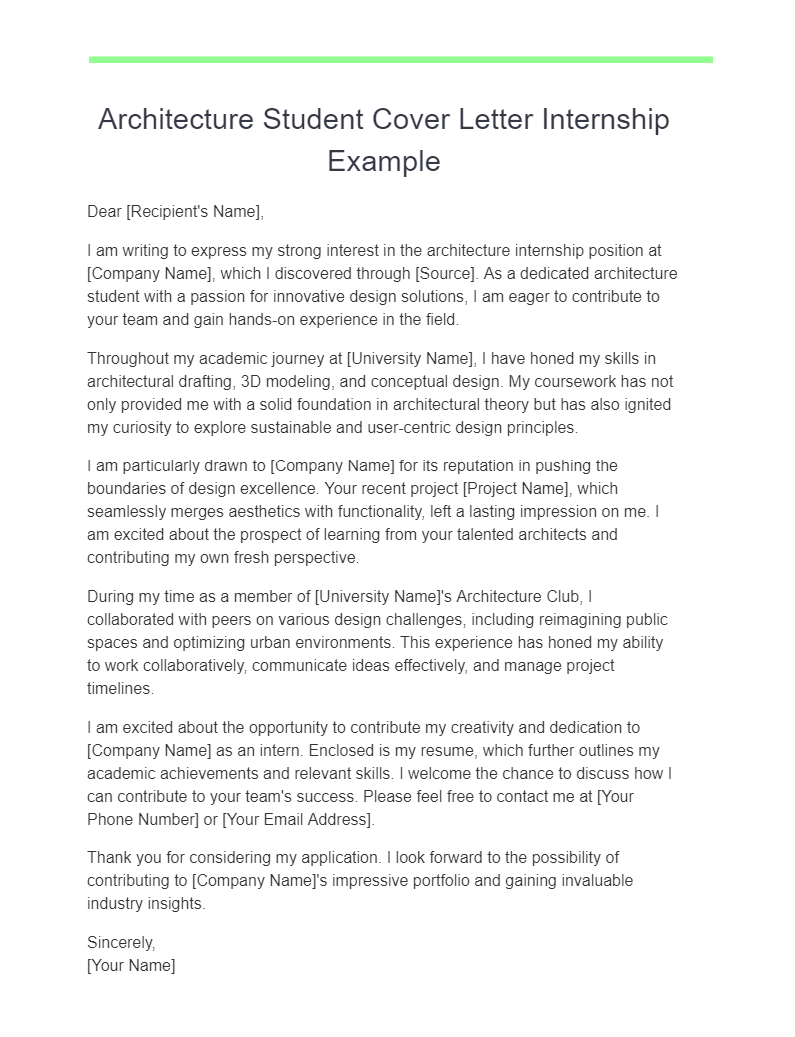
Size: 28 KB
Architectural Cover Letter Example
I am writing to express my keen interest in the Architect position at [Company Name], as advertised on [Job Board/Company Website]. With over [Number of Years] years of experience in architectural design and project management, I am confident in my ability to contribute to your esteemed firm’s continued success.
Having worked on a diverse range of projects, from commercial complexes to residential developments, I am well-versed in creating functional spaces that harmoniously blend aesthetics and functionality. Your firm’s innovative approach to sustainable architecture resonates deeply with my design philosophy, and I am excited about the possibility of joining your team.
Throughout my career, I have successfully led cross-functional teams to deliver projects on time and within budget. Notably, my involvement in the [Project Name] showcased my ability to transform complex design challenges into actionable plans, resulting in a 20% reduction in construction costs while maintaining design integrity.
I am drawn to [Company Name] for its reputation as an industry leader in pushing design boundaries. The [Project Name] stands as a testament to your firm’s commitment to creating environments that inspire and endure. I am excited about the opportunity to collaborate with your talented architects and contribute to your visionary projects.
Enclosed is my resume, which provides a comprehensive overview of my professional journey and accomplishments. I would welcome the opportunity to discuss how my experience aligns with [Company Name]’s goals and how I can contribute to your upcoming projects.
Thank you for considering my application. I look forward to the possibility of contributing my expertise to your dynamic team. Please feel free to contact me at [Your Phone Number] or [Your Email Address] to schedule a conversation.
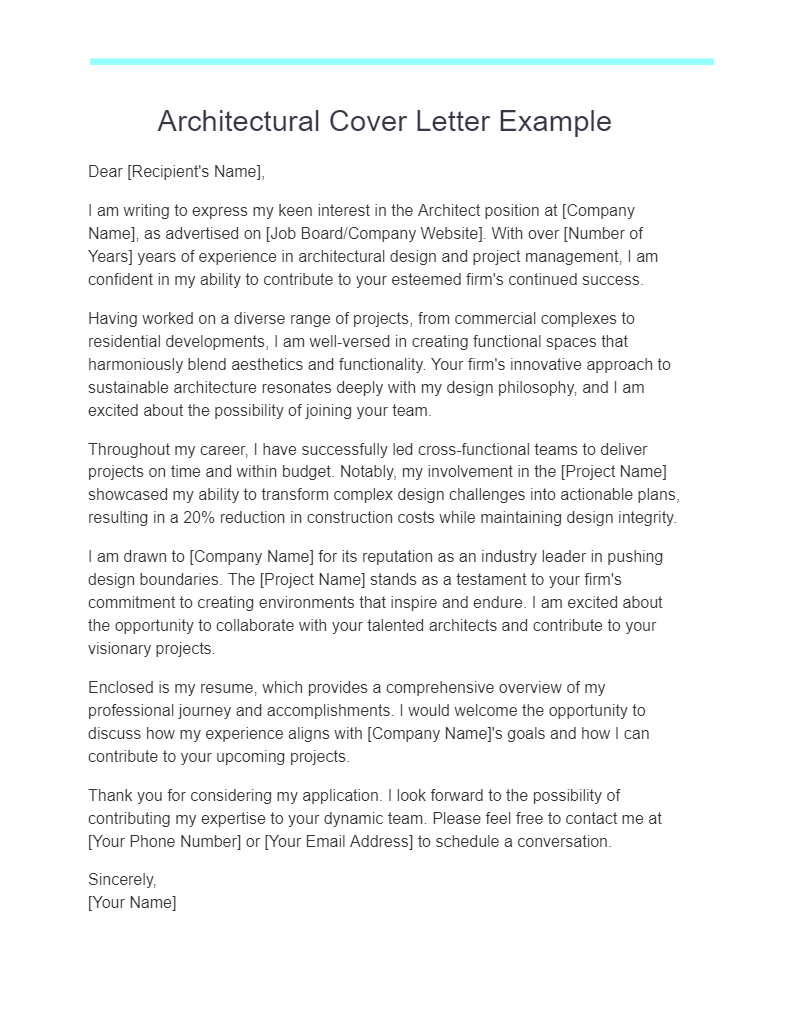
Size: 29 KB
What do you write in a Cover Letter for an Architect?
When crafting a cover letter for an architect, ensure it showcases your skills, experience, and passion for design. Highlight your project portfolio, software proficiency, and ability to collaborate in cross-functional teams. Tailor your letter to the company’s values and projects, demonstrating how your expertise aligns with their vision.
How Do I Write a Good Cover Letter for Architecture?
Writing a compelling cover letter for architecture requires a structured approach:
1. Introduction: Begin with a strong opening that captures the reader’s attention. 2. Personalization: Address the hiring manager by name and mention the specific role you’re applying for. 3. Showcase Your Expertise: Highlight your architectural skills, project experience, and software proficiency. 4. Company Alignment: Explain why you’re interested in the company and how your values align with their projects. 5. Tailor to the Role: Connect your skills to the job requirements and emphasize how you can contribute. 6. Project Highlights: Provide examples of significant projects you’ve worked on and your role in them. 7. Leadership and Collaboration: Mention any leadership roles and your ability to collaborate effectively. 8. Software Proficiency: Highlight your proficiency in relevant software, such as AutoCAD, Revit, or SketchUp. 9. Closing: Express enthusiasm for the role, invite further discussion, and include your contact details.
Tips for Writing an Architecture Cover Letter
1. Research the Company: Understand the company’s values, projects, and recent achievements. 2. Personalize Each Letter: Address the hiring manager by name and tailor the content to the company’s needs. 3. Highlight Your Portfolio: Showcase relevant projects and explain your role and contributions. 4. Match Keywords: Incorporate keywords from the job description to show alignment with the role. 5. Show Enthusiasm: Convey your passion for architecture and the company’s work. 6. Be Concise: Keep the cover letter focused and concise, highlighting key points. 7. Proofread: Check for spelling, grammar, and formatting errors before submitting. 8. Quantify Achievements: Use numbers to quantify your accomplishments, such as project sizes or completion times.
Crafting a standout architecture cover letter involves showcasing your skills, aligning with the company’s vision, and demonstrating your passion for innovative design. Tailor each letter to the role, highlighting relevant experience and project achievements. By following these tips, you can create a compelling cover letter that captures the attention of potential employers.
Text prompt
- Instructive
- Professional
Write a cover letter for a college student applying for an internship at an educational technology company
Form a cover letter for a high school student seeking a part-time job at a local bookstore.
Privacy preference center
We care about your privacy
When you visit our website, we will use cookies to make sure you enjoy your stay. We respect your privacy and we’ll never share your resumes and cover letters with recruiters or job sites. On the other hand, we’re using several third party tools to help us run our website with all its functionality.
But what exactly are cookies? Cookies are small bits of information which get stored on your computer. This information usually isn’t enough to directly identify you, but it allows us to deliver a page tailored to your particular needs and preferences.
Because we really care about your right to privacy, we give you a lot of control over which cookies we use in your sessions. Click on the different category headings on the left to find out more, and change our default settings.
However, remember that blocking some types of cookies may impact your experience of our website. Finally, note that we’ll need to use a cookie to remember your cookie preferences.
Without these cookies our website wouldn’t function and they cannot be switched off. We need them to provide services that you’ve asked for.
Want an example? We use these cookies when you sign in to Kickresume. We also use them to remember things you’ve already done, like text you’ve entered into a registration form so it’ll be there when you go back to the page in the same session.
Thanks to these cookies, we can count visits and traffic sources to our pages. This allows us to measure and improve the performance of our website and provide you with content you’ll find interesting.
Performance cookies let us see which pages are the most and least popular, and how you and other visitors move around the site.
All information these cookies collect is aggregated (it’s a statistic) and therefore completely anonymous. If you don’t let us use these cookies, you’ll leave us in the dark a bit, as we won’t be able to give you the content you may like.
We use these cookies to uniquely identify your browser and internet device. Thanks to them, we and our partners can build a profile of your interests, and target you with discounts to our service and specialized content.
On the other hand, these cookies allow some companies target you with advertising on other sites. This is to provide you with advertising that you might find interesting, rather than with a series of irrelevant ads you don’t care about.
Architecture Cover Letter Example
Get the job you've always wanted & learn creative tricks to use in your own cover letter with our free, modifiable Architecture cover letter example. Make a copy of this cover letter sample for free or rewrite it directly in our sleek cover letter maker.

Related resume guides and samples
Useful art director resume writing tips
How to build a professional copywriter resume?
How to craft an impressive graphic designer resume
How to build a powerful interior designer resume
How to write a winning photographer resume?
How to write the perfect product designer CV in 2023
How to create an effective video editor resume
Architecture Cover Letter Example (Full Text Version)
Dear Hiring Manager,
I am excited to express my interest in the Assistant Architect position at your esteemed company. With a proactive approach and a proven track record of exceptional achievements, I am confident that I can bring valuable contributions to your team.
I hold a degree in Architecture from Harvard University, where I graduated in the top 5% of my class and received the Academic Excellence Award. My involvement in various extracurricular activities, such as the Debate Club, Engineering Society, and Riding Society, demonstrates my strong work ethic and leadership skills.
During my tenure as an Assistant Architect at RXR Construction Services, LLC, I honed my skills in project design, surface area planning, report generation, and site visits. I am adept at working under pressure and excel in both independent and team settings. Additionally, I am fluent in Chinese, proficient in English, and have basic knowledge of German. My proficiency in industry software programs like SketchUp, Revit3D, and Autocad further enhance my qualifications for this role.
After carefully reviewing the job description, I am confident that my experience aligns well with the requirements of the position. I am eager to discuss how my background, skills, and enthusiasm can contribute to the success of your team.
I can be reached at the phone number provided and look forward to the opportunity to further discuss my qualifications. Thank you for considering my application.
Sincerely, Zhan Meng

Milan Šaržík, CPRW
Milan’s work-life has been centered around job search for the past three years. He is a Certified Professional Résumé Writer (CPRW™) as well as an active member of the Professional Association of Résumé Writers & Careers Coaches (PARWCC™). Milan holds a record for creating the most career document samples for our help center – until today, he has written more than 500 resumes and cover letters for positions across various industries. On top of that, Milan has completed studies at multiple well-known institutions, including Harvard University, University of Glasgow, and Frankfurt School of Finance and Management.
Edit this sample using our resume builder.
Don’t struggle with your cover letter. artificial intelligence can write it for you..

Similar job positions
Graphic Designer Interior Designer Copywriter Art Director Product Designer Photographer Video Editor
Related graphic designer resume samples

Related interior designer cover letter samples

Let your resume do the work.
Join 5,000,000 job seekers worldwide and get hired faster with your best resume yet.

We use essential cookies to make Venngage work. By clicking “Accept All Cookies”, you agree to the storing of cookies on your device to enhance site navigation, analyze site usage, and assist in our marketing efforts.
Manage Cookies
Cookies and similar technologies collect certain information about how you’re using our website. Some of them are essential, and without them you wouldn’t be able to use Venngage. But others are optional, and you get to choose whether we use them or not.
Strictly Necessary Cookies
These cookies are always on, as they’re essential for making Venngage work, and making it safe. Without these cookies, services you’ve asked for can’t be provided.
Show cookie providers
- Google Login
Functionality Cookies
These cookies help us provide enhanced functionality and personalisation, and remember your settings. They may be set by us or by third party providers.
Performance Cookies
These cookies help us analyze how many people are using Venngage, where they come from and how they're using it. If you opt out of these cookies, we can’t get feedback to make Venngage better for you and all our users.
- Google Analytics
Targeting Cookies
These cookies are set by our advertising partners to track your activity and show you relevant Venngage ads on other sites as you browse the internet.
- Google Tag Manager
- Infographics
- Daily Infographics
- Popular Templates
- Accessibility
- Graphic Design
- Graphs and Charts
- Data Visualization
- Human Resources
- Beginner Guides
Blog Graphic Design 20+ Creative Cover Letter Design Tips & Templates [2024]
20+ Creative Cover Letter Design Tips & Templates [2024]
Written by: Sara McGuire Jan 10, 2024

Are you looking to create a cover letter that will help your job application stand out? You’ve come to the right place.
Cover letters matter because they’re like your chance to say, “Hold up, there’s more to me than what’s on my resume!” They’re your first opportunity to show why you’re the ideal fit for the job and let your personality shine.
Ready to stand out from the job-hunting crowd? Browse and pick from Venngage’s dozens of cover letter templates that you can customize and have ready in no time!
Click to jump ahead :
What is a cover letter?
Cover letter design tips with examples & templates, what should a cover letter design include, how to design a cover letter, how to customize cover letter templates in venngage, 9 tips for writing your cover letter, frequently asked questions about cover letter.
A cover letter is a document sent with your resume to provide additional information about your skills and experience. It’s your opportunity to explain why you’re a good fit for the job you’re applying for and to highlight relevant qualifications. A cover letter should be concise, typically no longer than one page and should be tailored to the specific job and company you are applying to.
Crafting an effective cover letter involves not only strong content but also a professional design. In this section provides, I’ll be sharing some of my favorite tips, examples and templates to help you create a standout cover letter.
Click to jump ahead:
Professional cover letter templates
Simple cover letter templates, free cover letter templates, internship cover letter templates, creative cover letter templates, use a column layout to divide your cover letter into sections.
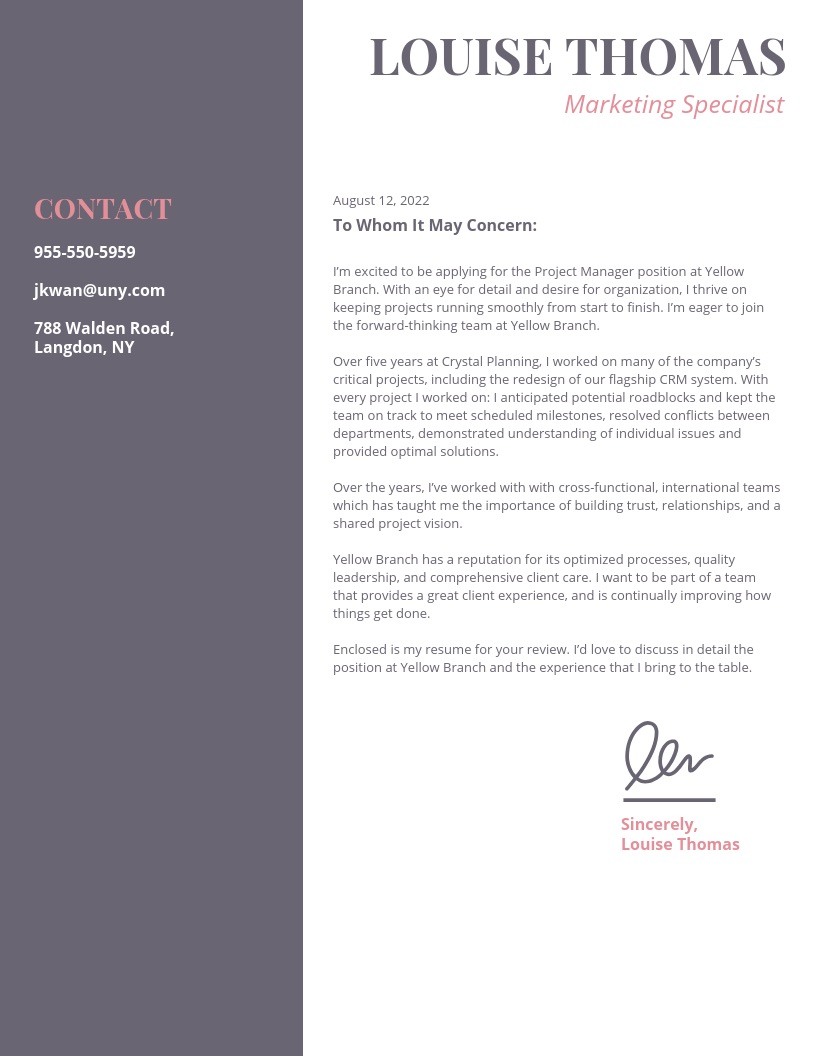
Typically, when you write a cover letter, you will include your contact information in the header or footer. But a visual cover letter offers you the opportunity to use a different page layout.
For example, you could put your contact information in a spinal column at the side of the page. To do this, simply divide your page into columns:

Take a look at how columns are used in the page layout for this cover letter template:

Include a personal logo to make your cover letter more memorable
For example, this cover letter template uses a logo created by putting the applicant’s initial inside a triangle. Simple and sleek:

Creating your own logo might seem like a big task. But it doesn’t have to be complicated. Your logo design could be as simple as a writing your name in a specific brand font , or combining your initial with an icon or shape.
Take some time to draft a few mock ups of your logo. What shapes and font style reflect your personality? Which designs are the most eye-catching and easy to use in other places?
You could use a logo in place of the headshot in this template. Or simply, include your photo:

Design Pro Tip : Use our photo replace feature to quickly add your own headshot to your cover letter. The Venngage online drag and drop editor lets you quickly upload your photo and drag it over the existing headshot. The tool will replace and resize for you.
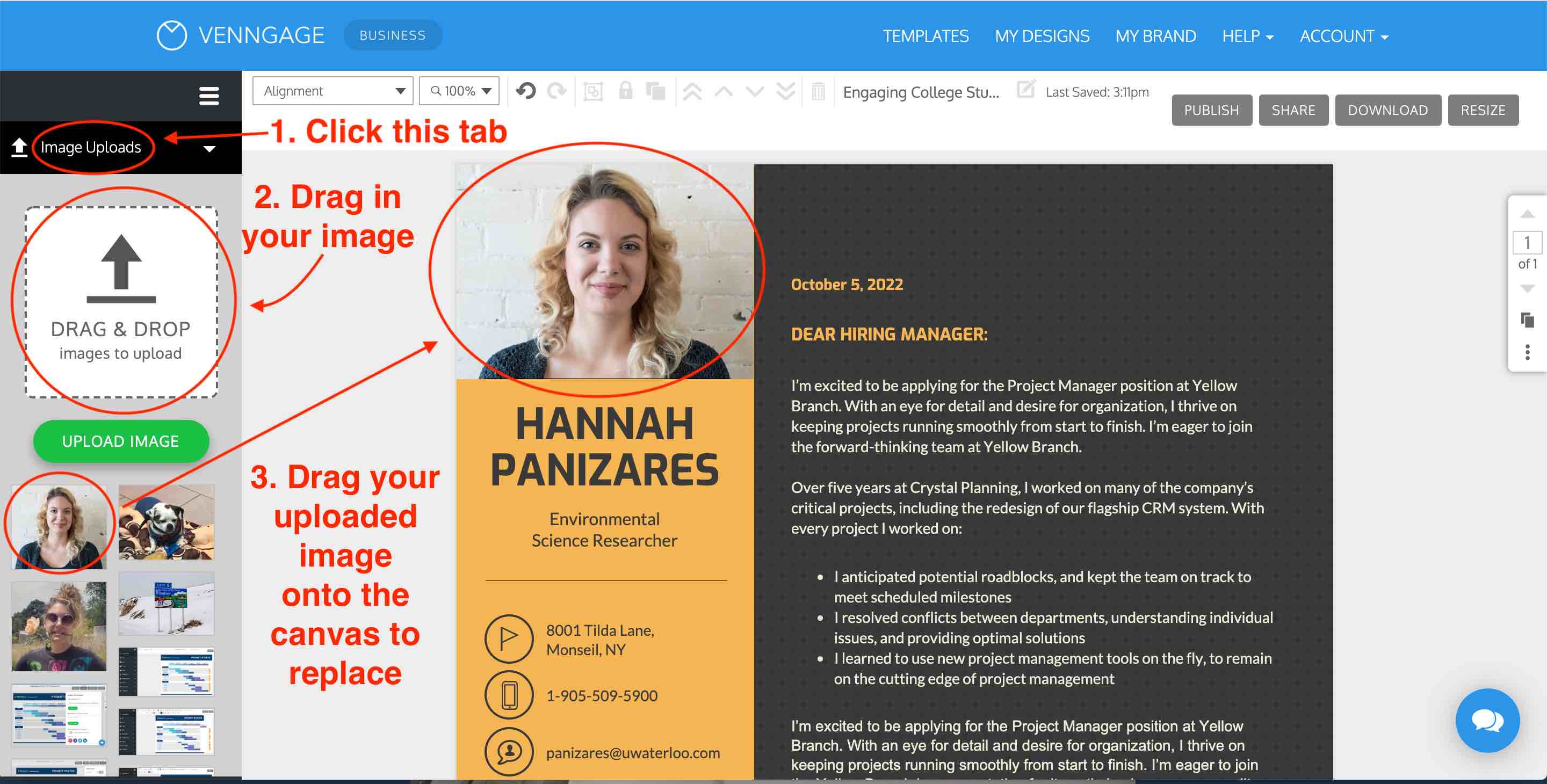
Give your cover letter template a decorative border
This cover letter template uses an image of a map for the border. This could represent the applicant’s career path, their sense of adventure, or the places their experiences have taken them:

Design Pro Tip : Create a border using an image in Venngage’s online editor by placing a rectangle over the background image. If you would like your border to be see-through, simply adjust the opacity of the rectangle.

A border is a simple way to add some creativity to your cover letter, while still maintaining a more traditional design.
An easy and eye-catching approach is to use a background image for your border. Look for an image that reflects your skills, your hobbies or passions, or the industry you’re in or applying for. The meaning of the image can be literal or symbolic — that’s up to you!
Or instead of a border, try adding a footer or sidebar with an image, or in a solid color like this template:

Use up to three different font styles (but no more than that!)
This cover letter template uses an elegant font for the headers and a sans serif font for the body copy (for readability):
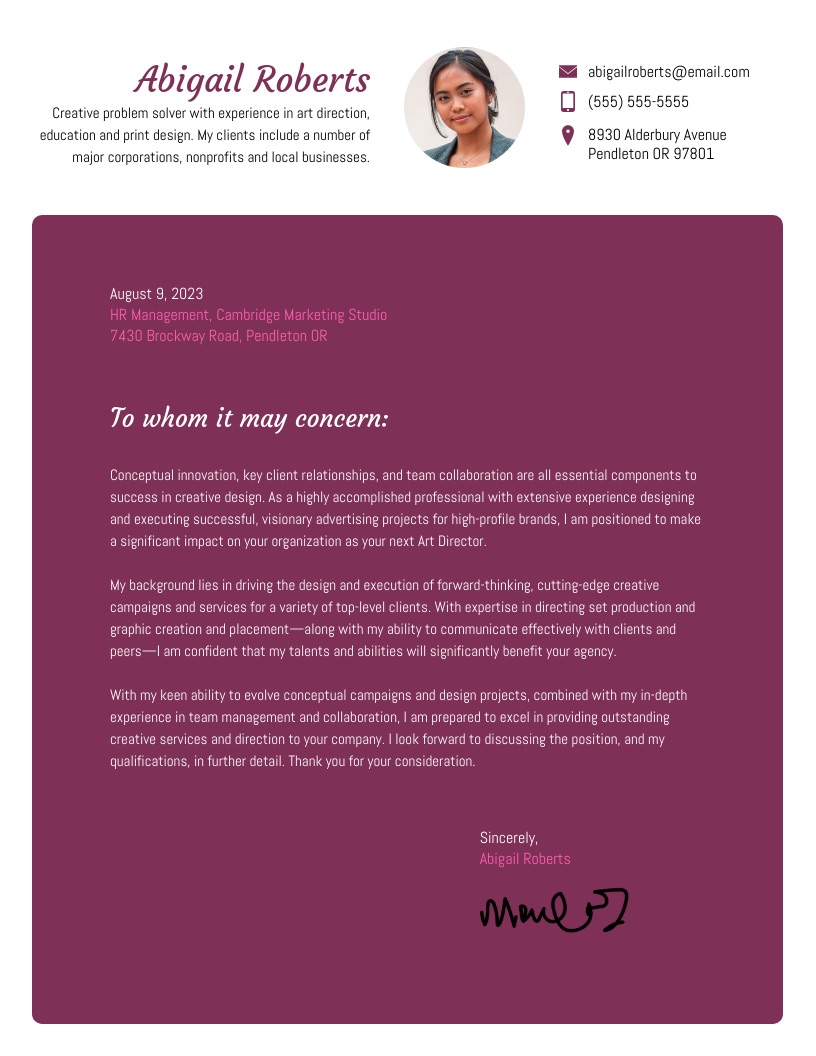
Here’s a design rule of thumb: use no more than three different font types in one design. If you use too many different fonts , your design can look cluttered.
Generally, it’s best to stick to:
- One font for headers
- One font for sub-headers
- One font for body text
For example, this cover letter template uses only two fonts: Poppins for the header and sub-headers, and Merriweather for the body text. By bolding certain headers and using a different brand color for other, the design has variation while still being cohesive:

Highlight your contact information using a bold footer
While a bright, bold header will help grab the attention of readers, a footer will help make sure your cover letter ends on an impressive note. A bold footer can also help highlight key information–like your contact information and availability.
Take a look at how the footer in this cover letter template mirrors the color in the header, while also emphasizing the applicant’s contact information:

Round out your cover letter design with an image
Look at how seamlessly the image at the bottom of this cover letter is incorporated into the design:

An image can add that final touch to your cover letter design. You can use an image to fill up empty space and to reinforce themes in your cover letter.
If you want to show off your creative chops, you could include a photo you’ve taken yourself, or a custom illustration. But when in doubt, you could incorporate a stock photo –as long as it isn’t too cheesy.
No matter what the image is, it’s important that you integrate it cohesively into your page design. That could mean using an image frame to give your image a unique border shape, or using an image with a transparent background.
Add your signature to your cover letter template
Take a look at how this cover letter template incorporates a signature in the footer:

At this point, you may have noticed something that a lot of these cover letters have in common: they include a signature.
While including a signature isn’t a requirement, it can add another personal touch to your cover letter. Personal design touches will help your cover letter be more memorable.
Here’s a perfect example of a cover letter template you can use when applying for an internship or a co-op position:

If you’re applying for your first job as a student, chances are you won’t have much hands-on work experience. In this case, you can talk about your educational qualifications as well as different skills relevant to the job that you’ve obtained from your course work.
In your cover letter, you can also explain what you bring to the table — what you think is important to the job and will make you stand out from other candidates. Take this template as an example:

If you don’t have concrete numbers to back up your work experience, you can talk about what you value and learn from previous experience — as well as what your soft skills are and how they’ll help you in the job you’re applying for.
Add a custom header that illustrates your personal brand
What impression do you want to make on readers of your cover letter? Do you want them to think you’re inventive and take risks? Do you want them to think you’re competent and reliable?
This header uses bright colors and icons to make Sophie seem creative and personable:

Design Pro Tip: Use our icon replace tool to quickly replace any icon in our templates. Click any template here to sign up for free and enter the editor. Then, click an icon to replace it with one of the thousands of icons in our library.
Similar to how you can use an image as a border, you can also create an image header.
When picking an image for your header, look for an image that isn’t too busy. Too much going on will distract from your header text — and the text is the most important part!
For example, this cover letter template uses a tranquil lake scene in the header to show off the applicant’s photography skills:

Or skip the image and separate your header text with a simple line:
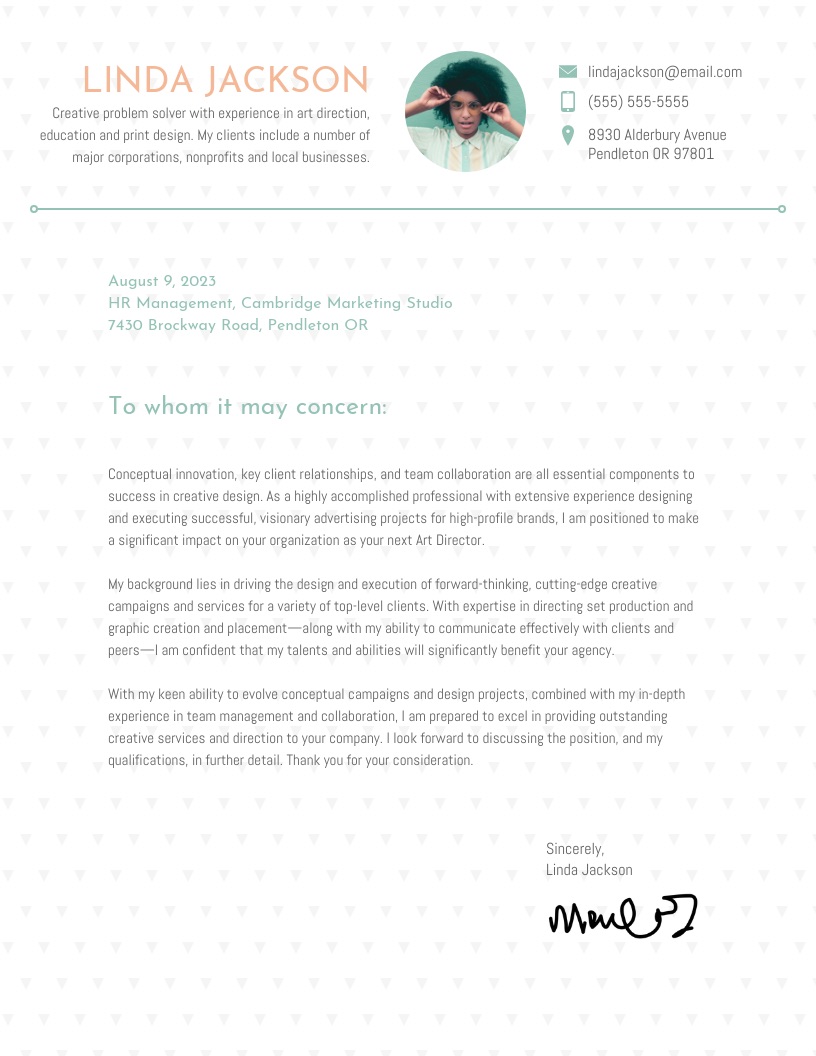
Using a bold header is one way to make your job application stand out, so you don’t hear those dreaded words: “we’ll just keep your resume on file .”
You can also use our customizable letterhead templates to create unique headers.
Use icons to illustrate information like your experience, skills, or passions
Icons are simplified vector graphics used to represent concepts. They’re perfect for adding a bit of creativity to your cover letter design.

You can use icons in a number of ways to enhance your design, including:
- Drawing attention to section headers
- Creating your own custom logo or illustrations
- Emphasizing key points like your contact information
- Replacing bullet points in lists
“Using bullets points where applicable also help to make it a smooth read.”
– Brandon Thompson, Recruitment and Hiring Manager at 1-800-Got-Junk?
In this cover letter template, icons are used in the header to add a bit of color and illustrate the applicant’s experience:

Add an atypical border for a modern cover letter design

Generally speaking, it’s good to play it safe with your cover letter design. That being said, there are small design choices you can make that will have a big impact on your cover letter’s personality.
For example, you can use borders in unusual ways. A simple border used in a surprising way can make your cover letter design more interesting.
For example, instead of using a border around the edges of your page, you could use a border around one section, like the header. Take a look at how this cover letter template uses a strip of purple along the spinal column and crosses it with a border around the header:

A cover letter design should include the following elements:
- Contact Information : Include your name, address, phone number, and email address at the top of the letter.
- Employer’s Contact Information : Include the employer’s name, title, company and address, if known.
- Salutation : Address the letter to a specific person if possible (e.g., “Dear Mr. Smith”).
- Introduction : State the position you are applying for and where you found the job listing.
- Middle paragraphs : Highlight your relevant skills, experiences, and qualifications.
- Closing paragraph : Reiterate your interest in the position, thank the employer for considering your application, and express your desire for an interview.
- Closing : A formal closing phrase (e.g., “Sincerely”) followed by your signature (if submitting a hard copy) and typed name.
- Font and formatting : Use a professional and readable font (e.g., Times New Roman, Arial, or Calibri) in a size between 10 and 12 points. Maintain consistent margins and spacing, typically 1-inch margins and single-spaced text with a double space between paragraphs.
- Visual elements : Use minimalistic and clean design elements, such as a subtle color scheme or a simple border, to make the letter visually appealing without overwhelming the content.
- Header and contact information: At the top of your cover letter, include your name, address, phone number and email, as well as the date of your application.
- Salutation: Begin the letter by addressing the hiring manager by their name if it’s available or use a generic “Dear Hiring Manager” if you don’t know their name.
- Content: Start with an engaging opening paragraph that clearly mentions the job you’re applying for and how you found out about it. In the following paragraphs, concisely explain why you are a strong candidate for the position, focusing on your skills, qualifications and specific achievements that align with the job requirements. Express your enthusiasm for the role and the company throughout the content.
- Closing: In the closing paragraph, express your eagerness for an interview and thank the recipient for considering your application. Use a professional closing, such as “Sincerely” or “Best regards.”
- Proofreading and formatting: Before finalizing, carefully proofread your cover letter to ensure there are no grammar, spelling or punctuation errors. Maintain a clean, professional font and consistent formatting throughout the letter while keeping it to one page in length.
WATCH: Resume design tips
- Select a cover letter template from this post or from our templates library . You’ll be prompted to create a free account. Some of our templates are free, some require a small fee to use.
- You’ll enter Venngage’s drag and drop online editor. No design knowledge needed!
- Add your own text, including a header, description, body text and your contact information.
- Customize the color scheme , fonts , icons and images to fit your personal brand.
- Save your customized cover letter as a template for future job applications.
- Email or share a link to your cover letter within the editor.
- Upgrade to download your cover letter as a PDF.

Make sure your job application stands out. Keep reading for essential cover letter design tips…
While good design will help grab the attention of readers, your text is what will actually sell them on your qualifications.
If you met the recruiter in person, use the cover letter to get back in touch and show your interest in the position. Mention something memorable from your previous conversation to make your application stand out.
Now, onto the tips from the career experts. Here’s what they had to say on cover letter writing:
Keep your text concise
“Keep your cover letter concise, easy to skim and be sure to connect the dots as to why you meet the important qualifications.”
– Hannah Morgan, Job Search Strategist at CareerSherpa
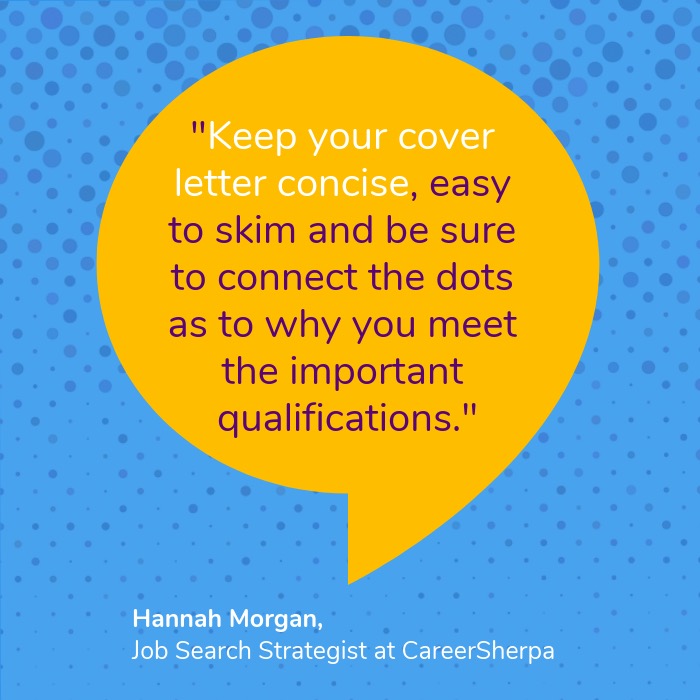
Customize your cover letter for each company you apply to
“CUSTOMIZE YOUR LETTER TO THE COMPANY YOU’RE SENDING IT TO. Don’t just provide a list of your skills, or a few flattering paragraphs about your background. Tie your story to what the company cares about! If you’re not sure what the company cares about, go to their website. Read their About Us page. Try to figure out what they value (this is not hard – a lot of companies share their core values somewhere on their site). Pick which of those core values resonate most with you. Then, tailor your letter to those values. That is: how have you demonstrated that value in your career so far? How would your experience / skill set contribute to that value if you were to work at this company?”
– Claire Suellentrop, Co-Founder and Head of Marketing at Userlist
“Always personalize your cover letter. Explain what you have to offer and how exactly that connects with the vision/goals of the company.”
P.S: Not customizing your cover letter for each job application is probably the biggest cover letter mistake you can make as an applicant!
– Brandon Thompson, Recruitment and Hiring Manager at 1-800- Got -Junk?

Focus on communicating your career goals
“Spend more time explaining your goals/direction and your plan rather than listing off things like ‘good at multitasking and team work’. What is your focus and why do you want the role?”
– Emily Brown, Hiring Manager at Ledcor

Use creative copywriting techniques
“When hiring marketers, I look for creativity and powerful copywriting. Empathy…understand the role your prospective employer is hiring for and what good and bad (very important to have why you might not fit) ways you fit in.”
– Derric Haynie, CEO of Vulpine Interactive
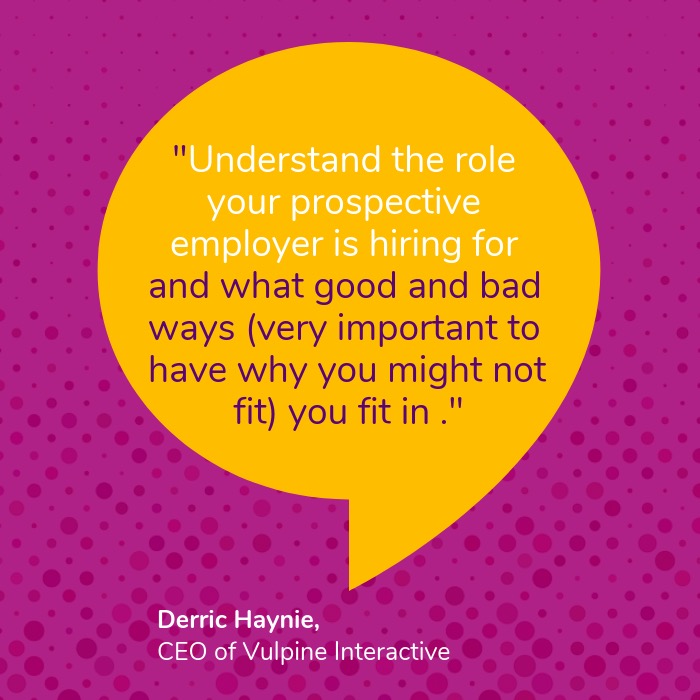
Show you know a lot about the company you’re applying for
“Find a way to stand out and find a way to speak to the first person who will be reading your resume, either that’s a recruiter, HR manager or hiring manager. If you know who you’re writing the cover letter for, talk about why you are actually excited to work for that company. Talk more about the company than you do about yourself, and tie in a few reasons why you’e the right fit for the role. Reference recent news articles about the company, show that you’ve done your research, whatever you need to do to stand out beyond the copy and paste approach that everyone else is using. The information is available.”
– Martin Hauck, Head of Talent at Coinsquare

Optimize your cover letter design for print
You probably already have a few ideas for creative cover letters buzzing around in your head. But before you race off to start your design, here are a few best practices to keep in mind.
If you’re planning on bringing your cover letter to an interview, make sure that your design will look as impressive in print as it does on screen.
Design your cover letter for standard letter paper
Make sure that the size dimensions of your cover letter template fit standard printer paper. Standard letter paper is 8.5 x 11 inches.
Export your cover letter in a high resolution
You don’t want your cover letter to print out blurry. In general, it’s a good idea to export your cover letter in 300 dpi resolution.
Venngage allows you to download your design in HD PNG or PDF formats. You can also check out this guide to learn how to edit PDFs .
Set bleed marks for your printer
If you want to get your cover letter printed professional, you may want to set bleed marks in your design. “Bleed” is the area around the outside of your cover letter that will be chopped off after printing.
If your cover letter design has a solid background color, or colors and images that touch the edge of the page, you should set bleed marks to indicate where the edge of the page is.
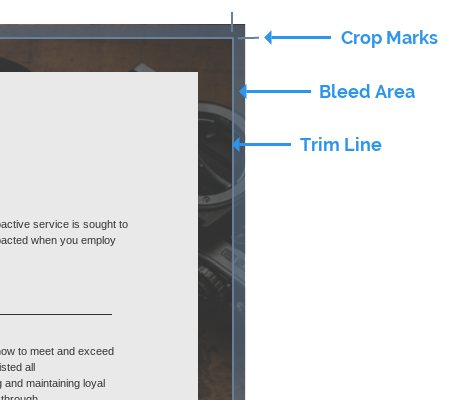
Why should you use a cover letter template?
In most cases, your cover letter is an employer’s first introduction to who you are — your personality, your qualifications, and your goals. A cover letter is a way to develop your own personal brand :

A professional cover letter helps you seem more legitimate to employers. And it is a great document to bring with you to an interview and to publish on your portfolio site .
Why do you need a cover letter template ? Well, you should be writing a different cover letter for each job application.
So, a cover letter template will give you a framework that you can adapt for different positions, and save you time doing so.
Now, let’s take a look at different types of cover letter templates you can customize using Venngage.
Before that, if your resume design could use a little makeover, take a peek at these easy-to-use infographic resumes or creative resume templates . They’re sure to add that extra flair and make your application stand out!
How long should a cover letter be?
A cover letter should be concise, typically no longer than one page. Ideally, it should be between 250 to 400 words, encompassing three to four paragraphs. This length ensures you provide enough detail about your qualifications and interest in the position without overwhelming the reader.
Do I need a unique cover letter for every job?
Yes, you should create a unique cover letter for every job you apply to. Tailoring your cover letter allows you to highlight specific skills and experiences relevant to the job, show your knowledge about the company and explain why you are a perfect fit for the position.
This personalized approach can significantly increase your chances of standing out to potential employers.
Now that you’re equipped with these cover letter design tips, it’s time to make your own!
More design guides to power your career growth: 20+ Infographic Resume Templates and Design Tips to Help You Land That Job
Discover popular designs

Infographic maker

Brochure maker

White paper online

Newsletter creator

Flyer maker

Timeline maker

Letterhead maker

Mind map maker

Ebook maker
- Arts, Design & Media
- Career Exploration
- Government, Policy & Social Impact
- Graduate Business (MBA & SMP)
- Health Care & Sciences
- Technology, Data & Engineering
- Career Assessments
- Career & Major Exploration
- Resumes, Cover Letters & Application Materials
- Graduate & Professional School Preparation
- Job & Internship Search Strategies
- Negotiation & Offer Evaluation
- Professional Conduct
- Bear Treks – Explore Industries
- Chancellor’s Career Fellows Program
- Pershing Fellowship in Non-Profit Leadership
- Stipends for Unpaid Summer Internships
- Schedule a Career Coaching Appointment
- Faculty & Staff
- Attend an Event
- Engage with Students
- Post a Position
- Hiring International Talent
- International Employer Resources in Asia
- Recruiting Calendar
- Recruitment and Offer Policy
- Visiting the Center for Career Engagement
- Hire WashU: Annual Employer Forum
- Career Outcomes
- Center for Career Engagement Leadership
- Academic Partnerships Team
- Career Development Team
- Employer Engagement Team
- Events, Operations & Programs Team
- Student Career Peer Team
Jen’s 10 on Cover Letters for Creative Careers
- Share This: Share Jen’s 10 on Cover Letters for Creative Careers on Facebook Share Jen’s 10 on Cover Letters for Creative Careers on LinkedIn Share Jen’s 10 on Cover Letters for Creative Careers on X

- Begin with the basic structure. Don’t worry about getting too fancy with the first draft. The basic paragraph flow: 1) who you are, what you want, how you learned about the opportunity 2) show off what you know about studio/clients/field 3) graceful transition to you, relate experiences and perspective that have relevance 4) the valediction should end on a positive, graceful note. Resist the temptation to be too cute or unconventional, as you risk coming across as silly and professionally immature at best, irreverent and disrespectful, at worst.
- Three is the magic number. Chant this mantra when composing your cover letter be clear, be brief, be specific. The document needs to be compelling to read at a glance, so you must think carefully about word choice and be direct in asking what you want. Three is also a good number of paragraphs to target (four is the limit).
- Nix To Whom it May Concern. You will soon discover a letter addressed this way concerns no one at all. If a contact is not specified in the job listing, time to smile and dial (pick up the phone and call the switchboard/receptionist/studio). You will find that using the phone is an amazingly efficient technique in gathering critical information.
- Focus on the organization’s need, not yours. Of course the organization knows that you will benefit from a summer working in their studio, that it will sharpen your skills and provide you with invaluable contacts. However, rare are the firms, organizations, companies or institutions that put a higher priority on strengthening your skills than their work at hand. Walk the fine line between confidence and modesty as you gracefully suggest a way or two that you could contribute to the fine work that they do (at this point in your career, this is primarily enthusiasm and energy).
- Be a shameless and relentless name dropper. Provide the recipient with some sort of frame of reference: “So-and-so suggested I contact you” OR “I enjoyed the lecture you gave recently at…” Use sparingly (not more than once per letter) as there does exist a fine line of providing relevant context vs. being a bit obnoxious as it relates to this skill. Remember, no one likes an insufferable kiss-up.
- Demonstrate that you are a student of the field, not just the discipline. This is what distinguishes the “maybe” to the“must interview” stack – professionals always are impressed that students manage to stay on top of industry trends, news, and scuttlebutt in addition to pursuing their studies. Cite relevant articles/titles (and make sure to do so correctly)
- Spell check. Grammar check. Edit Check. And check again. Your goal here? 100% perfection. Reach that goal faster by printing out a hard copy; it’s amazing how many more mistakes you catch on paper than on a screen. Don’t give someone a reason to toss your materials because of something avoidable.
- Read aloud. Most of us have a tendency to sound like dialogue in a 19th century novel when peppering a document with a lot of “therefores” and “thuses” with the intention of adding a grown-up, formal tone. You should be professional, but inviting and engaging. Reading out loud (or to a buddy) is another great technique to catch editing errors, typos and other general goof-ups.
- Create and commit to the Brand Called You. All of your materials – from your resume to cover letter to text accompanying or introducing writing samples – need to jibe (structure, typeface) — one beautiful and cohesive system.
- Okay, kiss up a little. From our good friend Adrian Shaughnessy of How to be a graphic designer without losing your soul : State that you are aware of Studio X’s marvelous work for Client X, and that you have found it inspirational. Don’t lay it on too thick, but designers are vain and will respond with Pavlovian slavering to a bit of mild, but honest, praise.

REVENUE DRIVEN FOR OUR CLIENTS
- Client Login
- 888-601-5359
Showing 1 - 10 out of 832 for:

- Web Design 20 Website Homepage Design Examples and Best Practices for Pixel Perfection
20 Website Homepage Design Examples and Best Practices for Pixel Perfection
- Celeste has worked in the online marketing space for twenty years. She has written for sectors including tourism, sustainability, education, lifestyle, food, and marketing. You can find her work featured by Green Building Media South Africa, Stodels Gardening, and The Post House Hotel. In magazines, you may have seen her in The Cape Times, Oprah South Africa, and The Property Magazine. While you can find her writing up on the latest SEO trends and exploring digital techniques during the day, her love of story-telling carries on in enriched games and books after hours.
Knowing what to do and seeing how it works is a great way for you to explore what is best for your homepage. Often, successful websites will use a combination of best practices, which is why they are successful. For example, the first website on this list (Apple) uses clear branding and a beautiful balance of white space.
Looking at other websites will enable you to see what looks and feels best and what design elements and practices you want to implement in your own design.
On this page, we’ll share 20 website homepage design examples to inspire your website’s design!
Once you have an idea of what you want, you can reach out to us to build it. We can create custom websites that are fully optimized for you and capture your brand. Phone us at 888-601-5359 to speak to a specialist about your vision.
Bonus Read! Looking for a best practice checklist for your website? Check out our 9 web design best practices checklist
20 web design best practices and examples
We have scoured the web, pulling together home pages that showcase the best practices, along with website homepage design examples that will help you understand the significance that a well-designed and user-centric home page can offer to your clients.
1. Have clear branding like Apple
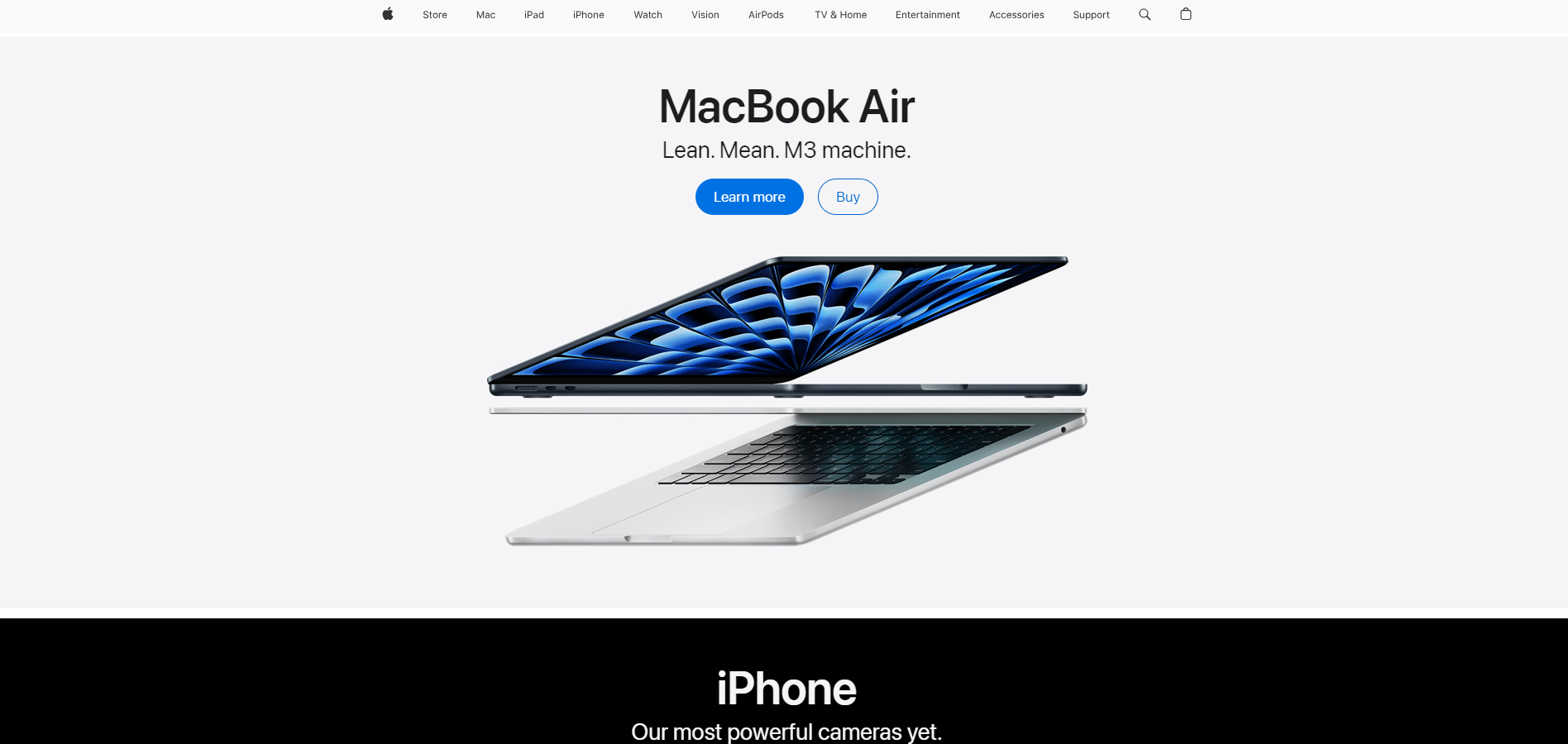
Apple’s logo is iconic, so they don’t even use their name. A single black apple, with a bite missing, white background, and you know what it is. Their entire brand, from product to their website, is clean, minimalistic, and aligns 100% with their brand identity.
Their home page is a website example that is consistent with that identity, from font to design elements.
2. Have simple navigation like Google
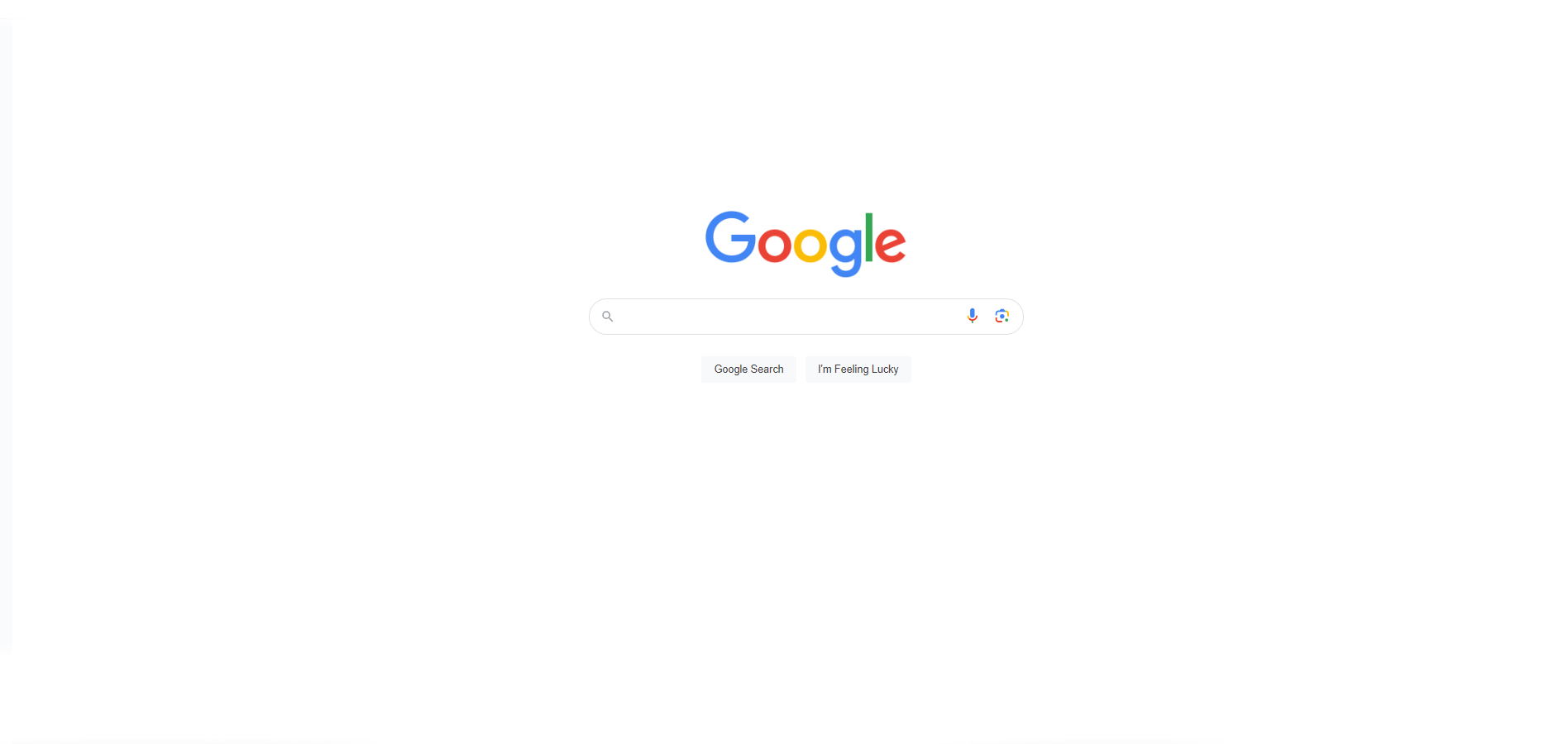
Search engines are home pages as well! The home page is incredibly simple, except for the occasional holiday where Google might change its logo. There’s one search bar to use that’s prominently displayed in the middle of the page.
Other options, such as Gmail and images, have been kept unobtrusive but still accessible in the top right corner.
3. Be responsive in your design like Airbnb
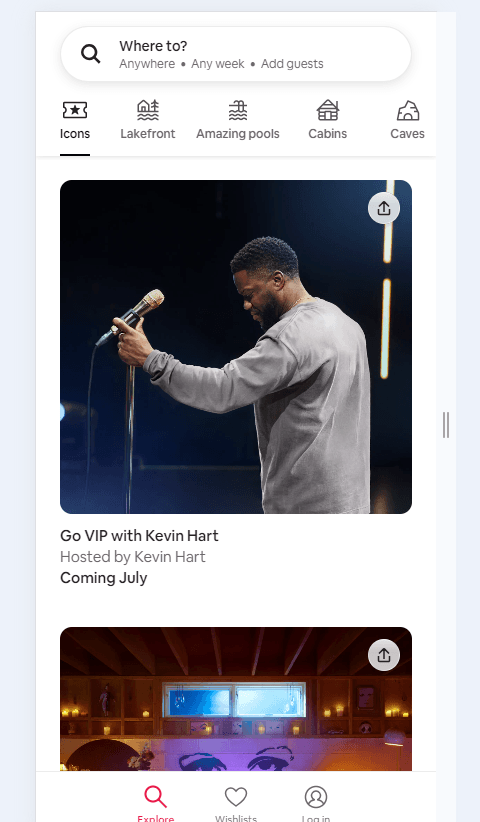
Many websites, like social media and streaming platforms, pioneered responsive design because they quickly realized their target audience was viewing them on mobile devices. Airbnb was one of the first accommodation websites to realize this.
Today, it adjusts seamlessly to different screen sizes and devices. Layout, images, and text automatically reflow for their users to receive optimal experiences.
4. Have a fast load time like Dropbox
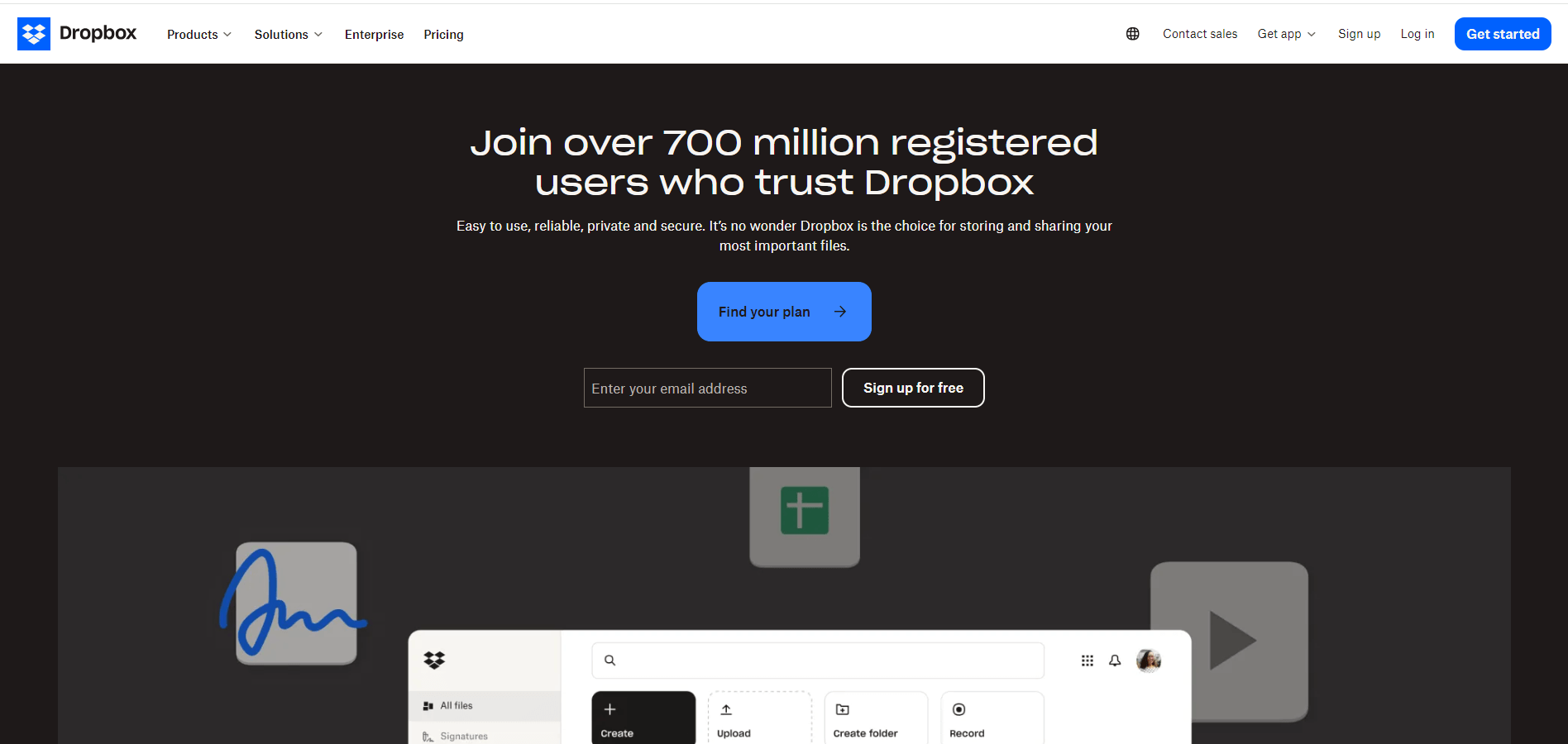
If cloud solutions are your main business model, then having a fast load time will be your biggest unique selling proposition (USP) . Dropbox has ensured fast loading time by keeping their images light, optimized, and backed that up with efficient coding practices.
5. Get a compelling headline like Slack
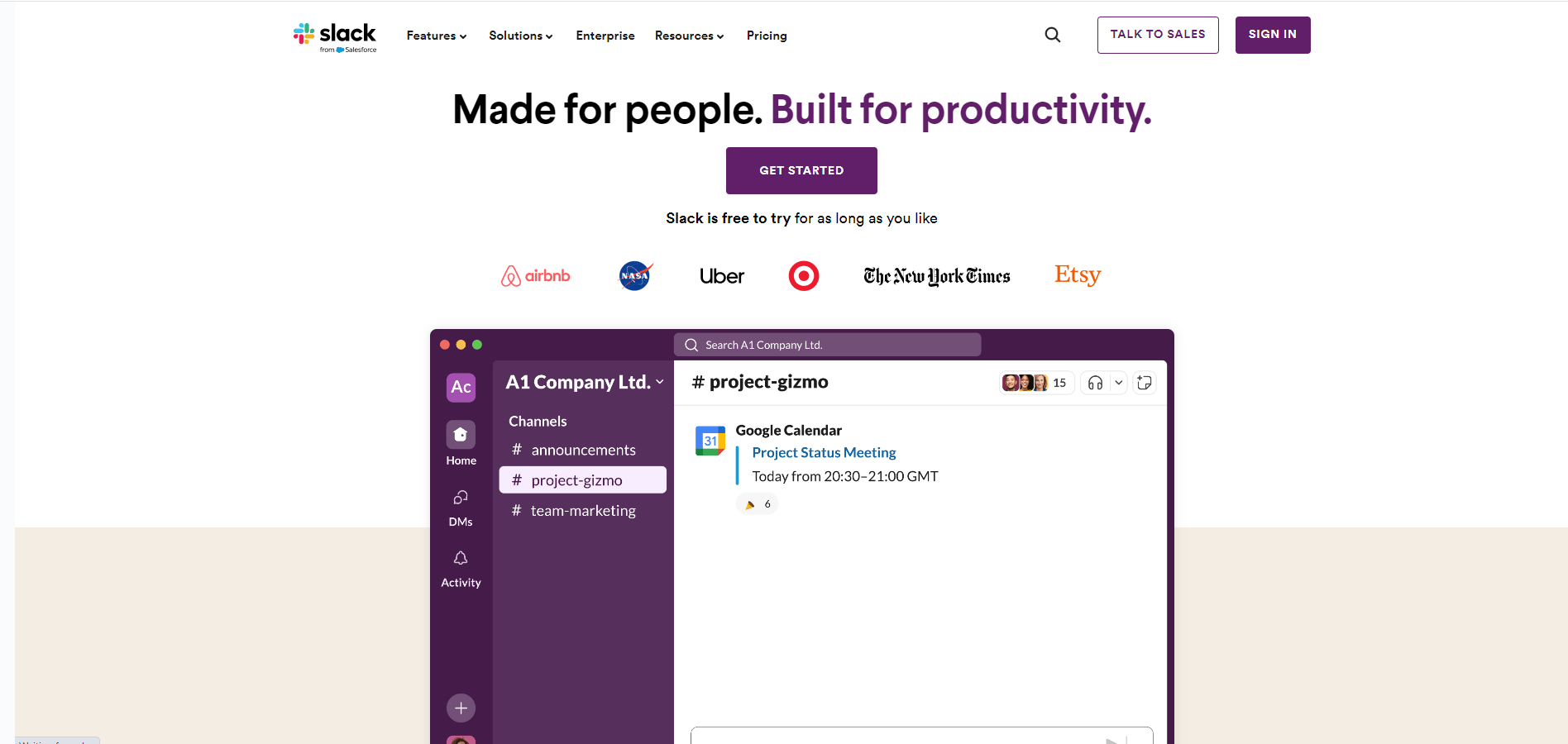
Slack has always included an engaging headline in their design, stressing the point that they are all about coworkers being able to communicate. Their phrase, “Made for people. Built for productivity,” strongly emphasizes that this is not like a ‘discord’ or regular messaging platform for casual conversation but a place of purpose and professionalism.
6. Implement high-quality images like Squarespace
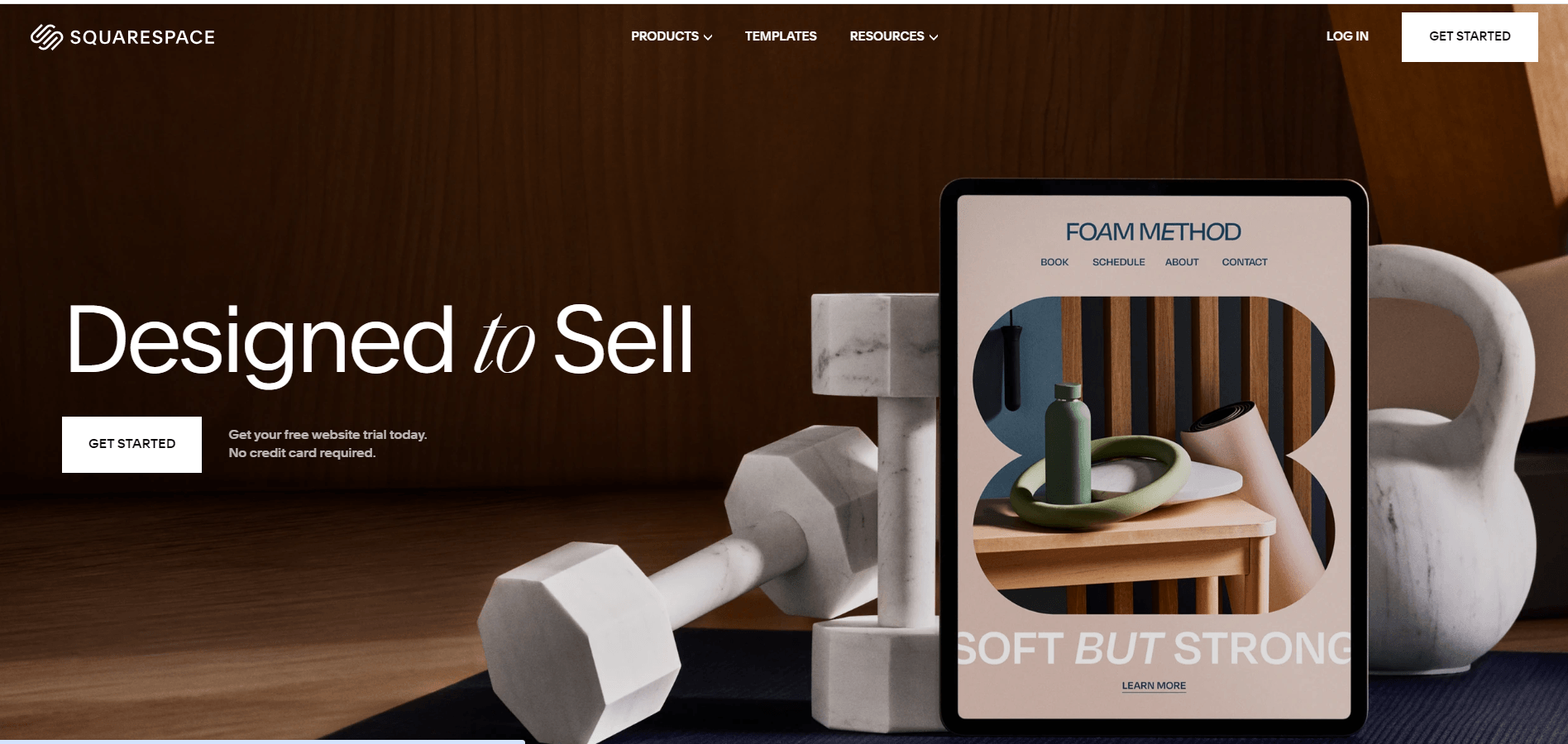
Squarespace’s top priority is promoting its website design and aesthetics . It follows that through by leading with its own design. It uses high-resolution, visually appealing images to showcase the beauty of websites created with its platform.
7. Use minimal text like Stripe
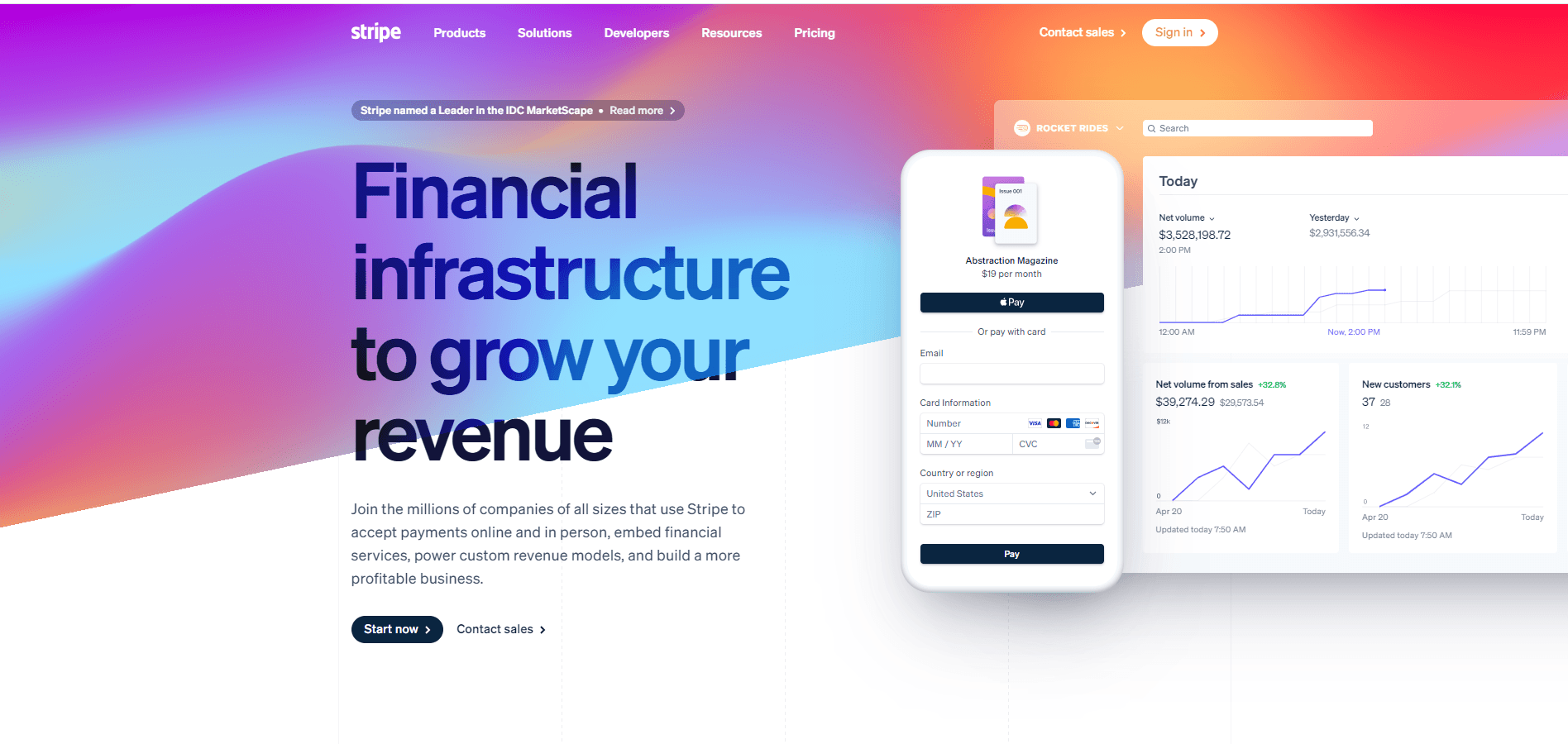
Even though Stripe is in the finance sector, there isn’t a large wall of jargon on their site. In fact, their site is quite the opposite. There is decent white space , large, powerful headings, and then a small paragraph to capture the audience.
This is then finished off with a powerful call to action (CTA) to guide the user to the next step. Their concise copy highlights only the features and benefits without overwhelming the user.
8. Integrate good CTAs like Netflix
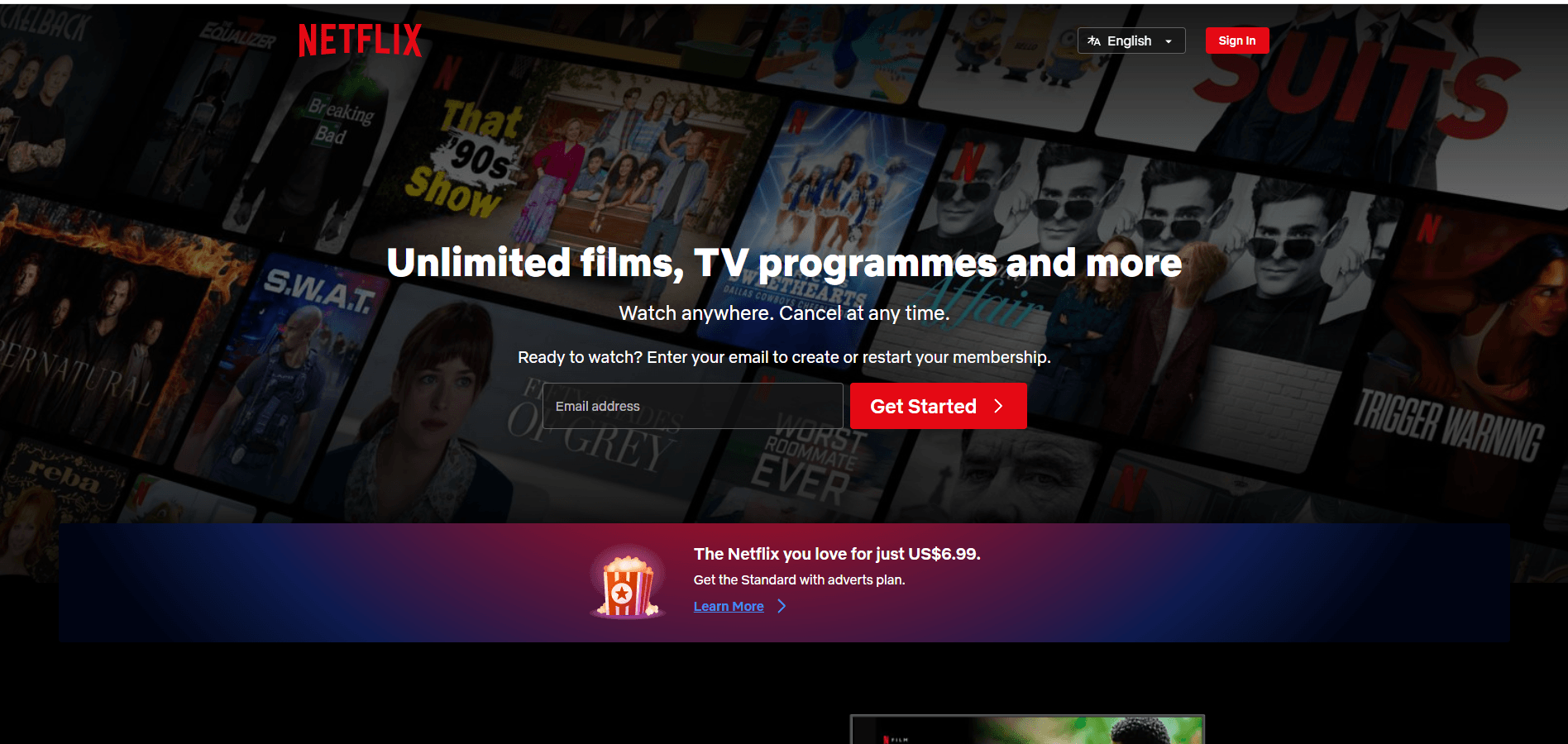
Netflix’s branding is a great website example for using color to draw the eye. The sharp red-on-black pulls your eye right in. But they also use this color combo for their call to action. While the text is still highly visible and readable in white on black, the buttons are the real star of the homepage.
The wording also calls the user to action by using simple, direct, active instructions such as “get started” or “sign in.” These instructions are strategically placed to encourage the user to push them. After all, everyone has always wanted to push the big red button.
9. Use white space like Albert

Albert is a simple banking finance app, and they wanted to express that in their website design. Their homepage makes incredible use of white space. They also use a very subtle approach to capture the eye with movement. But unlike other sites that do this with text change or a whole image, Albert does this by flicking between the screens on its app.
It’s a gentle change that draws interest while keeping the focus on what is really important. The spacing between elements prevents clutter and allows the user to focus on the product.
10. Use a prominent logo placement like Mad Tasty

Mad Tasty has a distinct logo: White, capitalized text that is clean and minimal on a solid black rectangle. The main logo is in a focused point position in the top banner. The design is then replicated in CTA’s and main headings. Their logo also services as a button to their home page, providing an easy way for users to navigate back to the starting point.
11. Create great “contact us” accessibility like Basecamp
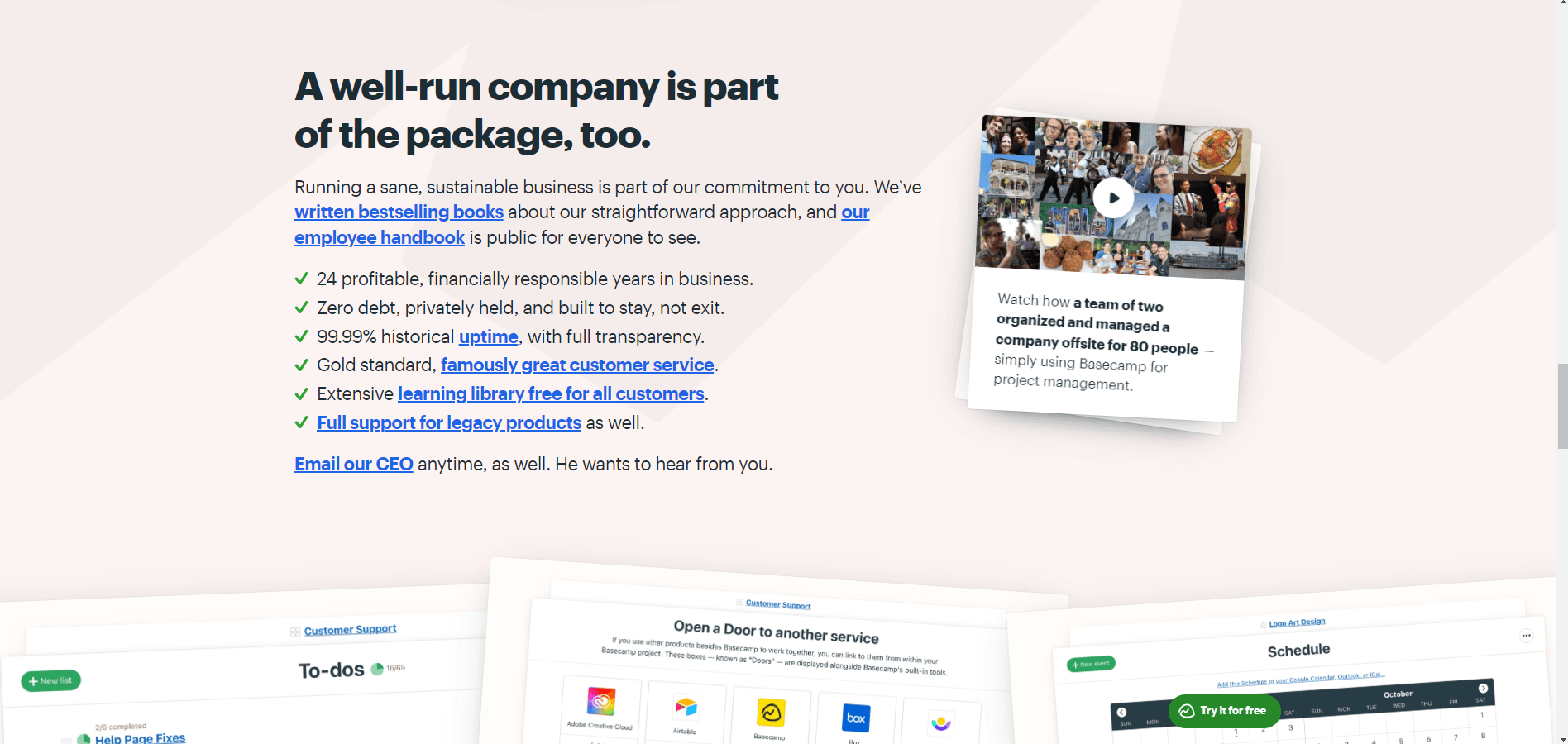
While most companies offer a “contact us page” in their top navigation, most CTAs will probably direct you to sales or their pricing page. Basecamp offers all of that but also gives links to their customer services, and if you want more of a personal connection, they offer the CEO’s email address directly.
Not a lot of CEOs out there are willing to be that hands-on.
12. Integrate social proofing information like Zendesk
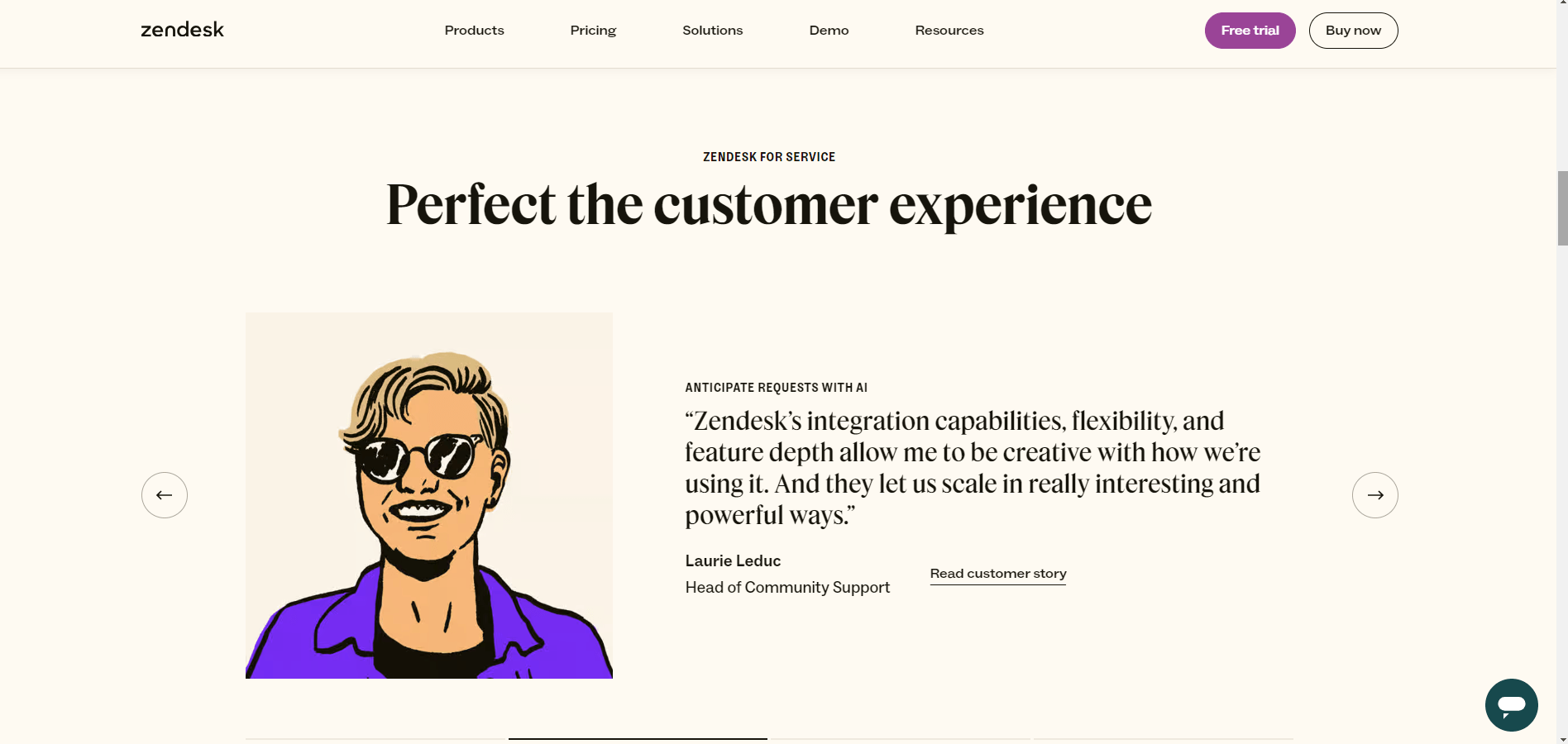
Testimonials , case studies , and client logos are prominent on Zendesk’s home page. The company showcases its credibility by displaying the positive impact of its solutions on its clients.
Elements from third parties work similarly to word-of-mouth credibility. Being endorsed by others reflects well on the company’s customer service and ability to deliver, making the potential new client feel safe investing in the product.
13. Use interactive elements like Spotify
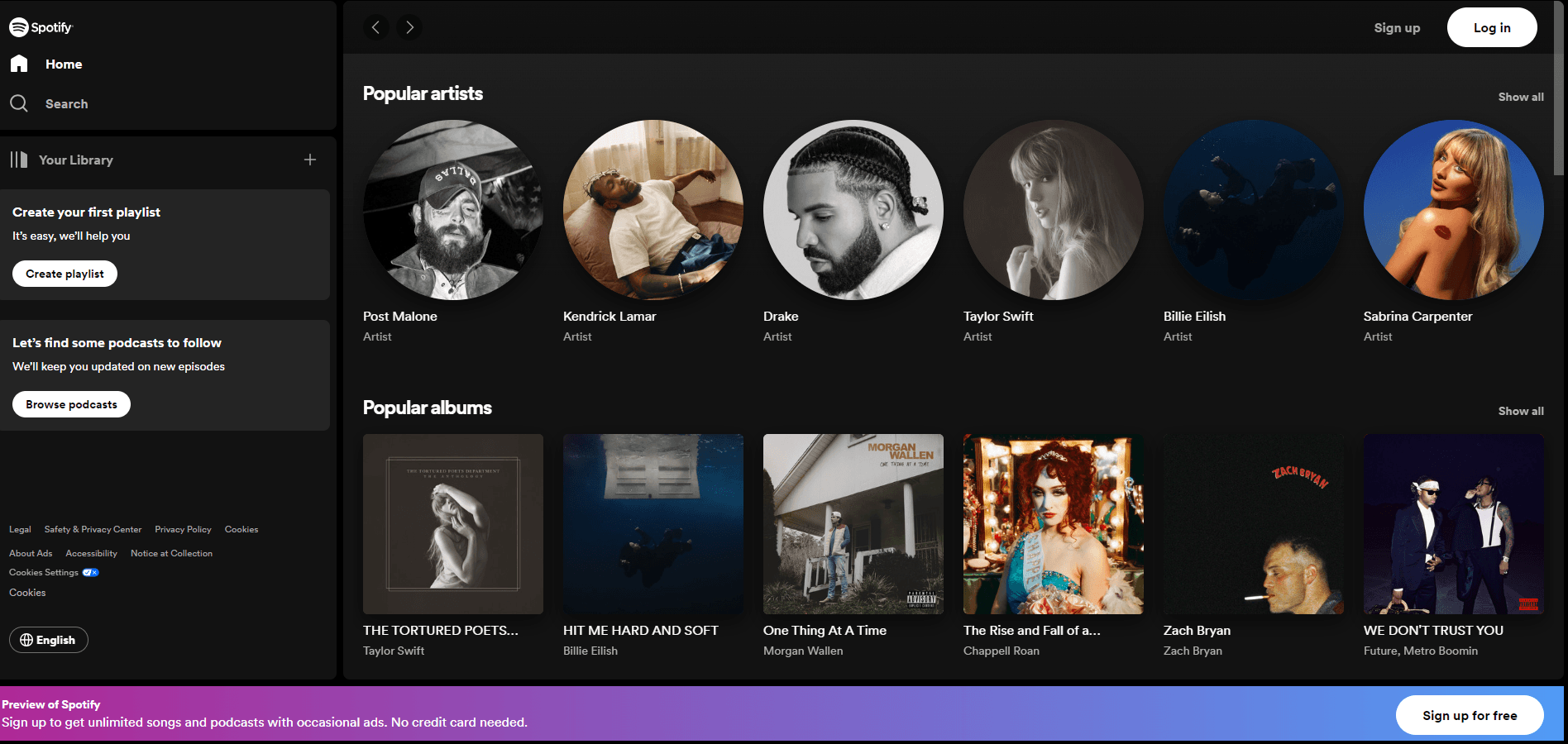
Almost every element on Spotify’s home page can be interacted with, played, or expanded to see more options. Spotify is a great website example of how interaction can improve the customer’s journey .
You can preview music and personalized recommendations. With each interaction, the user’s browsing experience is enhanced and attended to.
14. Be consistent with your layout, like Microsoft
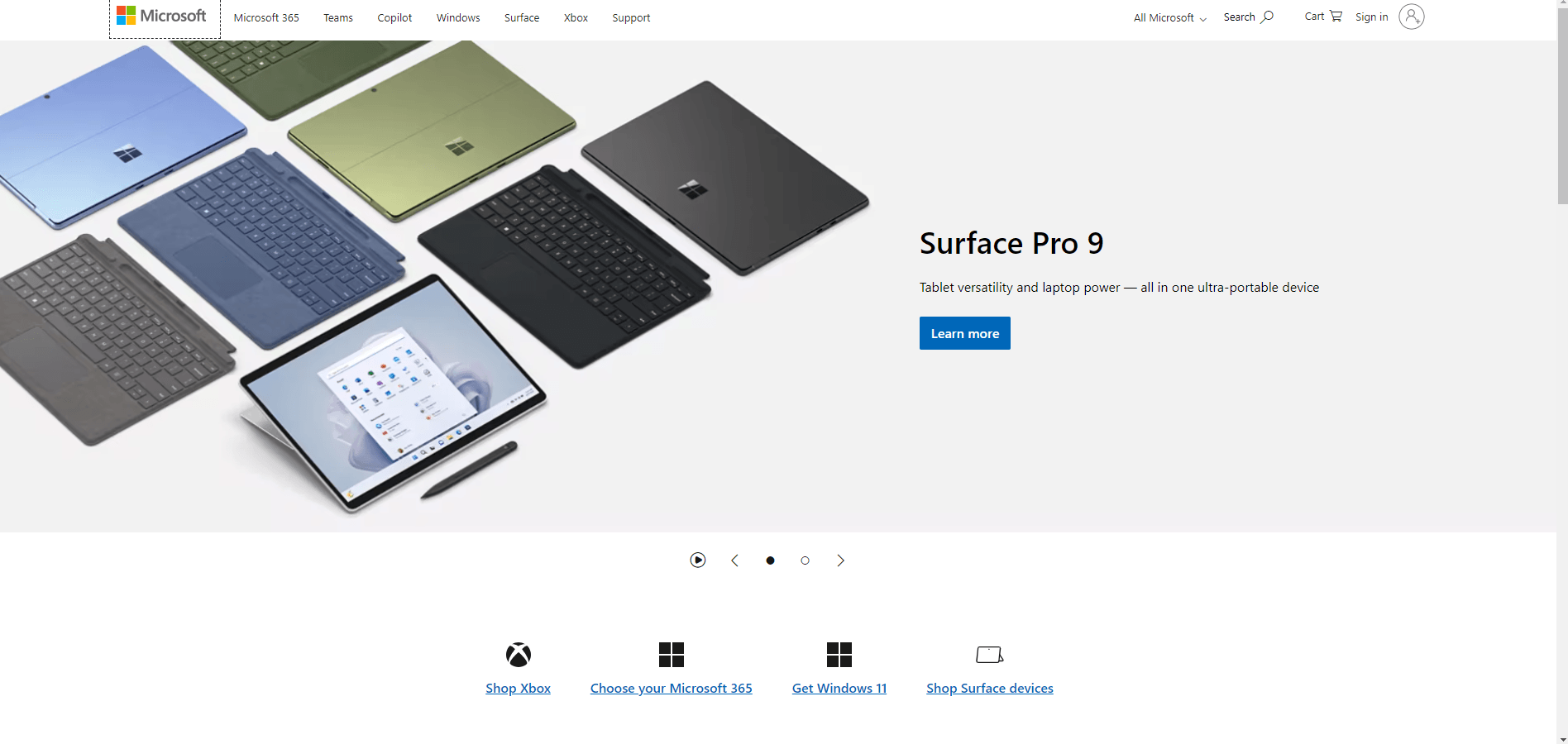
Microsoft has had a very clean, consistent, clear, functional branding for decades. They have always prioritized website accessibility and ease of use in their operational systems and software, and their homepage is no different.
It has a clean structure with lines, good use of white space, and a conventional layout, so users can easily navigate and find the product or service they require.
15. Have user accessibility like W3C
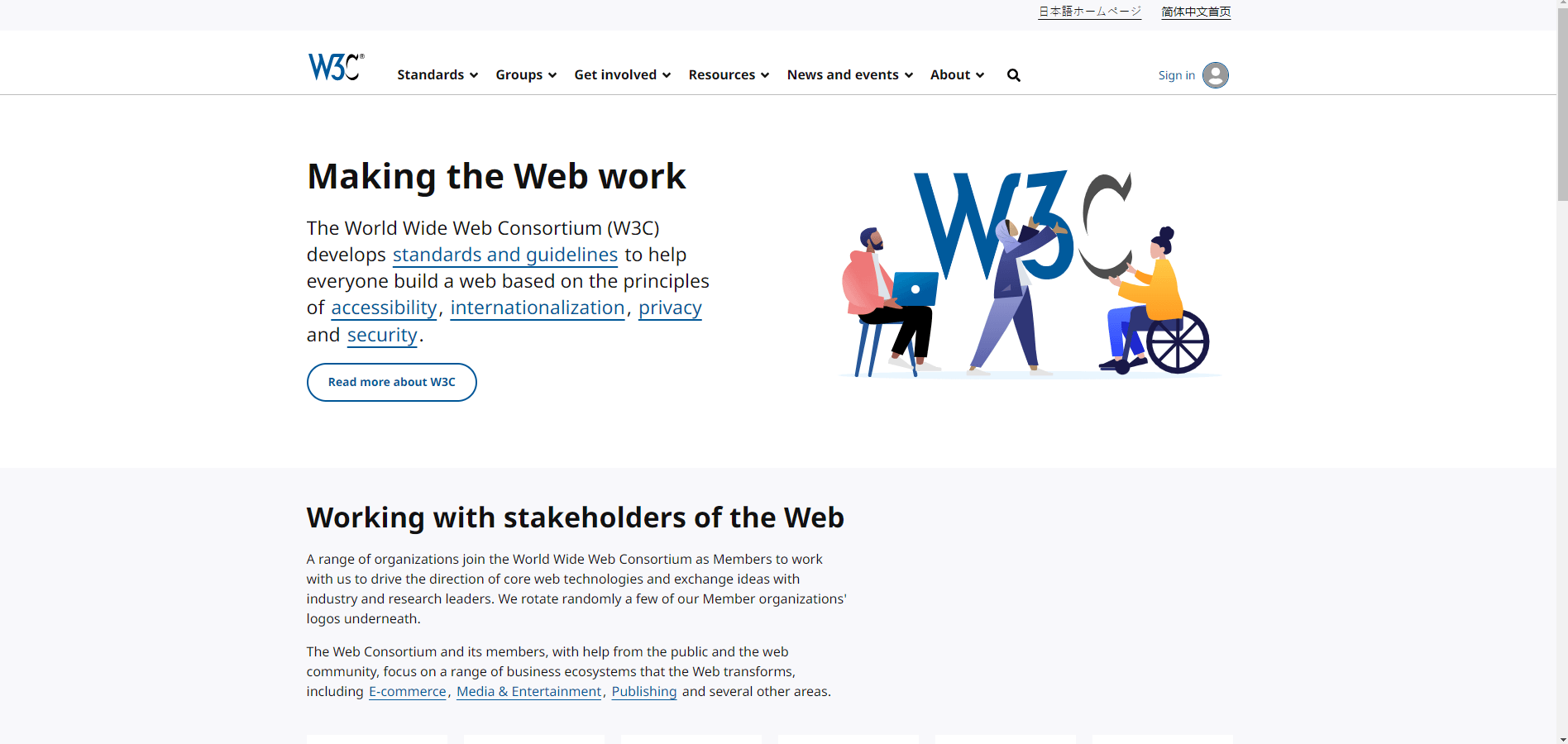
The World Wide Web Consortium (W3C) is designed with accessibility in mind. To ensure all users can access their contact information, they have provided alt text for images, keyboard navigation, high-contrast options, different language settings, and more.
The main focus of the W3C is to drive technology so that everyone has access to information and create guidelines for website accessibility . They demonstrate that they are not only discussing these issues but leading by example by implementing many of them on their own website.
16. Have articles and blog features like TechCrunch
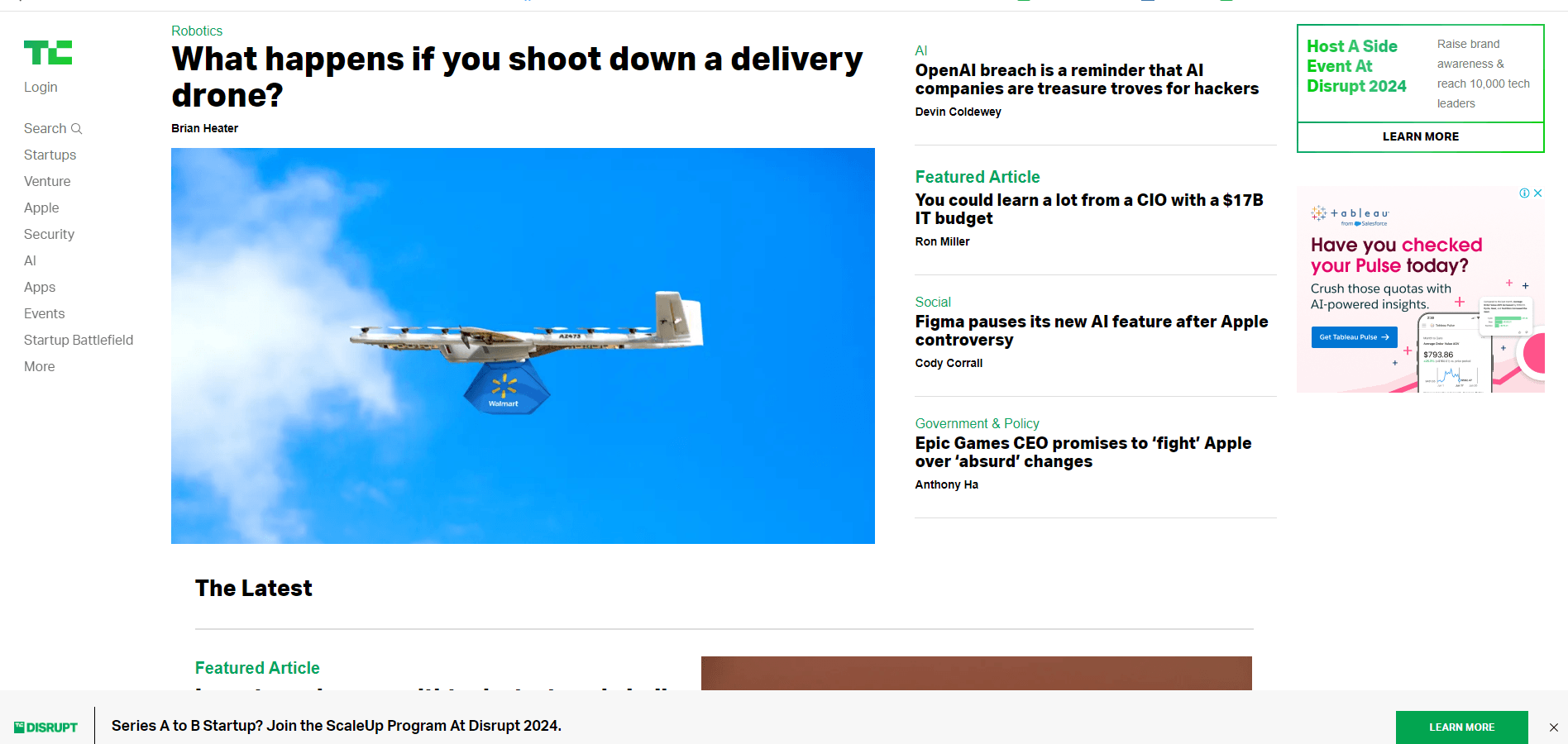
TechCrunch prominently displays articles and news stories on the homepage. The main section has featured articles that capture the user’s attention immediately.
Each article has engaging thumbnail images and diverse content formats. Regular updates ensure the content remains current, encouraging users to visit often.
17. Be user-centered with a design like Asana
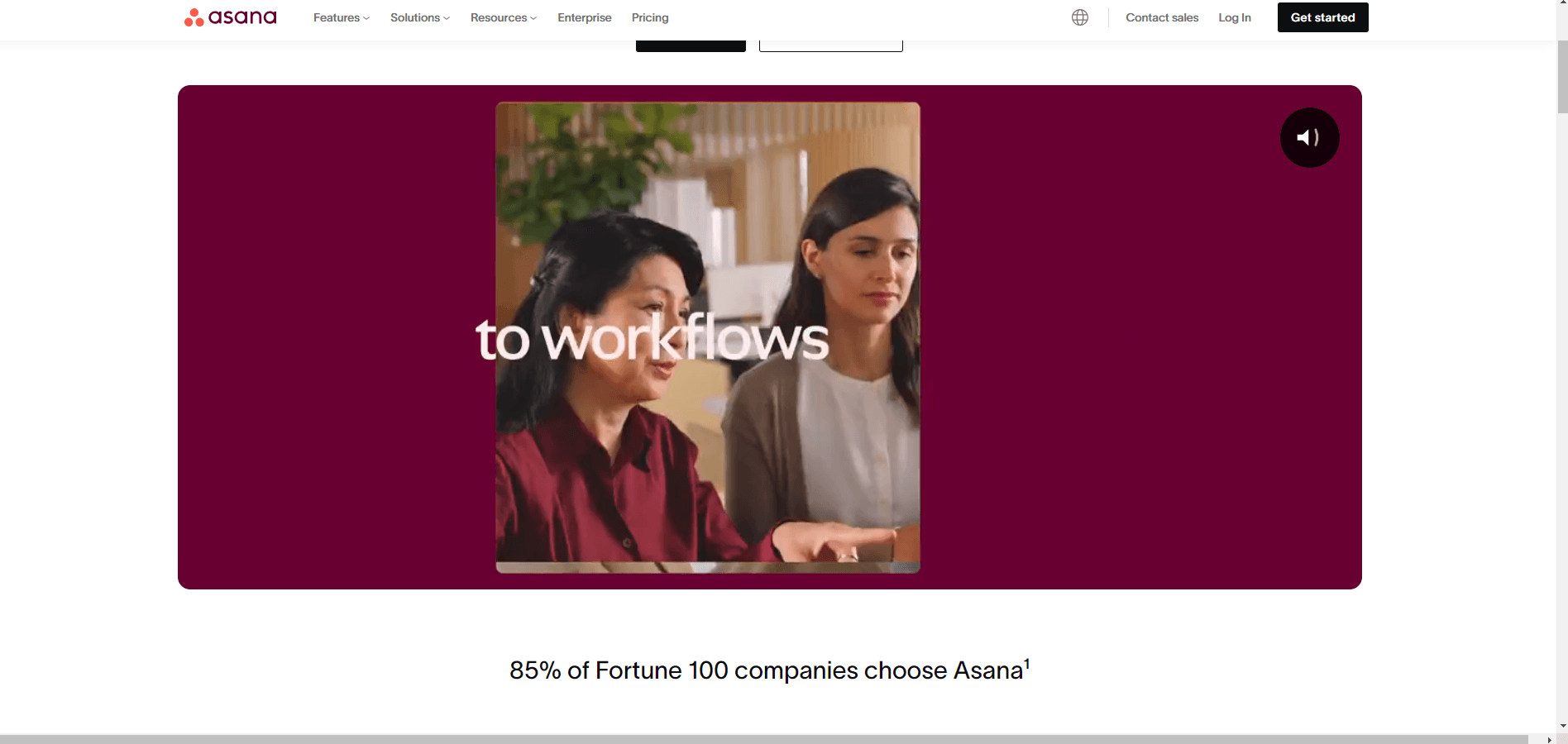
Asana’s website focuses on clarity and ease of use. Their support chat box appears quickly, their text is written with no jargon, and their headings are concise. Throughout the home page, you’ll find helpful videos, easily laid out features, and clear buttons and navigation.
The design gives important information first so that clients can understand how Asana can help them manage their projects and taste efficiency. There is also a personalization element, where recommendations are made based on the user’s needs.
18. Give personalization like Tailor Brands
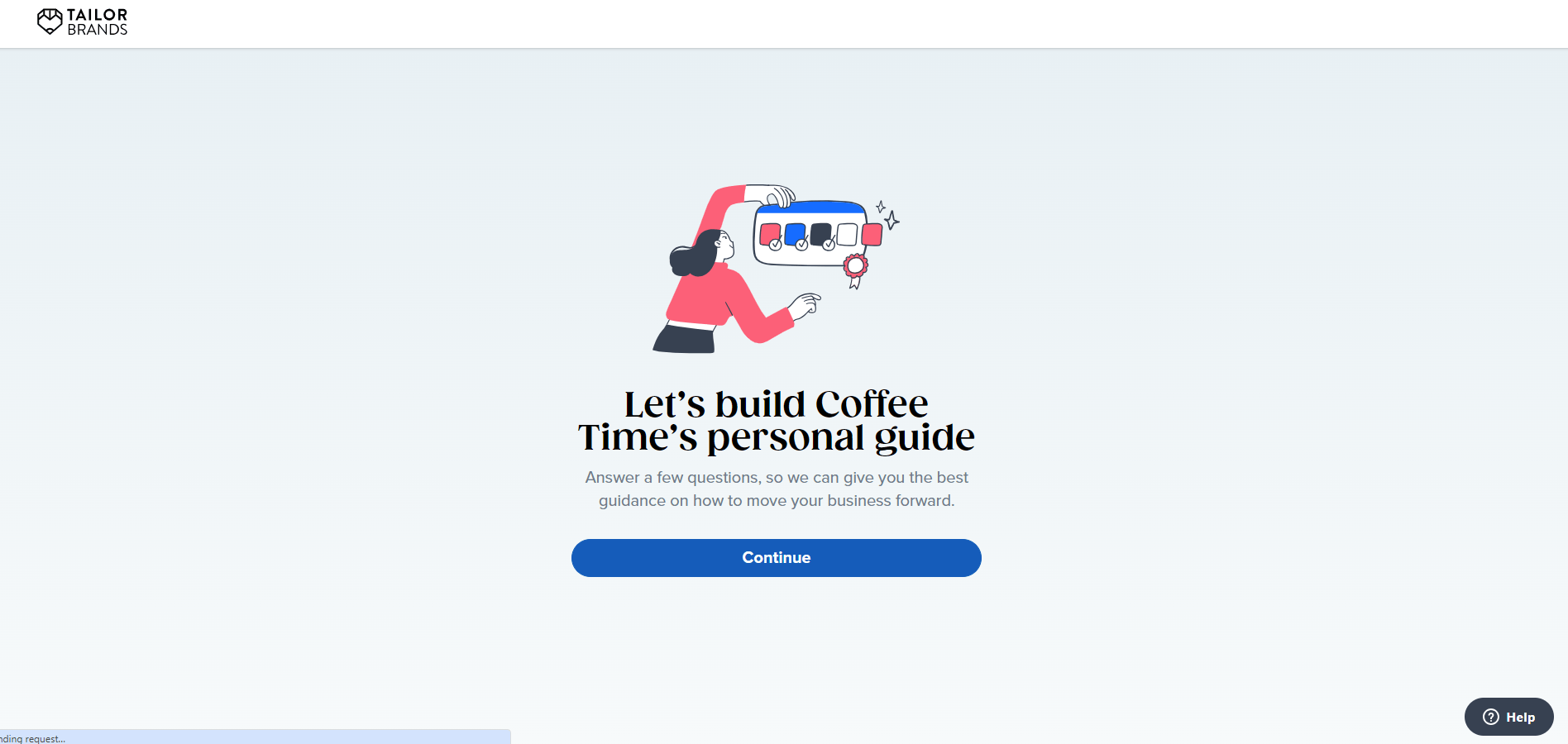
Tailor Brands gives clients tools to personalize and build platforms. Their homepage does the same for the client, doing everything possible to get the client to go on a journey of personalization for their idea.
Based on these inputs, the website immediately gives options and recommendations, giving the user a tailored engagement and an experience relevant from the start.
19. Include analytics integration like Shopify
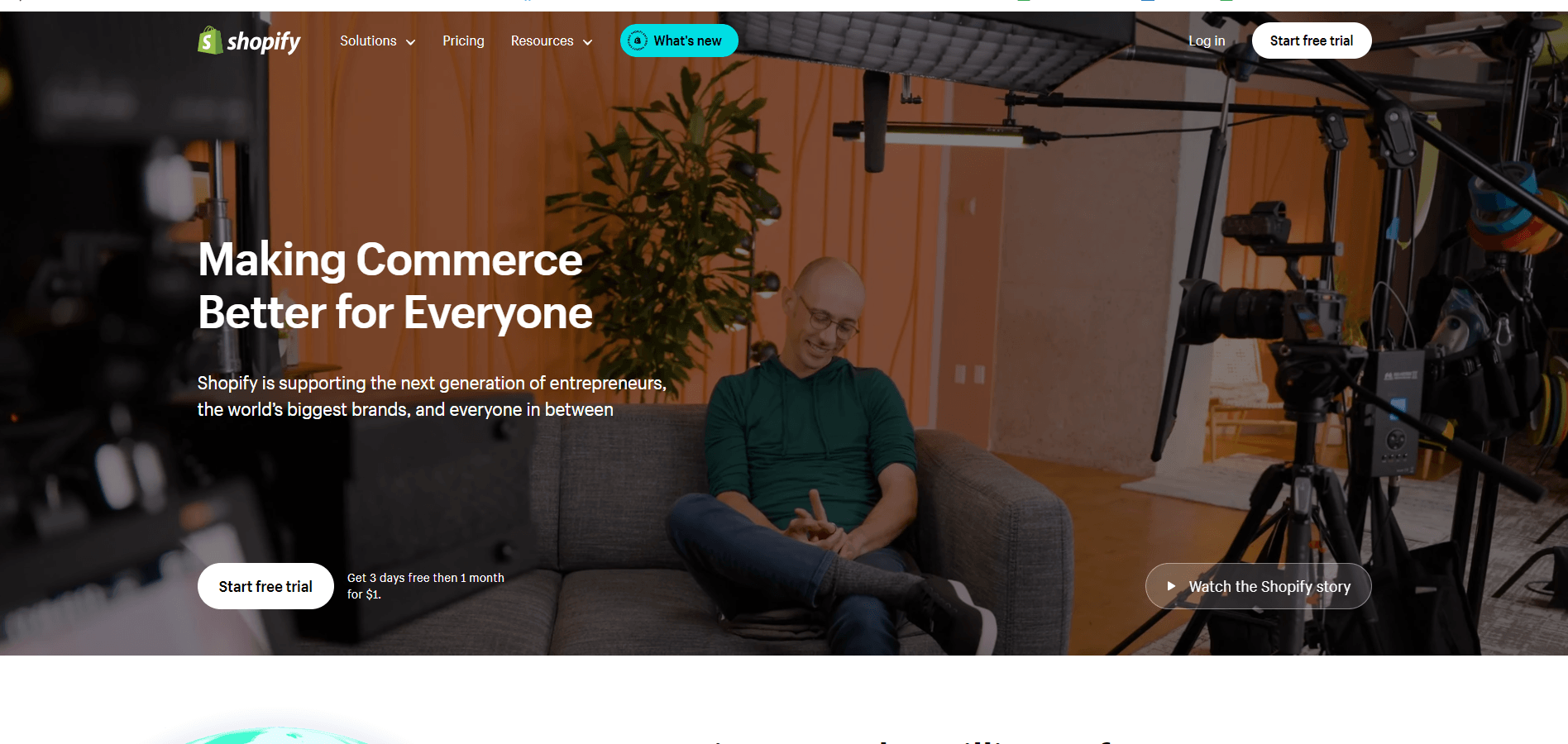
Shopify focuses on highlighting the analytics and reporting features of its website builders directly on its homepage. It wants to showcase that its platform provides users with valuable insights into their stores’ performance.
How do they do this? By providing detailed sales processes, customer behavior analytics, marketing insights, and more to visitors.
20. Give a clear hierarchy like BBC
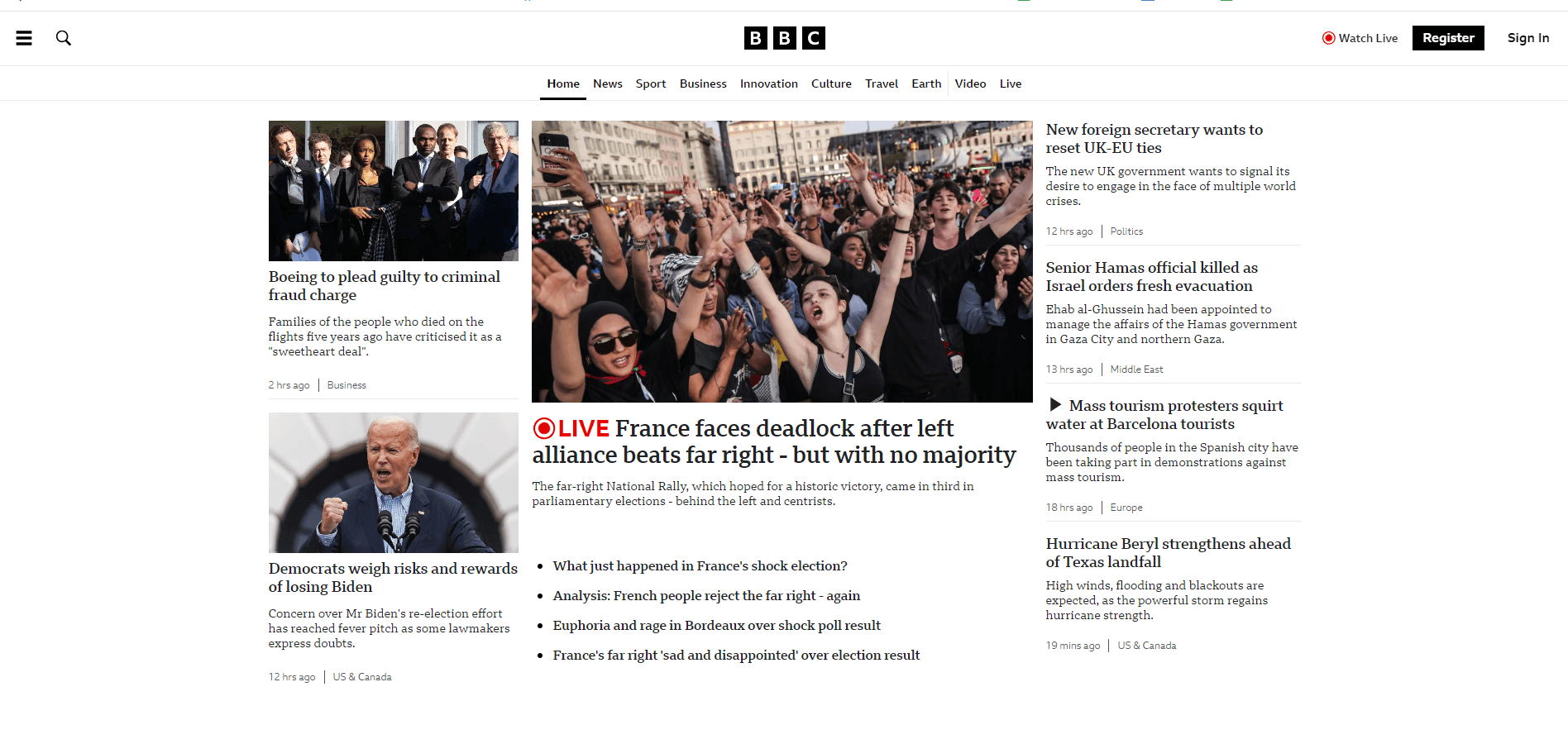
Newspapers and magazines often give hierarchy to the layout within their print publications. The biggest, important stories go on the front page, while warm fuzzy stories go on page three. BBC has focused similarly on its website, emphasizing larger, distinct headings for the big story and lesser eye catchment for the others.
The structure helps users easily find news, articles, and other content that would be of engagement to them.
Create the best website homepage design with WebFX
Having looked at the website homepage design examples, you should now be ready to incorporate that in your own site.
Need help implementing your favorite design elements? WebFX offers custom site designs that will give you the opportunity to launch a site that captures your brand, improves your conversion rates, all with the best website practices in mind.
Our team of 500+ digital experts is ready for your call. Contact us on 888-601-5359 to speak to a strategist or reach out online , to start a conversation about your business and it’s online potential today!
WebFX is a full-service marketing agency with 1,100+ client reviews and a 4.9-star rating on Clutch! Find out how our expert team and revenue-accelerating tech can drive results for you! Learn more
Make estimating web design costs easy
Website design costs can be tricky to nail down. Get an instant estimate for a custom web design with our free website design cost calculator!

Table of Contents
- 20 Web Design Best Practices and Examples
- 1. Have Clear Branding Like Apple
- 2. Have Simple Navigation Like Google
- 3. Be Responsive in Your Design Like Airbnb
- 4. Have a Fast Load Time Like Dropbox
- 5. Get a Compelling Headline Like Slack
- 6. Implement High-quality Images Like Squarespace
- 7. Use Minimal Text Like Stripe
- 8. Integrate Good CTAs Like Netflix
- 9. Use White Space Like Albert
- 10. Use a Prominent Logo Placement Like Mad Tasty
- 11. Create Great “contact Us” Accessibility Like Basecamp
- 12. Integrate Social Proofing Information Like Zendesk
- 13. Use Interactive Elements Like Spotify
- 14. Be Consistent with Your Layout, Like Microsoft
- 15. Have User Accessibility Like W3C
- 16. Have Articles and Blog Features Like TechCrunch
- 17. Be User-centered with a Design Like Asana
- 18. Give Personalization Like Tailor Brands
- 19. Include Analytics Integration Like Shopify
- 20. Give a Clear Hierarchy Like BBC
- Create the Best Website Homepage Design with WebFX
Share this article
Web Design Calculator
Use our free tool to get a free, instant quote in under 60 seconds.
What to read next

Related Resources
Marketing tips for niche industries.
- Skip to main content
- Keyboard shortcuts for audio player
Art & Design
Some call brutalist architecture ugly or chunky. others call it creative.
Kaity Kline
Created between the 1950s and 1970s, brutalist buildings are defined by its use of exposed concrete and a minimalist design. Many people hate brutalism, though architects have an appreciation for it.
Copyright © 2024 NPR. All rights reserved. Visit our website terms of use and permissions pages at www.npr.org for further information.
NPR transcripts are created on a rush deadline by an NPR contractor. This text may not be in its final form and may be updated or revised in the future. Accuracy and availability may vary. The authoritative record of NPR’s programming is the audio record.
The Harris x Walz logo gets a subtle yet effective design tweak
Kerning fans, this one’s for you.

The new Harris x Walz logo is arguably a fairly unassuming design, but beneath the surface, it's a symbol of unity and heritage in an uncertain political climate. Those who were on the fence about the logo design might be grateful to know that it's just had a (very subtle) makeover – a harmonious visual treat that hasn't gone unnoticed by design fans.
While the update appears minor, it manages to refine the logo without losing the powerful nuance of the original design . It's a testament to the power of composition, with the subtle tweaks adding a revitalised authority to an already strong, visually commanding design.
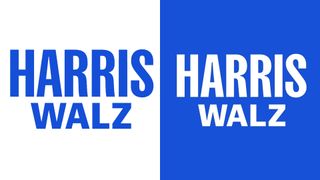
According to Fast Company , design team Wide Eye had no forewarning of Kamala's new running mate, conceptualising eight individual designs for each potential candidate. With tight deadlines in an already chaotic presidential campaign train, some design hitches were only natural.
The revised design has a bolder, more authoritative feel thanks to a humble bit of kerning. Highlighted by Type designer Jonathan Hoefler on Threads , the new logo irons out visual impurities like letter height and centring, balancing the crossbar of the letter 'H', making subtle amendments to the 'R's and harmonising the height of 'Walz' to complement the Harris wordmark.
Post by @jonathanhoefler View on Threads
"Campaign typography is *completely* unlike graphic design: it’s a strange and fascinating agility sport, marked by limited information, a ticking clock, unimaginable pressures, and serious consequences. It’s Iron Chef, but in Adobe Illustrator ," Jonathan writes.
Had it not been highlighted, I may not have even noticed the minor design tweaks, but now I can't unsee how unbalanced the old logo was. It goes to show that simplistic design benefits from precision and refinement – making an already strong logo into a powerful, scaleable and iconic design. For more campaign news, check out Kamala Harris' Brat summer branding and the remarkable story of how she built a presidency-ready brand in 24 hours .
Get the Creative Bloq Newsletter
Daily design news, reviews, how-tos and more, as picked by the editors.
Thank you for reading 5 articles this month* Join now for unlimited access
Enjoy your first month for just £1 / $1 / €1
*Read 5 free articles per month without a subscription
Join now for unlimited access
Try first month for just £1 / $1 / €1
Natalie is Creative Bloq's staff writer. With an eye for trending topics and a passion for internet culture, she brings you the latest in art and design news. A recent English Literature graduate, Natalie enjoys covering the lighter side of the news and brings a fresh and fun take to her articles. Outside of work (if she’s not glued to her phone), she loves all things music and enjoys singing sweet folky tunes.
Related articles
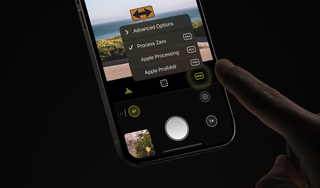
- 2 The best fonts in Canva, definitively
- 3 VR Trombone Champ looks as weirdly hilarious as the original
- 4 Two of the best laptops I've ever reviewed are on sale right now
- 5 ASUS ProArt P16 review: like a MacBook Pro, but better

IMAGES
COMMENTS
12 Architect Cover Letter Examples. Architects meticulously design structures that are not only aesthetically pleasing but also functional and enduring, blending creativity with practicality. Similarly, your cover letter is your blueprint to showcase your professional journey, combining your creative vision, technical skills, and enduring ...
Architect Cover Letter Example and Template for 2024. An architect is an engineering professional who plans and designs physical structures where people work, live, dine and socialize. If you have an interest in a career that combines art with science and allows you to be both highly creative and detailed, you might consider a job as an architect.
Top ↑ Architect Cover Letter Example 5 Steps for the Perfect Architecture Cover Letter #1. Put Contact Information in the Header #2. Address the Hiring Manager #3. Write an Eye-Catching Opening Statement #4. Use the Cover Letter Body for the Details #5.
As an Architect, your cover letter introduction should immediately highlight your creative vision and technical expertise. Begin with a brief example of a project where your innovative design and practical application of architectural principles led to a successful outcome. Make sure to align your skills with the job requirements, such as ...
Closing paragraph; Signature (this one is up to you). Remember to use the same modern, simple font for your architect cover letter as you did for your resume (e.g. Lato, Rubik, etc.) Ensure your architect cover letter is single-spaced and is wrapped around a one-inch margin, like in our cover letter templates.
5 Architecture Cover Letter. Examples Designed for 2024. Stephen Greet July 5, 2024. Where beauty meets function, you're there: You ensure the structural integrity of each building and the code compliance of each gorgeous landscape. You might work on blueprints and contracts or be on-site supervising the execution of your carefully-developed ...
Architecture Cover Letter Tips. Architects design homes, office buildings, and other large structures. If you're a creative thinker who's proficient in industrial design, your skills are valuable to architecture firms. But first, you need to showcase your architectural abilities by crafting a strong cover letter that outlines your ...
Use a professional format. Make sure your cover letter is easy to read and follows a professional format. Use a standard font and size, and include your contact information and a professional greeting and closing. 5. Proofread and edit. Take the time to proofread and edit your cover letter before submitting it.
Architect cover letter example. Use this Architect cover letter example to finish your application and get hired fast - no frustration, no guesswork. This cover letter example is specifically designed for Architect positions in 2024. Take advantage of our sample sentences + expert guides to download the perfect cover letter in just minutes. 4.8.
Your cover letter should be one pagelong. It should have between 3 and 5 paragraphs or 250-400 words. You want a clean, cover letter-friendly font(e.g., Arial, Calibri, or Helvetica). The font size should be 10-12 pt. Set margins to one inchand include proportional white space between sections and paragraphs.
1. Keep it short. Take just the right amount of space to specify the things that you can offer to the organization. Avoid going overboard with superfluous words and too much information. To demonstrate your ability to communicate effectively, you should focus on writing a compelling and concise cover letter.
A strong architect cover letter should go beyond rewriting your resume in a letter format and should instead use the space to elevate the content of your resume and form a connection with your employer. ... Your job description indicates your desire for successful candidates to have a creative mind and two years of hands-on experience in the ...
Senior Architect Cover Letter Example. Dear Mr. Patel, When I learned about the Senior Architect position at Perkins+Will, I knew I had to apply. Your firm's commitment to designing spaces that promote human wellbeing and connection to nature resonates deeply with my own approach to architecture.
This architecture cover letter guide will show you: Architecture cover letter examples better than 9 out of 10 others. How to write a perfect cover letter architecture design firms love. Tips on how to grab their attention with a professional architectural cover letter. Architecture cover letter examples to gain a lot of inspiration.
Template 1. Hi Elena, I am excited to apply for the Architect position at your architecture firm. With 11+ years of experience as a RBA Certified Architect, I possess a strong background in commercial and residential projects, coupled with a passion for sustainable design and a keen eye for detail.
When you write a cover letter for architecture fresh graduate roles, you still concentrate on relevant parts of your experience. You may be talking about your second-best project rather than your first, but it is what the recruiter wants that matters. 2. Be Brief. Your recruiter is a busy person.
Best Cover Letter Greetings: In your cover letter greeting, strive for professionalism and personalization. If you know the hiring manager's name, use it; if not, address the company or department as a whole. 1\. "Dear Hiring Team at [Company Name]," 2\. "Greetings [Company Name] Architecture Department," 3\. "Hello [Hiring Manager's Name],"
Creative Cover Letter for Architecture Job Example. Dear [Recipient's Name], As an Architect with a flair for creative design solutions, I am thrilled to apply for the [Position Name] at [Company Name]. My portfolio showcases unique and thoughtful designs that prioritize both aesthetics and functionality.
Instead, focus on the most important details, such as your relevant skills and experiences, and why you're interested in the position. By keeping your cover letter concise and to the point, you'll increase the chances that the hiring manager or recruiter will take the time to read it and consider you for the position.
555-555-5555. [email protected]. APE Construction, Inc. Windsor, CT, United States. 11/10/2019. Application for the position of Assistant Architect. Dear Hiring Manager, I am excited to express my interest in the Assistant Architect position at your esteemed company.
Consider following these steps to write your cover letter: 1. Research the company. While writing a creative letter can distinguish you from other candidates, making sure your letter fits the corporate culture of the business you're applying to ensures that you remain a valid candidate. Some companies welcome cover letters with graphics, humor ...
EDIT THIS COVER LETTER TEMPLATE. Design Pro Tip: Use our photo replace feature to quickly add your own headshot to your cover letter. The Venngage online drag and drop editor lets you quickly upload your photo and drag it over the existing headshot. The tool will replace and resize for you.
12. Resume / CV Design Template. This creative cover letter template comes with a space for your personal information, which is quite an interesting approach. And it still leaves a lot of room for your message! With some orange touches and a big name in a black rectangle at the top, it makes your application unmissable for any recruiter!
Chant this mantra when composing your cover letter be clear, be brief, be specific. The document needs to be compelling to read at a glance, so you must think carefully about word choice and be direct in asking what you want. Three is also a good number of paragraphs to target (four is the limit). Nix To Whom it May Concern.
Behance is the world's largest creative network for showcasing and discovering creative resume work ... Grafixhubs_1: I will make design, write, update your resume, cv and cover letter for $10 on fiverr.com. Grafixhubs_1. Cv Design Graphique. Curriculum Vitae Creative. Curriculum Template. Cv Design Creative.
The design gives important information first so that clients can understand how Asana can help them manage their projects and taste efficiency. There is also a personalization element, where recommendations are made based on the user's needs. 18. Give personalization like Tailor Brands.
Others call it creative Created between the 1950s and 1970s, brutalist buildings are defined by its use of exposed concrete and a minimalist design. Many people hate brutalism, though architects ...
What this portfolio lacks in information it makes up for in stunning presentation (Image credit: Ro and Co). Founded by creative director Roanne Adams, NYC-based RoAndCo offers beautifully crafted design, branding and creative direction to clients in fashion, beauty, tech and lifestyle. Viewing RoAndCo's portfolio is an experience in itself, in keeping with the studio's work ethos.
The Royals produced 13 hits in the game. Witt finished 3-for-4 and added a single and double to his ledger. He became the third player in Royals history to have multiple seasons of at least 25 ...
The revised design has a bolder, more authoritative feel thanks to a humble bit of kerning. Highlighted by Type designer Jonathan Hoefler on Threads , the new logo irons out visual impurities like letter height and centring, balancing the crossbar of the letter 'H', making subtle amendments to the 'R's and harmonising the height of 'Walz' to ...